Impact of Crude Oil Transportation on Tanker Market
VerifiedAdded on 2023/02/01
|40
|11230
|23
AI Summary
This dissertation explores the impact of different methods of crude oil transportation on the tanker market. It analyzes the advantages and disadvantages of alternative methods and examines the future trade rates of crude oil. The study also investigates the impact of environmental policies on crude oil transportation and provides findings and recommendations for improving transportation strategies.
Contribute Materials
Your contribution can guide someone’s learning journey. Share your
documents today.
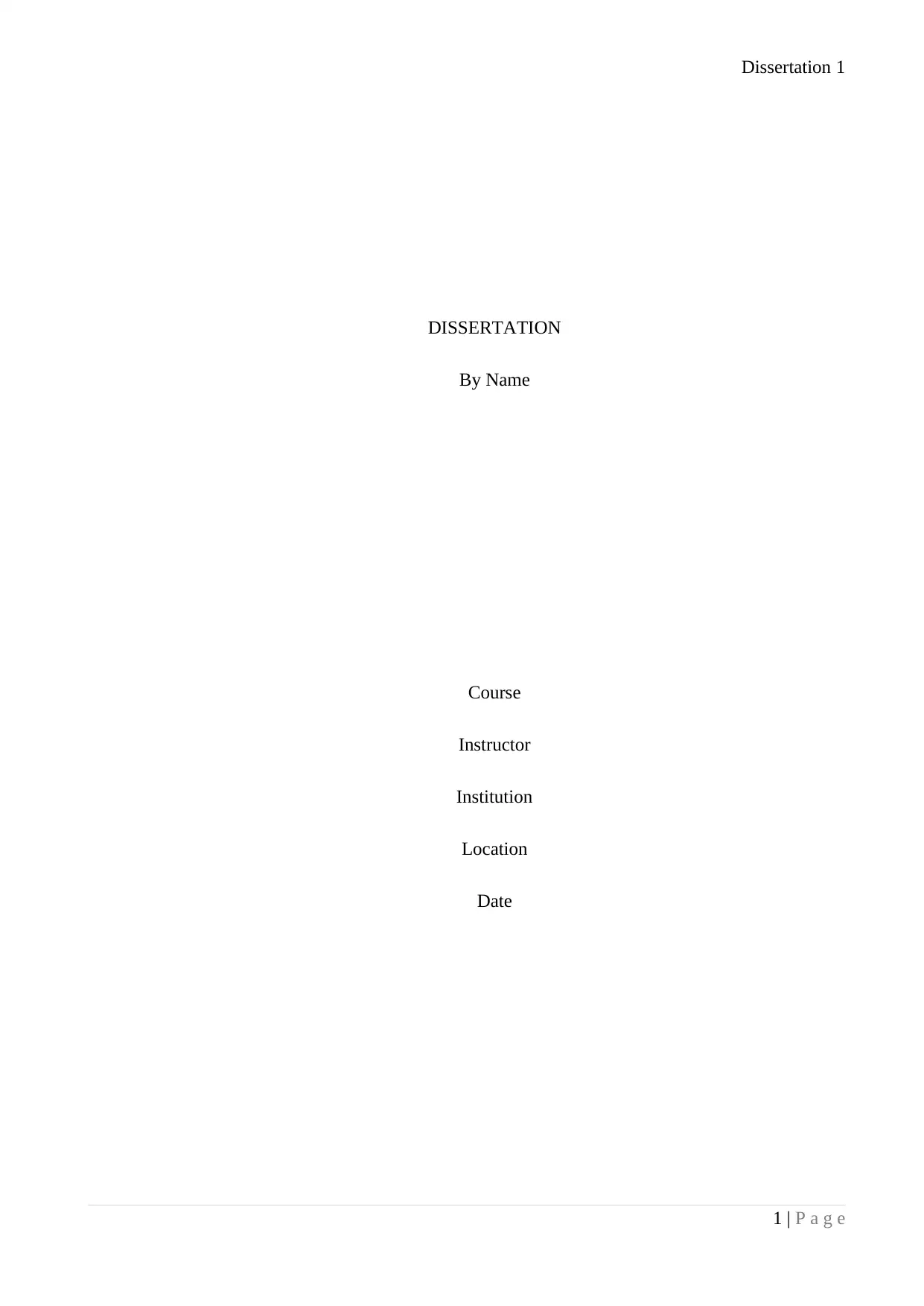
Dissertation 1
DISSERTATION
By Name
Course
Instructor
Institution
Location
Date
1 | P a g e
DISSERTATION
By Name
Course
Instructor
Institution
Location
Date
1 | P a g e
Secure Best Marks with AI Grader
Need help grading? Try our AI Grader for instant feedback on your assignments.
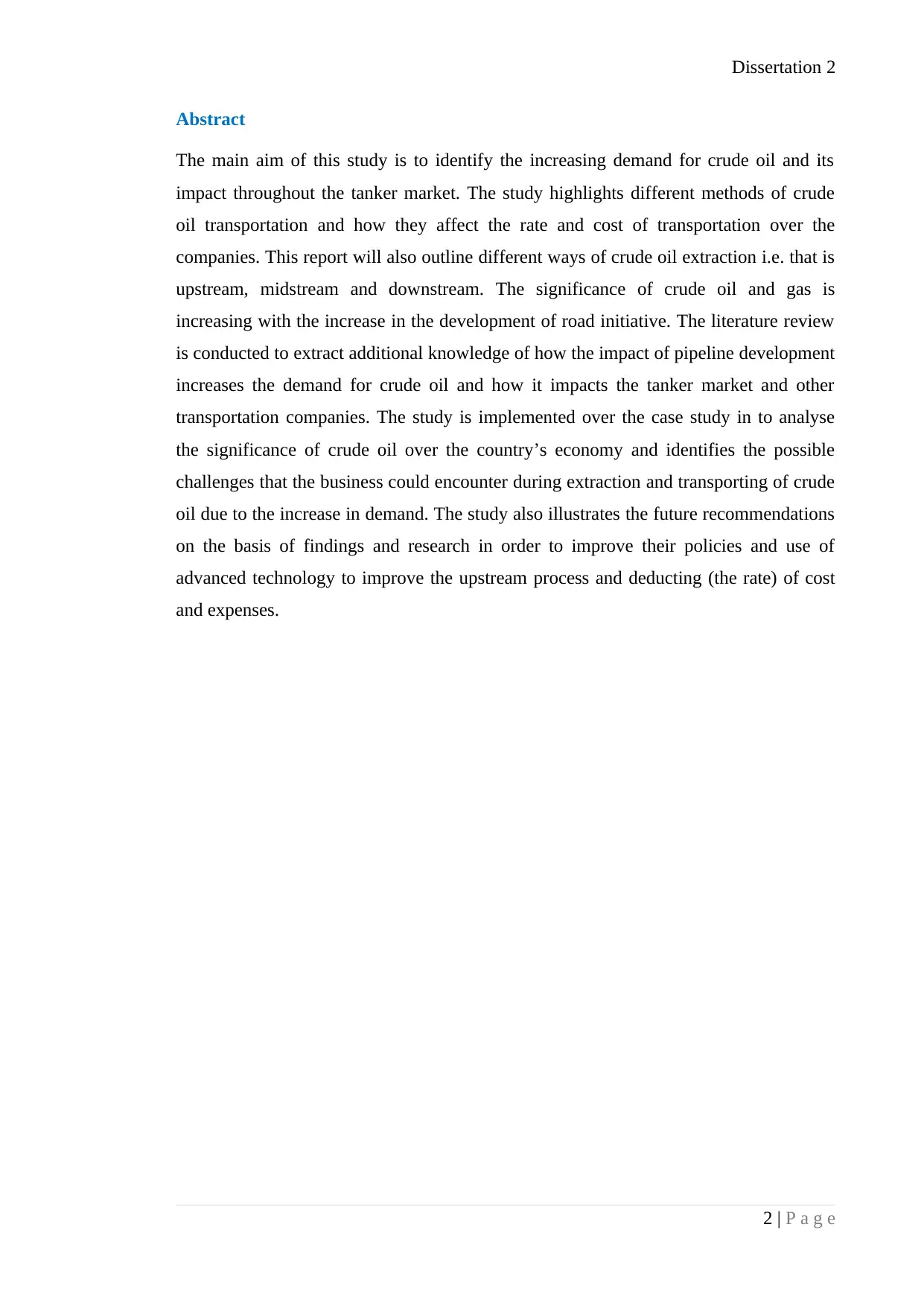
Dissertation 2
Abstract
The main aim of this study is to identify the increasing demand for crude oil and its
impact throughout the tanker market. The study highlights different methods of crude
oil transportation and how they affect the rate and cost of transportation over the
companies. This report will also outline different ways of crude oil extraction i.e. that is
upstream, midstream and downstream. The significance of crude oil and gas is
increasing with the increase in the development of road initiative. The literature review
is conducted to extract additional knowledge of how the impact of pipeline development
increases the demand for crude oil and how it impacts the tanker market and other
transportation companies. The study is implemented over the case study in to analyse
the significance of crude oil over the country’s economy and identifies the possible
challenges that the business could encounter during extraction and transporting of crude
oil due to the increase in demand. The study also illustrates the future recommendations
on the basis of findings and research in order to improve their policies and use of
advanced technology to improve the upstream process and deducting (the rate) of cost
and expenses.
2 | P a g e
Abstract
The main aim of this study is to identify the increasing demand for crude oil and its
impact throughout the tanker market. The study highlights different methods of crude
oil transportation and how they affect the rate and cost of transportation over the
companies. This report will also outline different ways of crude oil extraction i.e. that is
upstream, midstream and downstream. The significance of crude oil and gas is
increasing with the increase in the development of road initiative. The literature review
is conducted to extract additional knowledge of how the impact of pipeline development
increases the demand for crude oil and how it impacts the tanker market and other
transportation companies. The study is implemented over the case study in to analyse
the significance of crude oil over the country’s economy and identifies the possible
challenges that the business could encounter during extraction and transporting of crude
oil due to the increase in demand. The study also illustrates the future recommendations
on the basis of findings and research in order to improve their policies and use of
advanced technology to improve the upstream process and deducting (the rate) of cost
and expenses.
2 | P a g e
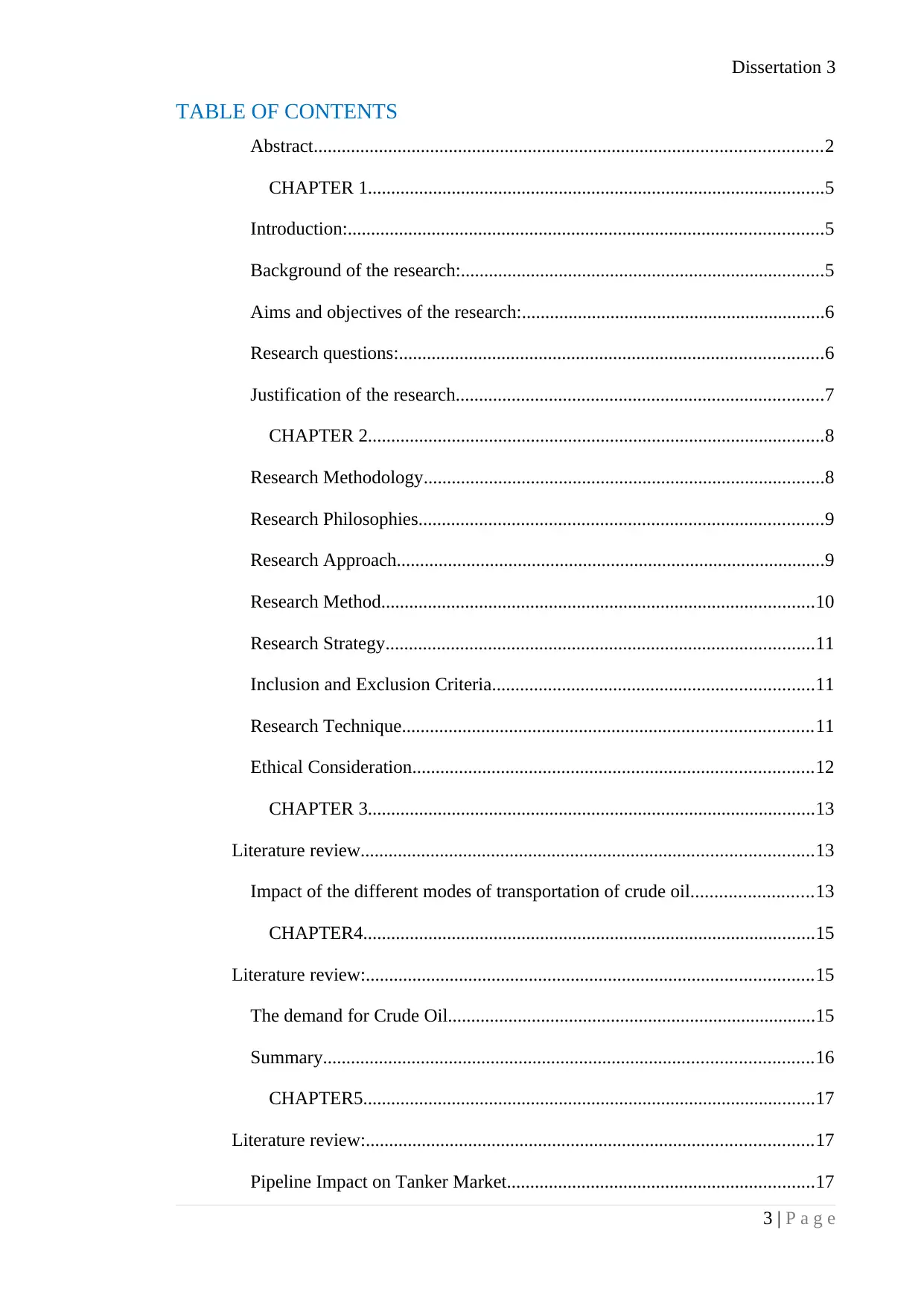
Dissertation 3
TABLE OF CONTENTS
Abstract.............................................................................................................2
CHAPTER 1..................................................................................................5
Introduction:......................................................................................................5
Background of the research:..............................................................................5
Aims and objectives of the research:.................................................................6
Research questions:...........................................................................................6
Justification of the research...............................................................................7
CHAPTER 2..................................................................................................8
Research Methodology......................................................................................8
Research Philosophies.......................................................................................9
Research Approach............................................................................................9
Research Method.............................................................................................10
Research Strategy............................................................................................11
Inclusion and Exclusion Criteria.....................................................................11
Research Technique........................................................................................11
Ethical Consideration......................................................................................12
CHAPTER 3................................................................................................13
Literature review.................................................................................................13
Impact of the different modes of transportation of crude oil..........................13
CHAPTER4.................................................................................................15
Literature review:................................................................................................15
The demand for Crude Oil...............................................................................15
Summary.........................................................................................................16
CHAPTER5.................................................................................................17
Literature review:................................................................................................17
Pipeline Impact on Tanker Market..................................................................17
3 | P a g e
TABLE OF CONTENTS
Abstract.............................................................................................................2
CHAPTER 1..................................................................................................5
Introduction:......................................................................................................5
Background of the research:..............................................................................5
Aims and objectives of the research:.................................................................6
Research questions:...........................................................................................6
Justification of the research...............................................................................7
CHAPTER 2..................................................................................................8
Research Methodology......................................................................................8
Research Philosophies.......................................................................................9
Research Approach............................................................................................9
Research Method.............................................................................................10
Research Strategy............................................................................................11
Inclusion and Exclusion Criteria.....................................................................11
Research Technique........................................................................................11
Ethical Consideration......................................................................................12
CHAPTER 3................................................................................................13
Literature review.................................................................................................13
Impact of the different modes of transportation of crude oil..........................13
CHAPTER4.................................................................................................15
Literature review:................................................................................................15
The demand for Crude Oil...............................................................................15
Summary.........................................................................................................16
CHAPTER5.................................................................................................17
Literature review:................................................................................................17
Pipeline Impact on Tanker Market..................................................................17
3 | P a g e
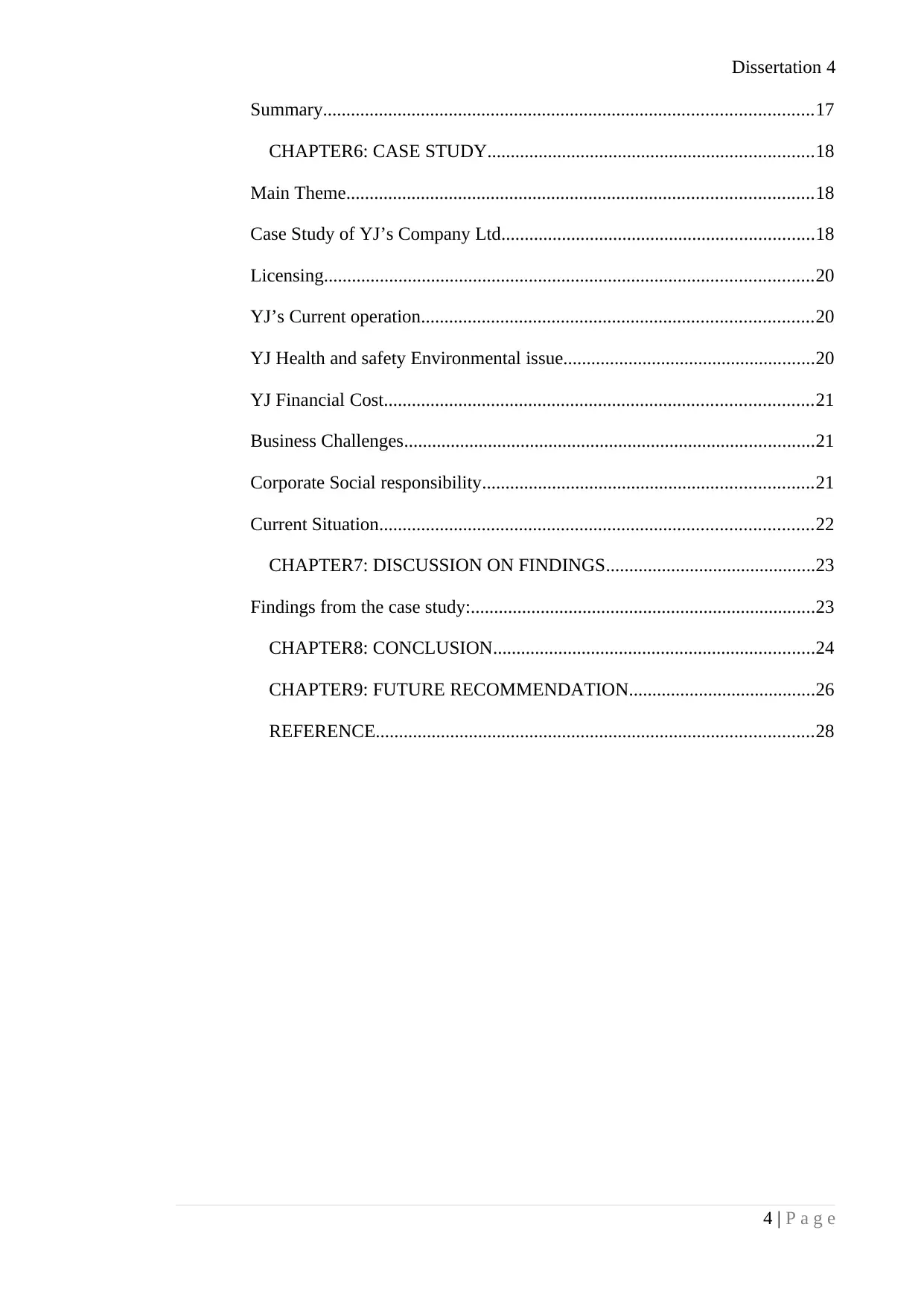
Dissertation 4
Summary.........................................................................................................17
CHAPTER6: CASE STUDY......................................................................18
Main Theme....................................................................................................18
Case Study of YJ’s Company Ltd...................................................................18
Licensing.........................................................................................................20
YJ’s Current operation....................................................................................20
YJ Health and safety Environmental issue......................................................20
YJ Financial Cost............................................................................................21
Business Challenges........................................................................................21
Corporate Social responsibility.......................................................................21
Current Situation.............................................................................................22
CHAPTER7: DISCUSSION ON FINDINGS.............................................23
Findings from the case study:..........................................................................23
CHAPTER8: CONCLUSION.....................................................................24
CHAPTER9: FUTURE RECOMMENDATION........................................26
REFERENCE..............................................................................................28
4 | P a g e
Summary.........................................................................................................17
CHAPTER6: CASE STUDY......................................................................18
Main Theme....................................................................................................18
Case Study of YJ’s Company Ltd...................................................................18
Licensing.........................................................................................................20
YJ’s Current operation....................................................................................20
YJ Health and safety Environmental issue......................................................20
YJ Financial Cost............................................................................................21
Business Challenges........................................................................................21
Corporate Social responsibility.......................................................................21
Current Situation.............................................................................................22
CHAPTER7: DISCUSSION ON FINDINGS.............................................23
Findings from the case study:..........................................................................23
CHAPTER8: CONCLUSION.....................................................................24
CHAPTER9: FUTURE RECOMMENDATION........................................26
REFERENCE..............................................................................................28
4 | P a g e
Secure Best Marks with AI Grader
Need help grading? Try our AI Grader for instant feedback on your assignments.
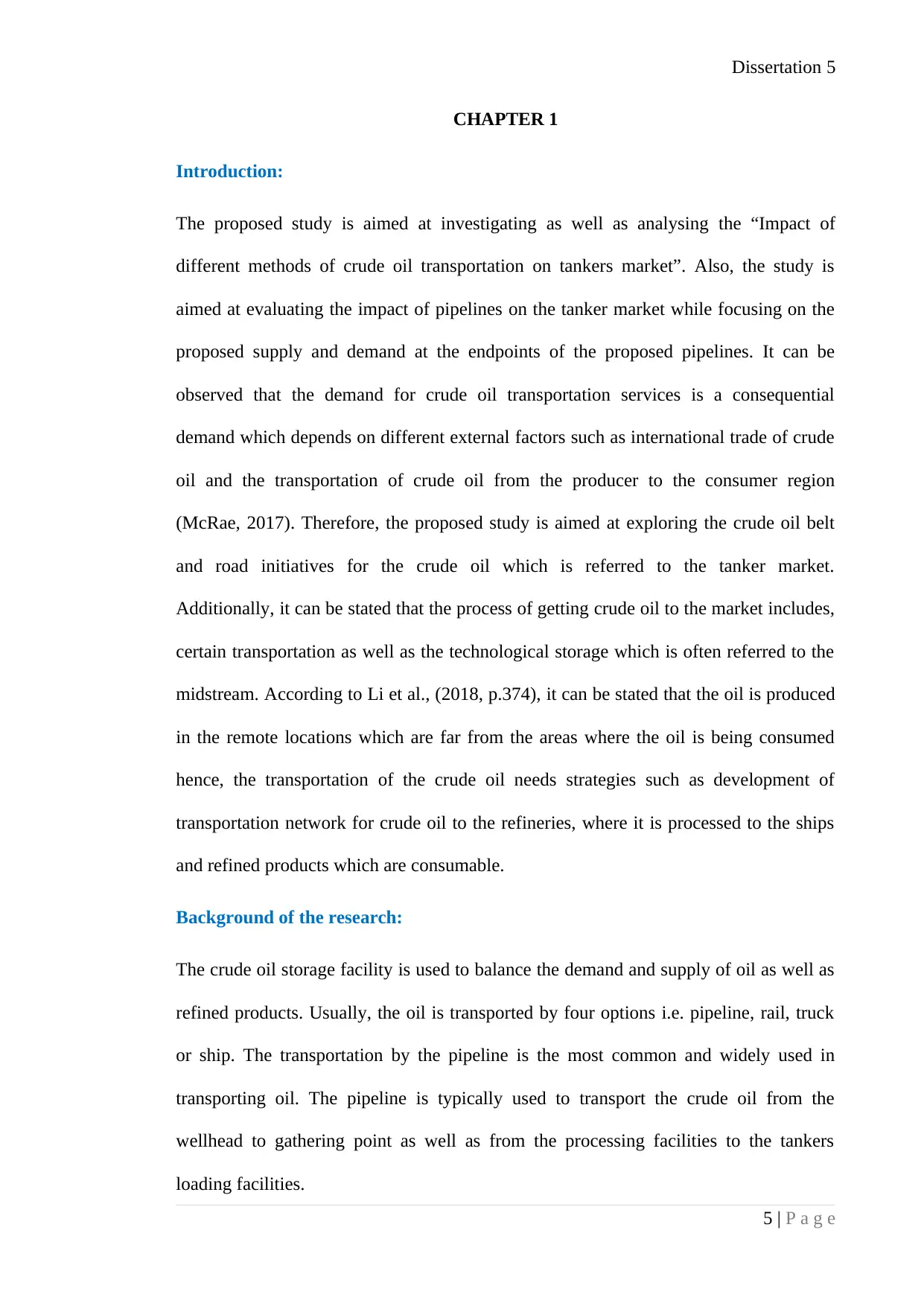
Dissertation 5
CHAPTER 1
Introduction:
The proposed study is aimed at investigating as well as analysing the “Impact of
different methods of crude oil transportation on tankers market”. Also, the study is
aimed at evaluating the impact of pipelines on the tanker market while focusing on the
proposed supply and demand at the endpoints of the proposed pipelines. It can be
observed that the demand for crude oil transportation services is a consequential
demand which depends on different external factors such as international trade of crude
oil and the transportation of crude oil from the producer to the consumer region
(McRae, 2017). Therefore, the proposed study is aimed at exploring the crude oil belt
and road initiatives for the crude oil which is referred to the tanker market.
Additionally, it can be stated that the process of getting crude oil to the market includes,
certain transportation as well as the technological storage which is often referred to the
midstream. According to Li et al., (2018, p.374), it can be stated that the oil is produced
in the remote locations which are far from the areas where the oil is being consumed
hence, the transportation of the crude oil needs strategies such as development of
transportation network for crude oil to the refineries, where it is processed to the ships
and refined products which are consumable.
Background of the research:
The crude oil storage facility is used to balance the demand and supply of oil as well as
refined products. Usually, the oil is transported by four options i.e. pipeline, rail, truck
or ship. The transportation by the pipeline is the most common and widely used in
transporting oil. The pipeline is typically used to transport the crude oil from the
wellhead to gathering point as well as from the processing facilities to the tankers
loading facilities.
5 | P a g e
CHAPTER 1
Introduction:
The proposed study is aimed at investigating as well as analysing the “Impact of
different methods of crude oil transportation on tankers market”. Also, the study is
aimed at evaluating the impact of pipelines on the tanker market while focusing on the
proposed supply and demand at the endpoints of the proposed pipelines. It can be
observed that the demand for crude oil transportation services is a consequential
demand which depends on different external factors such as international trade of crude
oil and the transportation of crude oil from the producer to the consumer region
(McRae, 2017). Therefore, the proposed study is aimed at exploring the crude oil belt
and road initiatives for the crude oil which is referred to the tanker market.
Additionally, it can be stated that the process of getting crude oil to the market includes,
certain transportation as well as the technological storage which is often referred to the
midstream. According to Li et al., (2018, p.374), it can be stated that the oil is produced
in the remote locations which are far from the areas where the oil is being consumed
hence, the transportation of the crude oil needs strategies such as development of
transportation network for crude oil to the refineries, where it is processed to the ships
and refined products which are consumable.
Background of the research:
The crude oil storage facility is used to balance the demand and supply of oil as well as
refined products. Usually, the oil is transported by four options i.e. pipeline, rail, truck
or ship. The transportation by the pipeline is the most common and widely used in
transporting oil. The pipeline is typically used to transport the crude oil from the
wellhead to gathering point as well as from the processing facilities to the tankers
loading facilities.
5 | P a g e

Dissertation 6
According to Regli and Adland, (2019, p.100) the strategy of transporting oil by
pipeline, the technology requires significantly less energy to transport the oil as
compared to transportation by the trucks and rails. The use of pipeline transportation
also has a lower carbon footprint. The trend of the shipment of crude oil by the train had
become a growing phenomenon for the oil reserves all the world. The transportation of
the oil by use of train is preferred because it is cost effective and it is considered to be
convenient for long distance transportation of crude oil, as compared to the
transportation to pipelines transportation. Even though there are many benefits
associated with the use trains there are also set backs which are associated with train
transportation such as, carbon emission, low speed, and accidents.
The transportation of crude oil by truck is a limited method such as by the help of truck
a limited amount of crude oil can be transported. In the transportation of crude oil
transportation by use of trucks, it is considered to be the last option to be used in
transporting oil as well and refined petroleum products. Nevertheless, the transportation
of crude oil by ship is preferred in areas where transportation of crude oil by land is not
suitable. It can be observed that “typically 30,000- barrel tank barge can transport or
carry crude oil equivalent to the amount of crude oil transported by 45 rail tanks, at
about one-third of the cost.” According to the study of Sun et al., (2018, p.174) it can be
stated that the transportation of crude oil by the barges is approximately 25 to 30%
cheap as compared to the transportation of crude oil by pipeline. The setbacks
associated with the transportation of the crude oil by the ships, tanks, and rail are
environmental concerns because the shipment by the barges usually carries natural gas
feedstock to the chemical plants and petrochemicals which can be impacted by the
environmental factors.
6 | P a g e
According to Regli and Adland, (2019, p.100) the strategy of transporting oil by
pipeline, the technology requires significantly less energy to transport the oil as
compared to transportation by the trucks and rails. The use of pipeline transportation
also has a lower carbon footprint. The trend of the shipment of crude oil by the train had
become a growing phenomenon for the oil reserves all the world. The transportation of
the oil by use of train is preferred because it is cost effective and it is considered to be
convenient for long distance transportation of crude oil, as compared to the
transportation to pipelines transportation. Even though there are many benefits
associated with the use trains there are also set backs which are associated with train
transportation such as, carbon emission, low speed, and accidents.
The transportation of crude oil by truck is a limited method such as by the help of truck
a limited amount of crude oil can be transported. In the transportation of crude oil
transportation by use of trucks, it is considered to be the last option to be used in
transporting oil as well and refined petroleum products. Nevertheless, the transportation
of crude oil by ship is preferred in areas where transportation of crude oil by land is not
suitable. It can be observed that “typically 30,000- barrel tank barge can transport or
carry crude oil equivalent to the amount of crude oil transported by 45 rail tanks, at
about one-third of the cost.” According to the study of Sun et al., (2018, p.174) it can be
stated that the transportation of crude oil by the barges is approximately 25 to 30%
cheap as compared to the transportation of crude oil by pipeline. The setbacks
associated with the transportation of the crude oil by the ships, tanks, and rail are
environmental concerns because the shipment by the barges usually carries natural gas
feedstock to the chemical plants and petrochemicals which can be impacted by the
environmental factors.
6 | P a g e
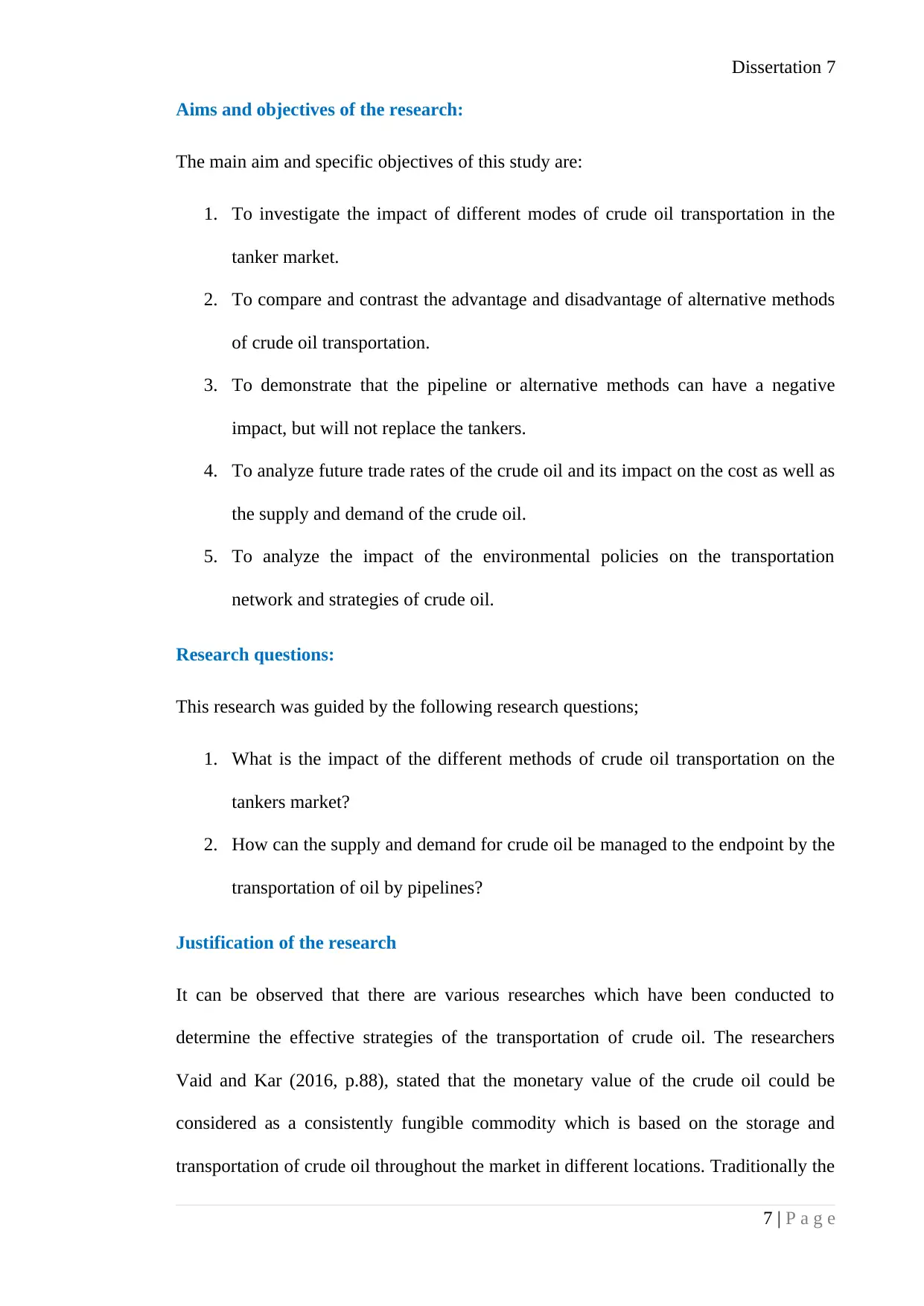
Dissertation 7
Aims and objectives of the research:
The main aim and specific objectives of this study are:
1. To investigate the impact of different modes of crude oil transportation in the
tanker market.
2. To compare and contrast the advantage and disadvantage of alternative methods
of crude oil transportation.
3. To demonstrate that the pipeline or alternative methods can have a negative
impact, but will not replace the tankers.
4. To analyze future trade rates of the crude oil and its impact on the cost as well as
the supply and demand of the crude oil.
5. To analyze the impact of the environmental policies on the transportation
network and strategies of crude oil.
Research questions:
This research was guided by the following research questions;
1. What is the impact of the different methods of crude oil transportation on the
tankers market?
2. How can the supply and demand for crude oil be managed to the endpoint by the
transportation of oil by pipelines?
Justification of the research
It can be observed that there are various researches which have been conducted to
determine the effective strategies of the transportation of crude oil. The researchers
Vaid and Kar (2016, p.88), stated that the monetary value of the crude oil could be
considered as a consistently fungible commodity which is based on the storage and
transportation of crude oil throughout the market in different locations. Traditionally the
7 | P a g e
Aims and objectives of the research:
The main aim and specific objectives of this study are:
1. To investigate the impact of different modes of crude oil transportation in the
tanker market.
2. To compare and contrast the advantage and disadvantage of alternative methods
of crude oil transportation.
3. To demonstrate that the pipeline or alternative methods can have a negative
impact, but will not replace the tankers.
4. To analyze future trade rates of the crude oil and its impact on the cost as well as
the supply and demand of the crude oil.
5. To analyze the impact of the environmental policies on the transportation
network and strategies of crude oil.
Research questions:
This research was guided by the following research questions;
1. What is the impact of the different methods of crude oil transportation on the
tankers market?
2. How can the supply and demand for crude oil be managed to the endpoint by the
transportation of oil by pipelines?
Justification of the research
It can be observed that there are various researches which have been conducted to
determine the effective strategies of the transportation of crude oil. The researchers
Vaid and Kar (2016, p.88), stated that the monetary value of the crude oil could be
considered as a consistently fungible commodity which is based on the storage and
transportation of crude oil throughout the market in different locations. Traditionally the
7 | P a g e
Paraphrase This Document
Need a fresh take? Get an instant paraphrase of this document with our AI Paraphraser
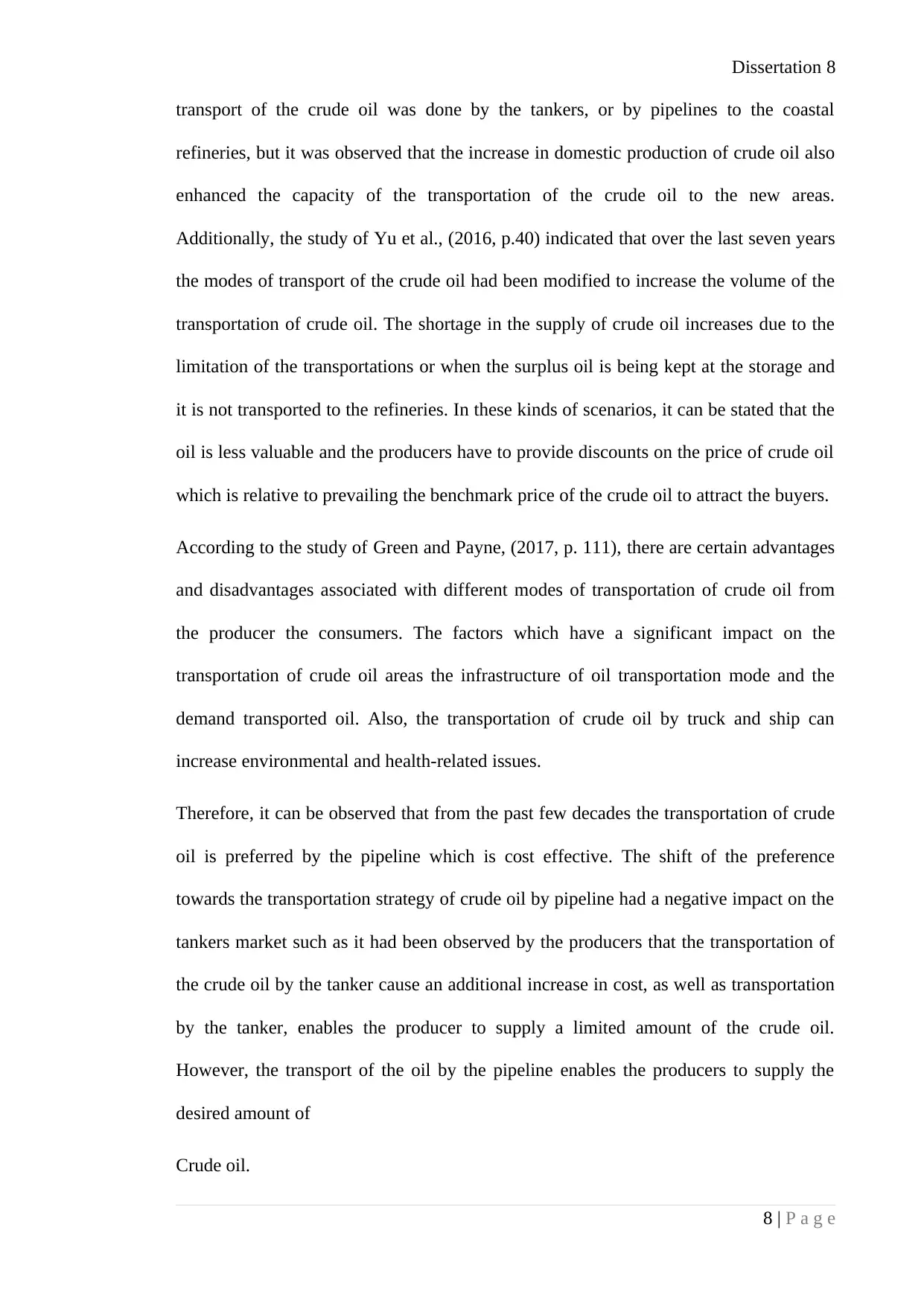
Dissertation 8
transport of the crude oil was done by the tankers, or by pipelines to the coastal
refineries, but it was observed that the increase in domestic production of crude oil also
enhanced the capacity of the transportation of the crude oil to the new areas.
Additionally, the study of Yu et al., (2016, p.40) indicated that over the last seven years
the modes of transport of the crude oil had been modified to increase the volume of the
transportation of crude oil. The shortage in the supply of crude oil increases due to the
limitation of the transportations or when the surplus oil is being kept at the storage and
it is not transported to the refineries. In these kinds of scenarios, it can be stated that the
oil is less valuable and the producers have to provide discounts on the price of crude oil
which is relative to prevailing the benchmark price of the crude oil to attract the buyers.
According to the study of Green and Payne, (2017, p. 111), there are certain advantages
and disadvantages associated with different modes of transportation of crude oil from
the producer the consumers. The factors which have a significant impact on the
transportation of crude oil areas the infrastructure of oil transportation mode and the
demand transported oil. Also, the transportation of crude oil by truck and ship can
increase environmental and health-related issues.
Therefore, it can be observed that from the past few decades the transportation of crude
oil is preferred by the pipeline which is cost effective. The shift of the preference
towards the transportation strategy of crude oil by pipeline had a negative impact on the
tankers market such as it had been observed by the producers that the transportation of
the crude oil by the tanker cause an additional increase in cost, as well as transportation
by the tanker, enables the producer to supply a limited amount of the crude oil.
However, the transport of the oil by the pipeline enables the producers to supply the
desired amount of
Crude oil.
8 | P a g e
transport of the crude oil was done by the tankers, or by pipelines to the coastal
refineries, but it was observed that the increase in domestic production of crude oil also
enhanced the capacity of the transportation of the crude oil to the new areas.
Additionally, the study of Yu et al., (2016, p.40) indicated that over the last seven years
the modes of transport of the crude oil had been modified to increase the volume of the
transportation of crude oil. The shortage in the supply of crude oil increases due to the
limitation of the transportations or when the surplus oil is being kept at the storage and
it is not transported to the refineries. In these kinds of scenarios, it can be stated that the
oil is less valuable and the producers have to provide discounts on the price of crude oil
which is relative to prevailing the benchmark price of the crude oil to attract the buyers.
According to the study of Green and Payne, (2017, p. 111), there are certain advantages
and disadvantages associated with different modes of transportation of crude oil from
the producer the consumers. The factors which have a significant impact on the
transportation of crude oil areas the infrastructure of oil transportation mode and the
demand transported oil. Also, the transportation of crude oil by truck and ship can
increase environmental and health-related issues.
Therefore, it can be observed that from the past few decades the transportation of crude
oil is preferred by the pipeline which is cost effective. The shift of the preference
towards the transportation strategy of crude oil by pipeline had a negative impact on the
tankers market such as it had been observed by the producers that the transportation of
the crude oil by the tanker cause an additional increase in cost, as well as transportation
by the tanker, enables the producer to supply a limited amount of the crude oil.
However, the transport of the oil by the pipeline enables the producers to supply the
desired amount of
Crude oil.
8 | P a g e
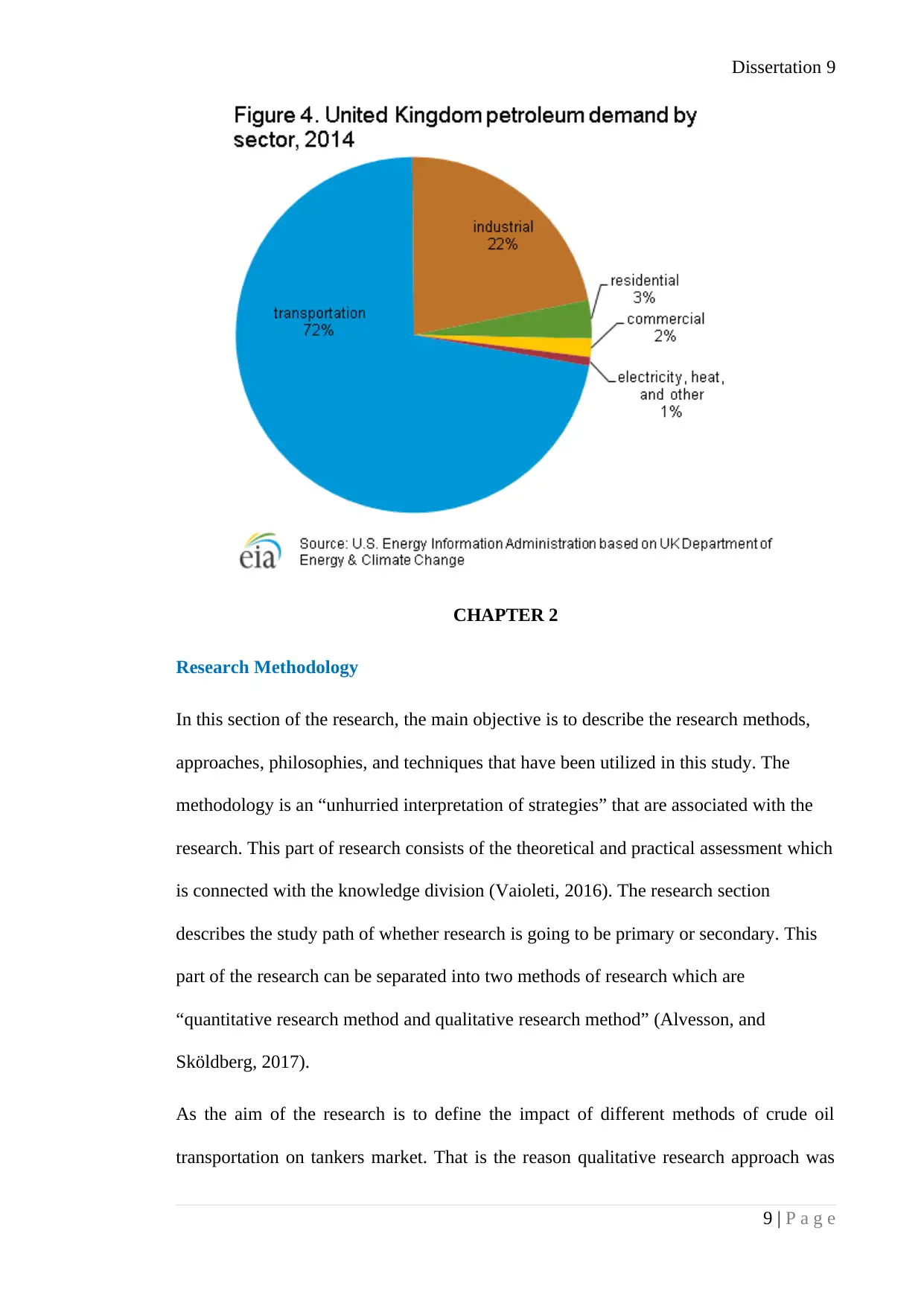
Dissertation 9
CHAPTER 2
Research Methodology
In this section of the research, the main objective is to describe the research methods,
approaches, philosophies, and techniques that have been utilized in this study. The
methodology is an “unhurried interpretation of strategies” that are associated with the
research. This part of research consists of the theoretical and practical assessment which
is connected with the knowledge division (Vaioleti, 2016). The research section
describes the study path of whether research is going to be primary or secondary. This
part of the research can be separated into two methods of research which are
“quantitative research method and qualitative research method” (Alvesson, and
Sköldberg, 2017).
As the aim of the research is to define the impact of different methods of crude oil
transportation on tankers market. That is the reason qualitative research approach was
9 | P a g e
CHAPTER 2
Research Methodology
In this section of the research, the main objective is to describe the research methods,
approaches, philosophies, and techniques that have been utilized in this study. The
methodology is an “unhurried interpretation of strategies” that are associated with the
research. This part of research consists of the theoretical and practical assessment which
is connected with the knowledge division (Vaioleti, 2016). The research section
describes the study path of whether research is going to be primary or secondary. This
part of the research can be separated into two methods of research which are
“quantitative research method and qualitative research method” (Alvesson, and
Sköldberg, 2017).
As the aim of the research is to define the impact of different methods of crude oil
transportation on tankers market. That is the reason qualitative research approach was
9 | P a g e
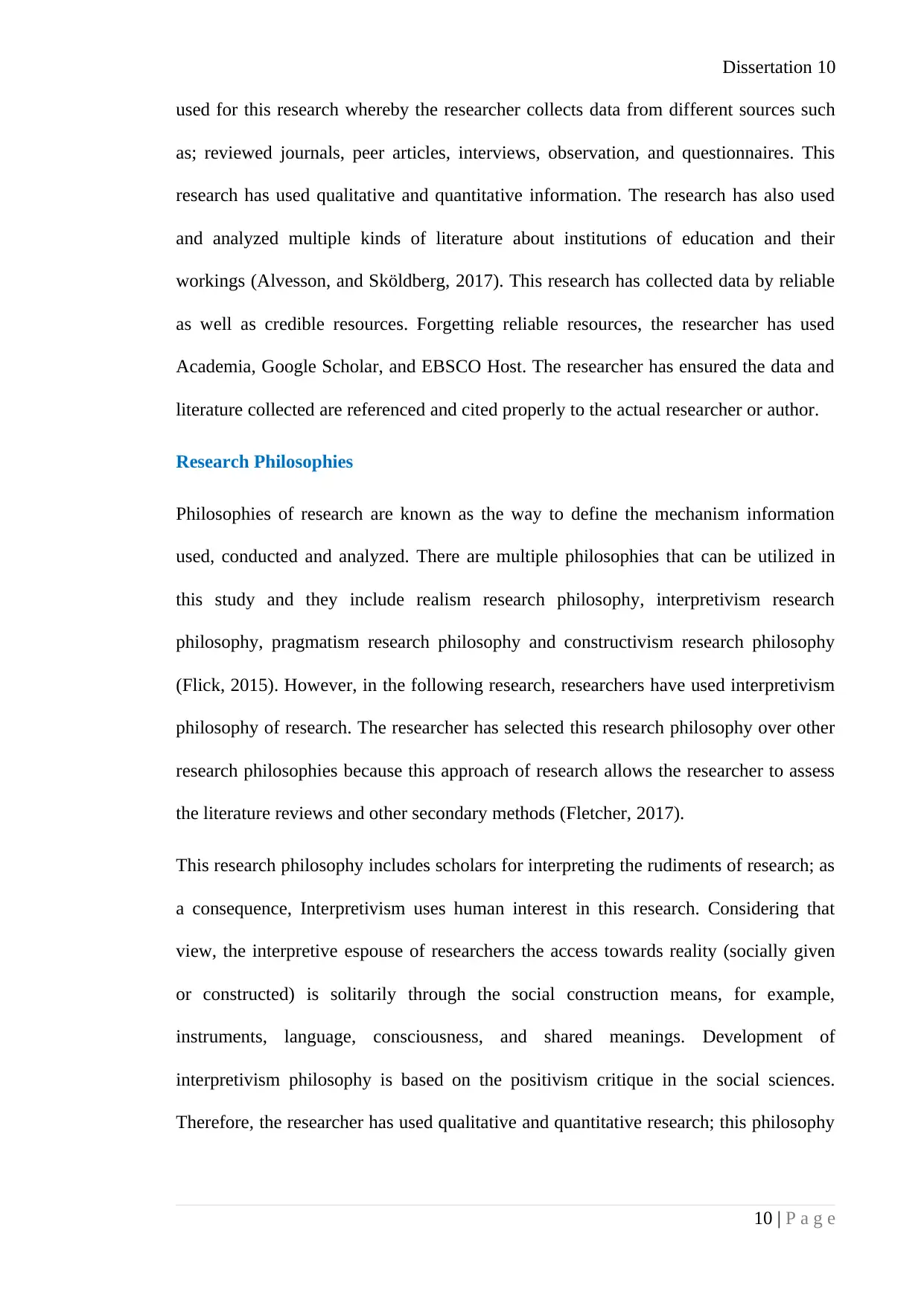
Dissertation 10
used for this research whereby the researcher collects data from different sources such
as; reviewed journals, peer articles, interviews, observation, and questionnaires. This
research has used qualitative and quantitative information. The research has also used
and analyzed multiple kinds of literature about institutions of education and their
workings (Alvesson, and Sköldberg, 2017). This research has collected data by reliable
as well as credible resources. Forgetting reliable resources, the researcher has used
Academia, Google Scholar, and EBSCO Host. The researcher has ensured the data and
literature collected are referenced and cited properly to the actual researcher or author.
Research Philosophies
Philosophies of research are known as the way to define the mechanism information
used, conducted and analyzed. There are multiple philosophies that can be utilized in
this study and they include realism research philosophy, interpretivism research
philosophy, pragmatism research philosophy and constructivism research philosophy
(Flick, 2015). However, in the following research, researchers have used interpretivism
philosophy of research. The researcher has selected this research philosophy over other
research philosophies because this approach of research allows the researcher to assess
the literature reviews and other secondary methods (Fletcher, 2017).
This research philosophy includes scholars for interpreting the rudiments of research; as
a consequence, Interpretivism uses human interest in this research. Considering that
view, the interpretive espouse of researchers the access towards reality (socially given
or constructed) is solitarily through the social construction means, for example,
instruments, language, consciousness, and shared meanings. Development of
interpretivism philosophy is based on the positivism critique in the social sciences.
Therefore, the researcher has used qualitative and quantitative research; this philosophy
10 | P a g e
used for this research whereby the researcher collects data from different sources such
as; reviewed journals, peer articles, interviews, observation, and questionnaires. This
research has used qualitative and quantitative information. The research has also used
and analyzed multiple kinds of literature about institutions of education and their
workings (Alvesson, and Sköldberg, 2017). This research has collected data by reliable
as well as credible resources. Forgetting reliable resources, the researcher has used
Academia, Google Scholar, and EBSCO Host. The researcher has ensured the data and
literature collected are referenced and cited properly to the actual researcher or author.
Research Philosophies
Philosophies of research are known as the way to define the mechanism information
used, conducted and analyzed. There are multiple philosophies that can be utilized in
this study and they include realism research philosophy, interpretivism research
philosophy, pragmatism research philosophy and constructivism research philosophy
(Flick, 2015). However, in the following research, researchers have used interpretivism
philosophy of research. The researcher has selected this research philosophy over other
research philosophies because this approach of research allows the researcher to assess
the literature reviews and other secondary methods (Fletcher, 2017).
This research philosophy includes scholars for interpreting the rudiments of research; as
a consequence, Interpretivism uses human interest in this research. Considering that
view, the interpretive espouse of researchers the access towards reality (socially given
or constructed) is solitarily through the social construction means, for example,
instruments, language, consciousness, and shared meanings. Development of
interpretivism philosophy is based on the positivism critique in the social sciences.
Therefore, the researcher has used qualitative and quantitative research; this philosophy
10 | P a g e
Secure Best Marks with AI Grader
Need help grading? Try our AI Grader for instant feedback on your assignments.
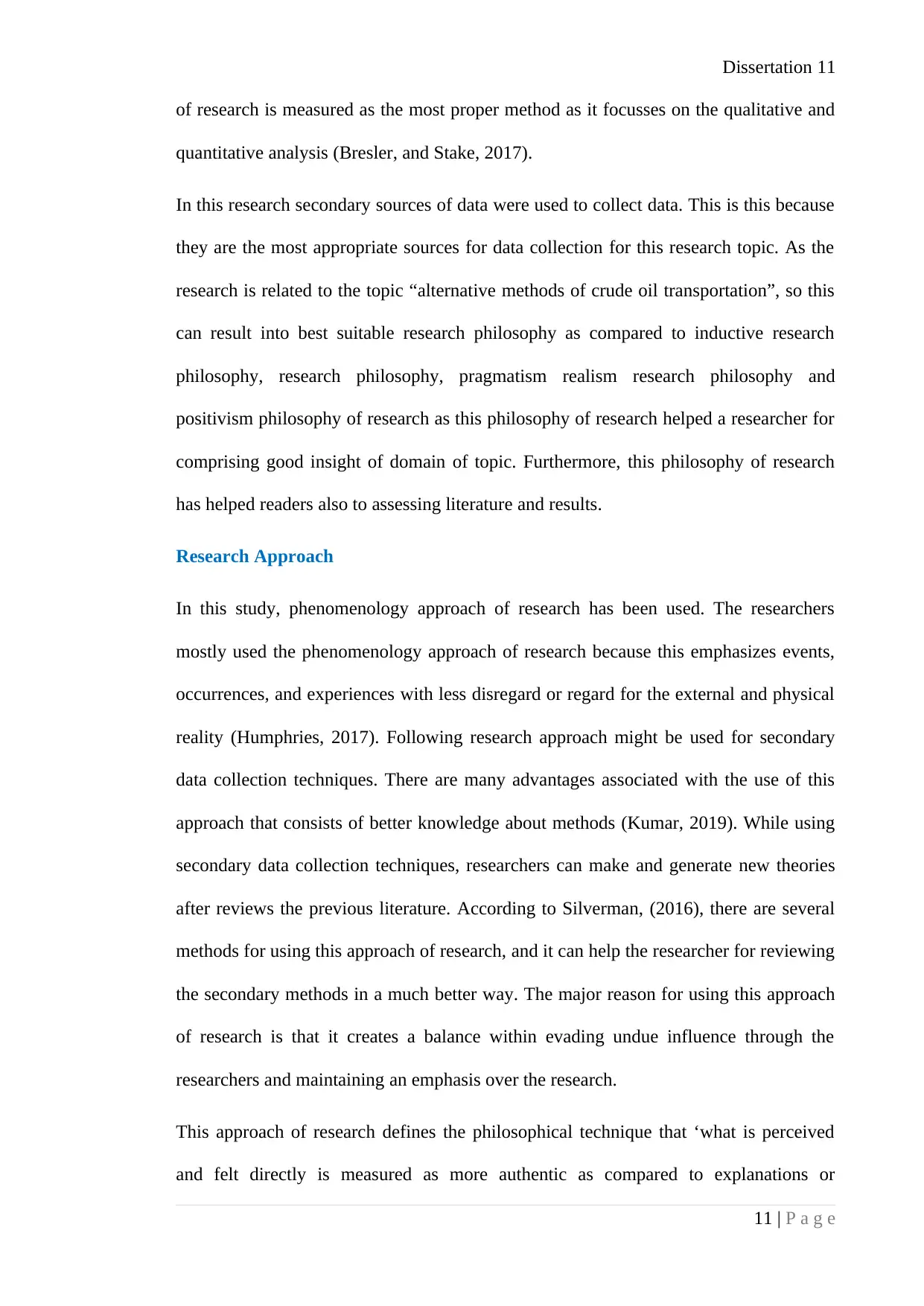
Dissertation 11
of research is measured as the most proper method as it focusses on the qualitative and
quantitative analysis (Bresler, and Stake, 2017).
In this research secondary sources of data were used to collect data. This is this because
they are the most appropriate sources for data collection for this research topic. As the
research is related to the topic “alternative methods of crude oil transportation”, so this
can result into best suitable research philosophy as compared to inductive research
philosophy, research philosophy, pragmatism realism research philosophy and
positivism philosophy of research as this philosophy of research helped a researcher for
comprising good insight of domain of topic. Furthermore, this philosophy of research
has helped readers also to assessing literature and results.
Research Approach
In this study, phenomenology approach of research has been used. The researchers
mostly used the phenomenology approach of research because this emphasizes events,
occurrences, and experiences with less disregard or regard for the external and physical
reality (Humphries, 2017). Following research approach might be used for secondary
data collection techniques. There are many advantages associated with the use of this
approach that consists of better knowledge about methods (Kumar, 2019). While using
secondary data collection techniques, researchers can make and generate new theories
after reviews the previous literature. According to Silverman, (2016), there are several
methods for using this approach of research, and it can help the researcher for reviewing
the secondary methods in a much better way. The major reason for using this approach
of research is that it creates a balance within evading undue influence through the
researchers and maintaining an emphasis over the research.
This approach of research defines the philosophical technique that ‘what is perceived
and felt directly is measured as more authentic as compared to explanations or
11 | P a g e
of research is measured as the most proper method as it focusses on the qualitative and
quantitative analysis (Bresler, and Stake, 2017).
In this research secondary sources of data were used to collect data. This is this because
they are the most appropriate sources for data collection for this research topic. As the
research is related to the topic “alternative methods of crude oil transportation”, so this
can result into best suitable research philosophy as compared to inductive research
philosophy, research philosophy, pragmatism realism research philosophy and
positivism philosophy of research as this philosophy of research helped a researcher for
comprising good insight of domain of topic. Furthermore, this philosophy of research
has helped readers also to assessing literature and results.
Research Approach
In this study, phenomenology approach of research has been used. The researchers
mostly used the phenomenology approach of research because this emphasizes events,
occurrences, and experiences with less disregard or regard for the external and physical
reality (Humphries, 2017). Following research approach might be used for secondary
data collection techniques. There are many advantages associated with the use of this
approach that consists of better knowledge about methods (Kumar, 2019). While using
secondary data collection techniques, researchers can make and generate new theories
after reviews the previous literature. According to Silverman, (2016), there are several
methods for using this approach of research, and it can help the researcher for reviewing
the secondary methods in a much better way. The major reason for using this approach
of research is that it creates a balance within evading undue influence through the
researchers and maintaining an emphasis over the research.
This approach of research defines the philosophical technique that ‘what is perceived
and felt directly is measured as more authentic as compared to explanations or
11 | P a g e
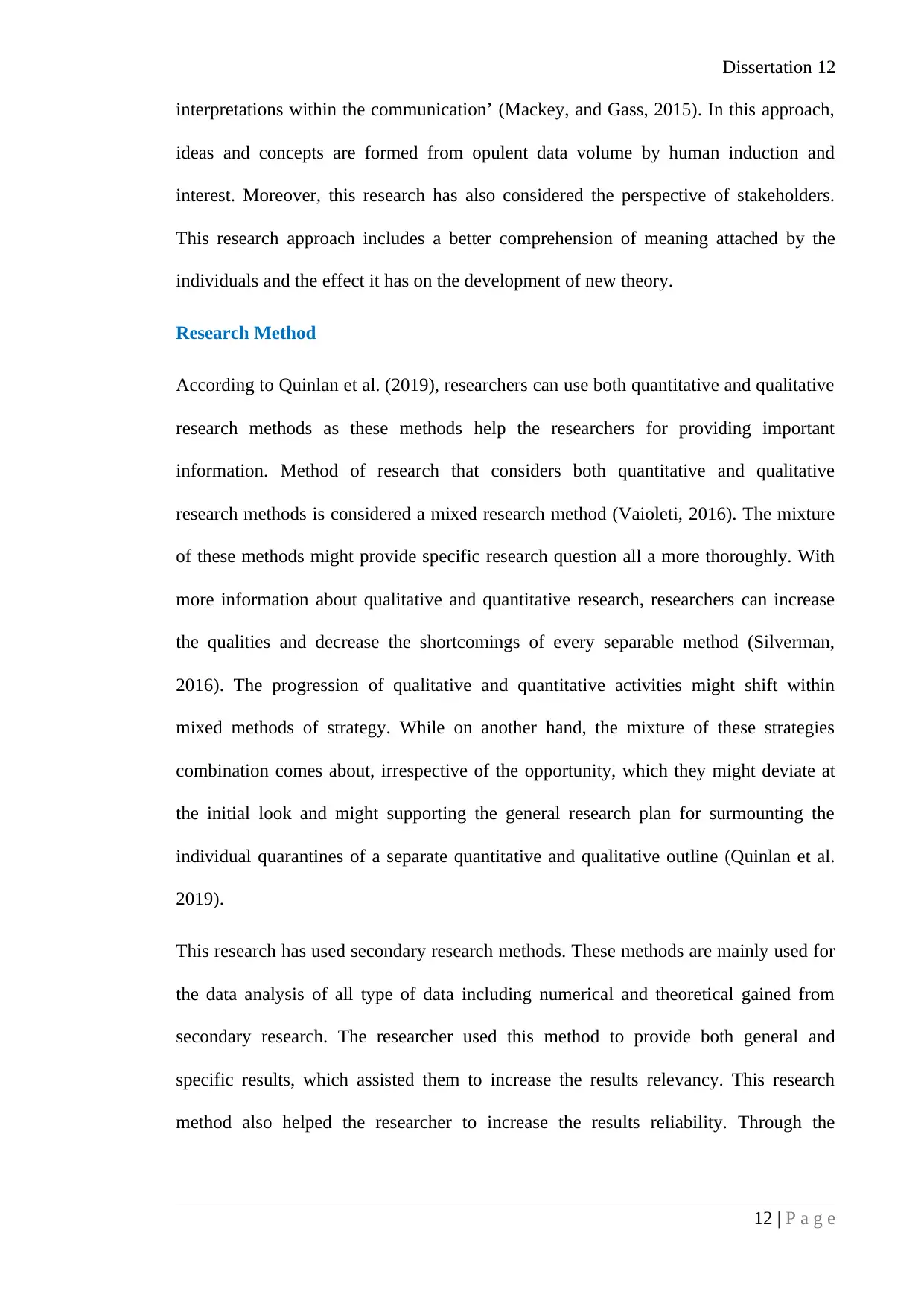
Dissertation 12
interpretations within the communication’ (Mackey, and Gass, 2015). In this approach,
ideas and concepts are formed from opulent data volume by human induction and
interest. Moreover, this research has also considered the perspective of stakeholders.
This research approach includes a better comprehension of meaning attached by the
individuals and the effect it has on the development of new theory.
Research Method
According to Quinlan et al. (2019), researchers can use both quantitative and qualitative
research methods as these methods help the researchers for providing important
information. Method of research that considers both quantitative and qualitative
research methods is considered a mixed research method (Vaioleti, 2016). The mixture
of these methods might provide specific research question all a more thoroughly. With
more information about qualitative and quantitative research, researchers can increase
the qualities and decrease the shortcomings of every separable method (Silverman,
2016). The progression of qualitative and quantitative activities might shift within
mixed methods of strategy. While on another hand, the mixture of these strategies
combination comes about, irrespective of the opportunity, which they might deviate at
the initial look and might supporting the general research plan for surmounting the
individual quarantines of a separate quantitative and qualitative outline (Quinlan et al.
2019).
This research has used secondary research methods. These methods are mainly used for
the data analysis of all type of data including numerical and theoretical gained from
secondary research. The researcher used this method to provide both general and
specific results, which assisted them to increase the results relevancy. This research
method also helped the researcher to increase the results reliability. Through the
12 | P a g e
interpretations within the communication’ (Mackey, and Gass, 2015). In this approach,
ideas and concepts are formed from opulent data volume by human induction and
interest. Moreover, this research has also considered the perspective of stakeholders.
This research approach includes a better comprehension of meaning attached by the
individuals and the effect it has on the development of new theory.
Research Method
According to Quinlan et al. (2019), researchers can use both quantitative and qualitative
research methods as these methods help the researchers for providing important
information. Method of research that considers both quantitative and qualitative
research methods is considered a mixed research method (Vaioleti, 2016). The mixture
of these methods might provide specific research question all a more thoroughly. With
more information about qualitative and quantitative research, researchers can increase
the qualities and decrease the shortcomings of every separable method (Silverman,
2016). The progression of qualitative and quantitative activities might shift within
mixed methods of strategy. While on another hand, the mixture of these strategies
combination comes about, irrespective of the opportunity, which they might deviate at
the initial look and might supporting the general research plan for surmounting the
individual quarantines of a separate quantitative and qualitative outline (Quinlan et al.
2019).
This research has used secondary research methods. These methods are mainly used for
the data analysis of all type of data including numerical and theoretical gained from
secondary research. The researcher used this method to provide both general and
specific results, which assisted them to increase the results relevancy. This research
method also helped the researcher to increase the results reliability. Through the
12 | P a g e
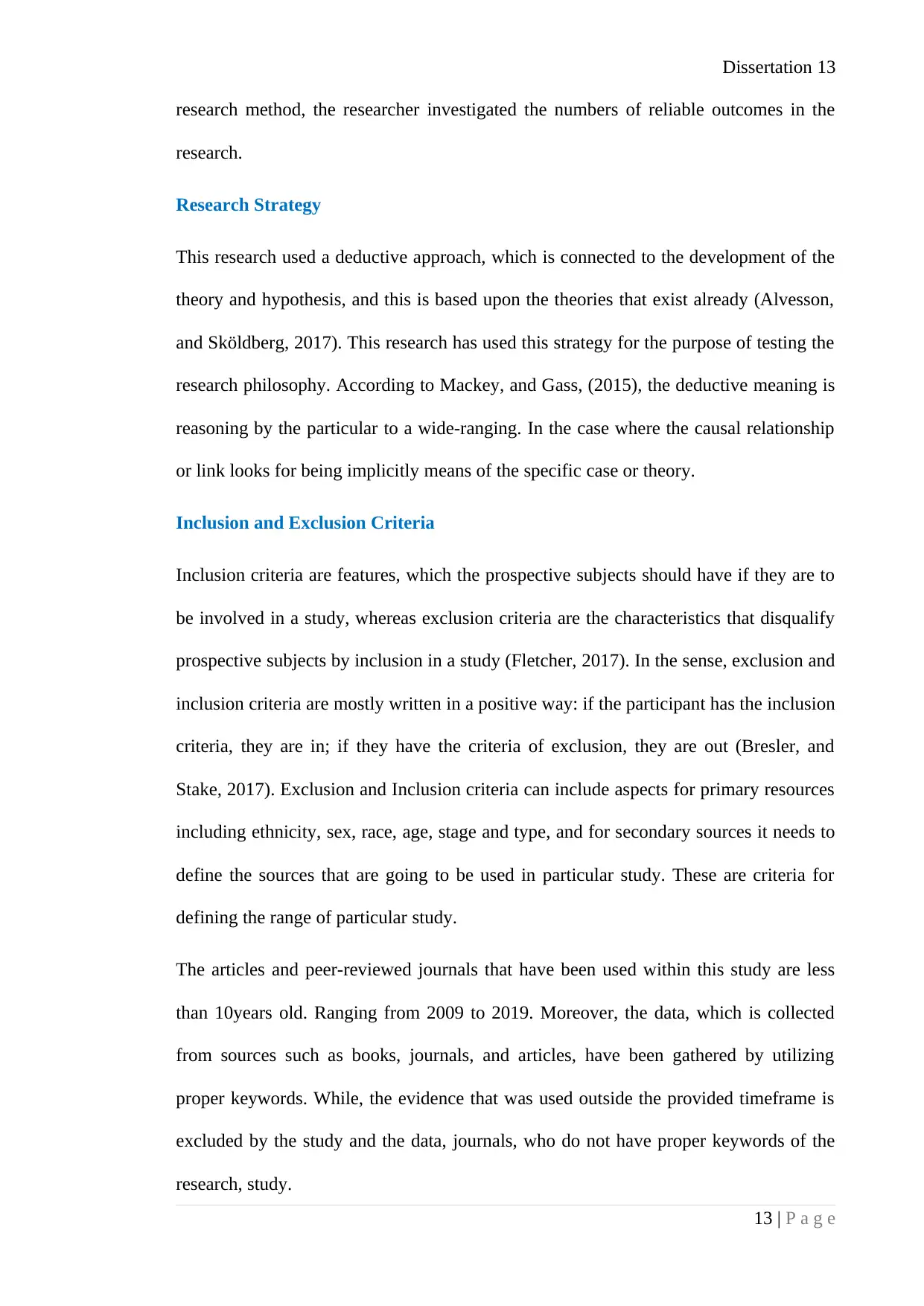
Dissertation 13
research method, the researcher investigated the numbers of reliable outcomes in the
research.
Research Strategy
This research used a deductive approach, which is connected to the development of the
theory and hypothesis, and this is based upon the theories that exist already (Alvesson,
and Sköldberg, 2017). This research has used this strategy for the purpose of testing the
research philosophy. According to Mackey, and Gass, (2015), the deductive meaning is
reasoning by the particular to a wide-ranging. In the case where the causal relationship
or link looks for being implicitly means of the specific case or theory.
Inclusion and Exclusion Criteria
Inclusion criteria are features, which the prospective subjects should have if they are to
be involved in a study, whereas exclusion criteria are the characteristics that disqualify
prospective subjects by inclusion in a study (Fletcher, 2017). In the sense, exclusion and
inclusion criteria are mostly written in a positive way: if the participant has the inclusion
criteria, they are in; if they have the criteria of exclusion, they are out (Bresler, and
Stake, 2017). Exclusion and Inclusion criteria can include aspects for primary resources
including ethnicity, sex, race, age, stage and type, and for secondary sources it needs to
define the sources that are going to be used in particular study. These are criteria for
defining the range of particular study.
The articles and peer-reviewed journals that have been used within this study are less
than 10years old. Ranging from 2009 to 2019. Moreover, the data, which is collected
from sources such as books, journals, and articles, have been gathered by utilizing
proper keywords. While, the evidence that was used outside the provided timeframe is
excluded by the study and the data, journals, who do not have proper keywords of the
research, study.
13 | P a g e
research method, the researcher investigated the numbers of reliable outcomes in the
research.
Research Strategy
This research used a deductive approach, which is connected to the development of the
theory and hypothesis, and this is based upon the theories that exist already (Alvesson,
and Sköldberg, 2017). This research has used this strategy for the purpose of testing the
research philosophy. According to Mackey, and Gass, (2015), the deductive meaning is
reasoning by the particular to a wide-ranging. In the case where the causal relationship
or link looks for being implicitly means of the specific case or theory.
Inclusion and Exclusion Criteria
Inclusion criteria are features, which the prospective subjects should have if they are to
be involved in a study, whereas exclusion criteria are the characteristics that disqualify
prospective subjects by inclusion in a study (Fletcher, 2017). In the sense, exclusion and
inclusion criteria are mostly written in a positive way: if the participant has the inclusion
criteria, they are in; if they have the criteria of exclusion, they are out (Bresler, and
Stake, 2017). Exclusion and Inclusion criteria can include aspects for primary resources
including ethnicity, sex, race, age, stage and type, and for secondary sources it needs to
define the sources that are going to be used in particular study. These are criteria for
defining the range of particular study.
The articles and peer-reviewed journals that have been used within this study are less
than 10years old. Ranging from 2009 to 2019. Moreover, the data, which is collected
from sources such as books, journals, and articles, have been gathered by utilizing
proper keywords. While, the evidence that was used outside the provided timeframe is
excluded by the study and the data, journals, who do not have proper keywords of the
research, study.
13 | P a g e
Paraphrase This Document
Need a fresh take? Get an instant paraphrase of this document with our AI Paraphraser
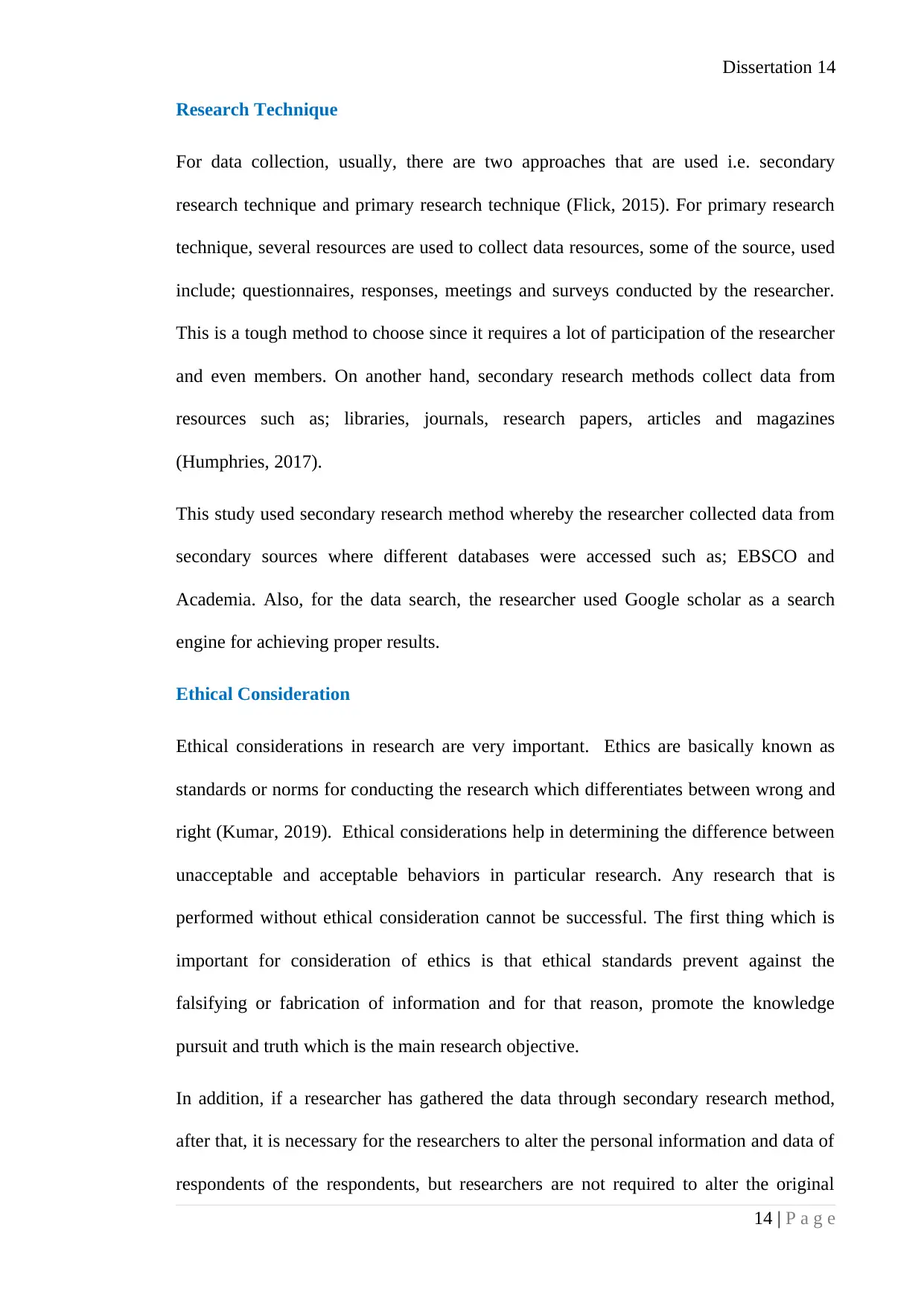
Dissertation 14
Research Technique
For data collection, usually, there are two approaches that are used i.e. secondary
research technique and primary research technique (Flick, 2015). For primary research
technique, several resources are used to collect data resources, some of the source, used
include; questionnaires, responses, meetings and surveys conducted by the researcher.
This is a tough method to choose since it requires a lot of participation of the researcher
and even members. On another hand, secondary research methods collect data from
resources such as; libraries, journals, research papers, articles and magazines
(Humphries, 2017).
This study used secondary research method whereby the researcher collected data from
secondary sources where different databases were accessed such as; EBSCO and
Academia. Also, for the data search, the researcher used Google scholar as a search
engine for achieving proper results.
Ethical Consideration
Ethical considerations in research are very important. Ethics are basically known as
standards or norms for conducting the research which differentiates between wrong and
right (Kumar, 2019). Ethical considerations help in determining the difference between
unacceptable and acceptable behaviors in particular research. Any research that is
performed without ethical consideration cannot be successful. The first thing which is
important for consideration of ethics is that ethical standards prevent against the
falsifying or fabrication of information and for that reason, promote the knowledge
pursuit and truth which is the main research objective.
In addition, if a researcher has gathered the data through secondary research method,
after that, it is necessary for the researchers to alter the personal information and data of
respondents of the respondents, but researchers are not required to alter the original
14 | P a g e
Research Technique
For data collection, usually, there are two approaches that are used i.e. secondary
research technique and primary research technique (Flick, 2015). For primary research
technique, several resources are used to collect data resources, some of the source, used
include; questionnaires, responses, meetings and surveys conducted by the researcher.
This is a tough method to choose since it requires a lot of participation of the researcher
and even members. On another hand, secondary research methods collect data from
resources such as; libraries, journals, research papers, articles and magazines
(Humphries, 2017).
This study used secondary research method whereby the researcher collected data from
secondary sources where different databases were accessed such as; EBSCO and
Academia. Also, for the data search, the researcher used Google scholar as a search
engine for achieving proper results.
Ethical Consideration
Ethical considerations in research are very important. Ethics are basically known as
standards or norms for conducting the research which differentiates between wrong and
right (Kumar, 2019). Ethical considerations help in determining the difference between
unacceptable and acceptable behaviors in particular research. Any research that is
performed without ethical consideration cannot be successful. The first thing which is
important for consideration of ethics is that ethical standards prevent against the
falsifying or fabrication of information and for that reason, promote the knowledge
pursuit and truth which is the main research objective.
In addition, if a researcher has gathered the data through secondary research method,
after that, it is necessary for the researchers to alter the personal information and data of
respondents of the respondents, but researchers are not required to alter the original
14 | P a g e

Dissertation 15
references and quotation of the scholar. In the secondary resources, the researchers use
material, articles, and journals that are provided and already written by others, so it is
important for the researchers to maintain the ethical consideration for using the work of
others. They are required to reference the authors from where they obtained the data, as
in the data collection for this topic “different methods of crude oil transportation on
tankers market” collected from secondary sources, so this research has cited all the
references which ware used while carrying this study.
CHAPTER 3
Literature review
Impact of the different modes of transportation of crude oil.
According to the study Wu et al., (2016, p.581), a number of years ago there was an
important discussion on the topic of ‘Pipeline construction for transportation of crude
oil’ to determine the impact of the expansion of the project of transportation of crude oil
by the pipeline on the tanker market. The advantages of completing the pipeline project
were discussed briefly such as; it could help the producer to effectively manage the
balance between the supply and demand of the crude oil as well and the transportation
of the crude oil by the pipeline was considered to be less negative effects on the
environmental. The researchers Wu et al., (2015, p.64) discussed the case of China and
stated that the strategy of the transportation of crude oil by the pipeline provided an
alternative as well as shorter routes to import the fuel. Also, the capacity of the pipeline
is 440,000 barrels per day which are meant to supply a refinery construction. However,
the tanker market was declined by the project of the pipeline as the producers found the
15 | P a g e
references and quotation of the scholar. In the secondary resources, the researchers use
material, articles, and journals that are provided and already written by others, so it is
important for the researchers to maintain the ethical consideration for using the work of
others. They are required to reference the authors from where they obtained the data, as
in the data collection for this topic “different methods of crude oil transportation on
tankers market” collected from secondary sources, so this research has cited all the
references which ware used while carrying this study.
CHAPTER 3
Literature review
Impact of the different modes of transportation of crude oil.
According to the study Wu et al., (2016, p.581), a number of years ago there was an
important discussion on the topic of ‘Pipeline construction for transportation of crude
oil’ to determine the impact of the expansion of the project of transportation of crude oil
by the pipeline on the tanker market. The advantages of completing the pipeline project
were discussed briefly such as; it could help the producer to effectively manage the
balance between the supply and demand of the crude oil as well and the transportation
of the crude oil by the pipeline was considered to be less negative effects on the
environmental. The researchers Wu et al., (2015, p.64) discussed the case of China and
stated that the strategy of the transportation of crude oil by the pipeline provided an
alternative as well as shorter routes to import the fuel. Also, the capacity of the pipeline
is 440,000 barrels per day which are meant to supply a refinery construction. However,
the tanker market was declined by the project of the pipeline as the producers found the
15 | P a g e

Dissertation 16
pipeline project more beneficial as compared to the transportation of the crude oil by
truck.
In contrast, the study of Siddiqui and Verma, (2018, p.280) producers can supply the
crude oil according to the demand by the pipeline because the capacity of transporting
crude oil by the pipeline is higher however the producers can also provide a limited
amount of crude oil by the truck due to the limited capacity.
There are higher risks rates associated with the transportation of crude oil by the use of
ship and trucks. The production and transportation of crude oil have a significant impact
on the economy of a given country. Therefore, the transport of crude oil has also raised
the items for the necessary considerations. The factors which should are considered to
be essentially considered in the transportation of the crude oil are; the capacity, cost,
and risks which are associated with the transport of the crude oil. The study of the
Aborda et al., (2016, p.222) stated that the traditional way of the transport of crude oil
was by the tanker market and the tanker market had great productivity because of the
transpiration of the crude oil. However, by the passage of time, it was observed that the
transportation of crude oil by the tanker market was causing an extra cost of production
to the producers. The research of Amani and Kariminezhad, (2016, p.216) representing
the data which demonstrated that the regions or the states which transport the crude oil
by the pipeline avail more benefits as well as they can also effectively carry the crude
oil from the producer to the consumer end. The transportation of crude oil from one
region to another region has become more convenient by the pipeline project.
The researchers Kilian (2016, p.185), conducted secondary qualitative research in order
to determine the impact of the different methods of crude oil transportation on tankers
market and the stated that the producers could get more benefits as well as incentives in
order to transport crude oil the capacity of the bottlenecks in the pipeline network is
16 | P a g e
pipeline project more beneficial as compared to the transportation of the crude oil by
truck.
In contrast, the study of Siddiqui and Verma, (2018, p.280) producers can supply the
crude oil according to the demand by the pipeline because the capacity of transporting
crude oil by the pipeline is higher however the producers can also provide a limited
amount of crude oil by the truck due to the limited capacity.
There are higher risks rates associated with the transportation of crude oil by the use of
ship and trucks. The production and transportation of crude oil have a significant impact
on the economy of a given country. Therefore, the transport of crude oil has also raised
the items for the necessary considerations. The factors which should are considered to
be essentially considered in the transportation of the crude oil are; the capacity, cost,
and risks which are associated with the transport of the crude oil. The study of the
Aborda et al., (2016, p.222) stated that the traditional way of the transport of crude oil
was by the tanker market and the tanker market had great productivity because of the
transpiration of the crude oil. However, by the passage of time, it was observed that the
transportation of crude oil by the tanker market was causing an extra cost of production
to the producers. The research of Amani and Kariminezhad, (2016, p.216) representing
the data which demonstrated that the regions or the states which transport the crude oil
by the pipeline avail more benefits as well as they can also effectively carry the crude
oil from the producer to the consumer end. The transportation of crude oil from one
region to another region has become more convenient by the pipeline project.
The researchers Kilian (2016, p.185), conducted secondary qualitative research in order
to determine the impact of the different methods of crude oil transportation on tankers
market and the stated that the producers could get more benefits as well as incentives in
order to transport crude oil the capacity of the bottlenecks in the pipeline network is
16 | P a g e
Secure Best Marks with AI Grader
Need help grading? Try our AI Grader for instant feedback on your assignments.
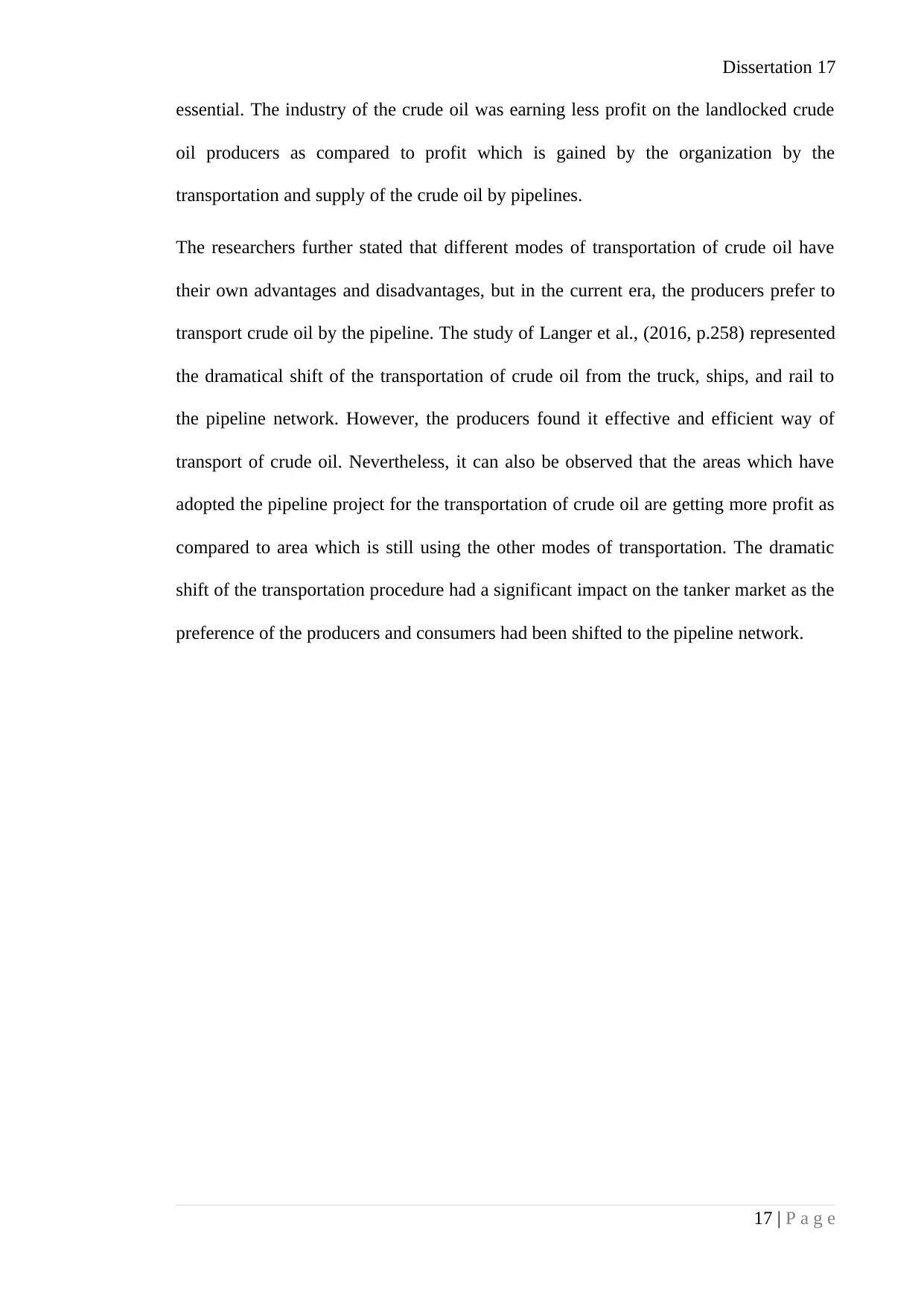
Dissertation 17
essential. The industry of the crude oil was earning less profit on the landlocked crude
oil producers as compared to profit which is gained by the organization by the
transportation and supply of the crude oil by pipelines.
The researchers further stated that different modes of transportation of crude oil have
their own advantages and disadvantages, but in the current era, the producers prefer to
transport crude oil by the pipeline. The study of Langer et al., (2016, p.258) represented
the dramatical shift of the transportation of crude oil from the truck, ships, and rail to
the pipeline network. However, the producers found it effective and efficient way of
transport of crude oil. Nevertheless, it can also be observed that the areas which have
adopted the pipeline project for the transportation of crude oil are getting more profit as
compared to area which is still using the other modes of transportation. The dramatic
shift of the transportation procedure had a significant impact on the tanker market as the
preference of the producers and consumers had been shifted to the pipeline network.
17 | P a g e
essential. The industry of the crude oil was earning less profit on the landlocked crude
oil producers as compared to profit which is gained by the organization by the
transportation and supply of the crude oil by pipelines.
The researchers further stated that different modes of transportation of crude oil have
their own advantages and disadvantages, but in the current era, the producers prefer to
transport crude oil by the pipeline. The study of Langer et al., (2016, p.258) represented
the dramatical shift of the transportation of crude oil from the truck, ships, and rail to
the pipeline network. However, the producers found it effective and efficient way of
transport of crude oil. Nevertheless, it can also be observed that the areas which have
adopted the pipeline project for the transportation of crude oil are getting more profit as
compared to area which is still using the other modes of transportation. The dramatic
shift of the transportation procedure had a significant impact on the tanker market as the
preference of the producers and consumers had been shifted to the pipeline network.
17 | P a g e
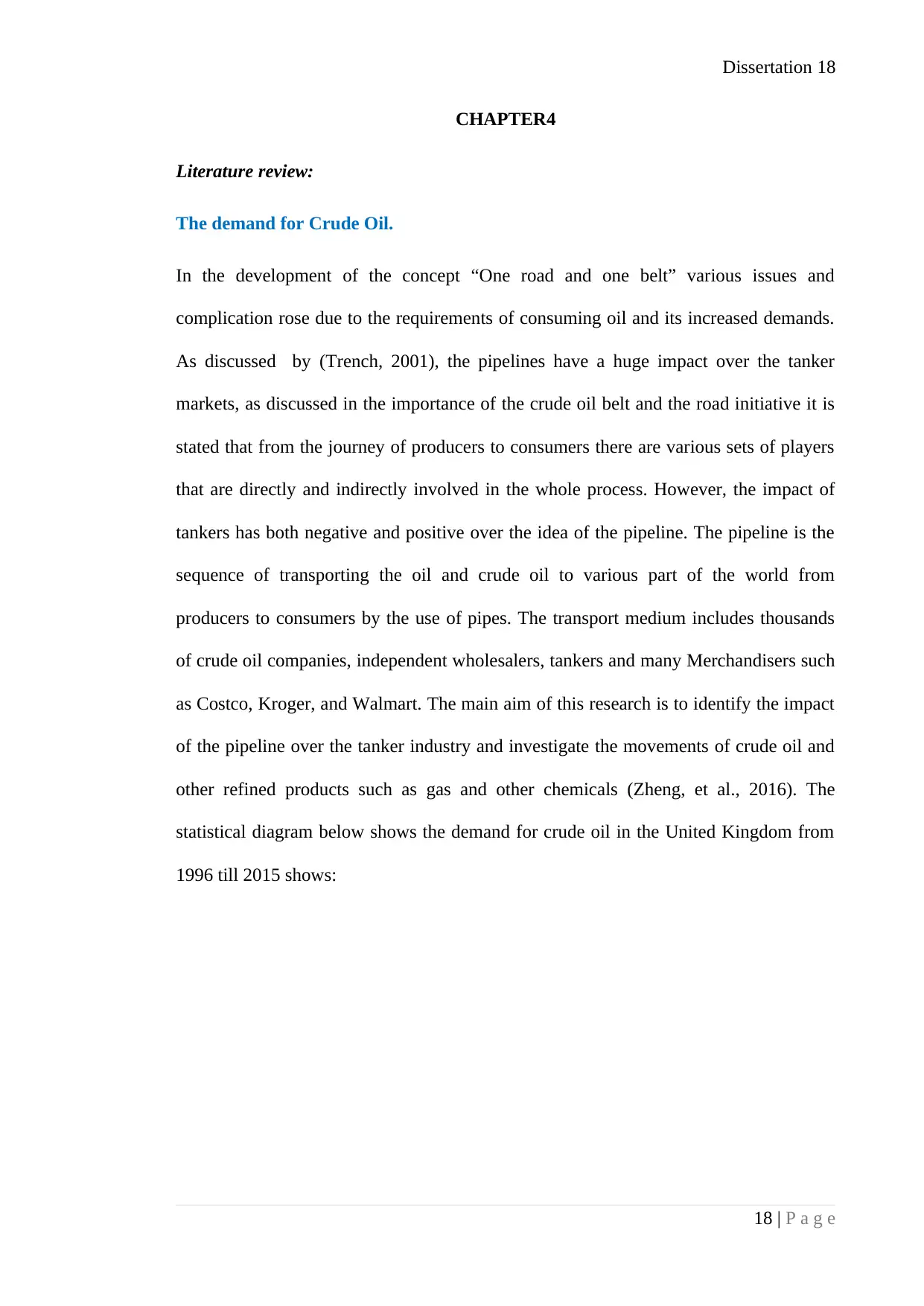
Dissertation 18
CHAPTER4
Literature review:
The demand for Crude Oil.
In the development of the concept “One road and one belt” various issues and
complication rose due to the requirements of consuming oil and its increased demands.
As discussed by (Trench, 2001), the pipelines have a huge impact over the tanker
markets, as discussed in the importance of the crude oil belt and the road initiative it is
stated that from the journey of producers to consumers there are various sets of players
that are directly and indirectly involved in the whole process. However, the impact of
tankers has both negative and positive over the idea of the pipeline. The pipeline is the
sequence of transporting the oil and crude oil to various part of the world from
producers to consumers by the use of pipes. The transport medium includes thousands
of crude oil companies, independent wholesalers, tankers and many Merchandisers such
as Costco, Kroger, and Walmart. The main aim of this research is to identify the impact
of the pipeline over the tanker industry and investigate the movements of crude oil and
other refined products such as gas and other chemicals (Zheng, et al., 2016). The
statistical diagram below shows the demand for crude oil in the United Kingdom from
1996 till 2015 shows:
18 | P a g e
CHAPTER4
Literature review:
The demand for Crude Oil.
In the development of the concept “One road and one belt” various issues and
complication rose due to the requirements of consuming oil and its increased demands.
As discussed by (Trench, 2001), the pipelines have a huge impact over the tanker
markets, as discussed in the importance of the crude oil belt and the road initiative it is
stated that from the journey of producers to consumers there are various sets of players
that are directly and indirectly involved in the whole process. However, the impact of
tankers has both negative and positive over the idea of the pipeline. The pipeline is the
sequence of transporting the oil and crude oil to various part of the world from
producers to consumers by the use of pipes. The transport medium includes thousands
of crude oil companies, independent wholesalers, tankers and many Merchandisers such
as Costco, Kroger, and Walmart. The main aim of this research is to identify the impact
of the pipeline over the tanker industry and investigate the movements of crude oil and
other refined products such as gas and other chemicals (Zheng, et al., 2016). The
statistical diagram below shows the demand for crude oil in the United Kingdom from
1996 till 2015 shows:
18 | P a g e
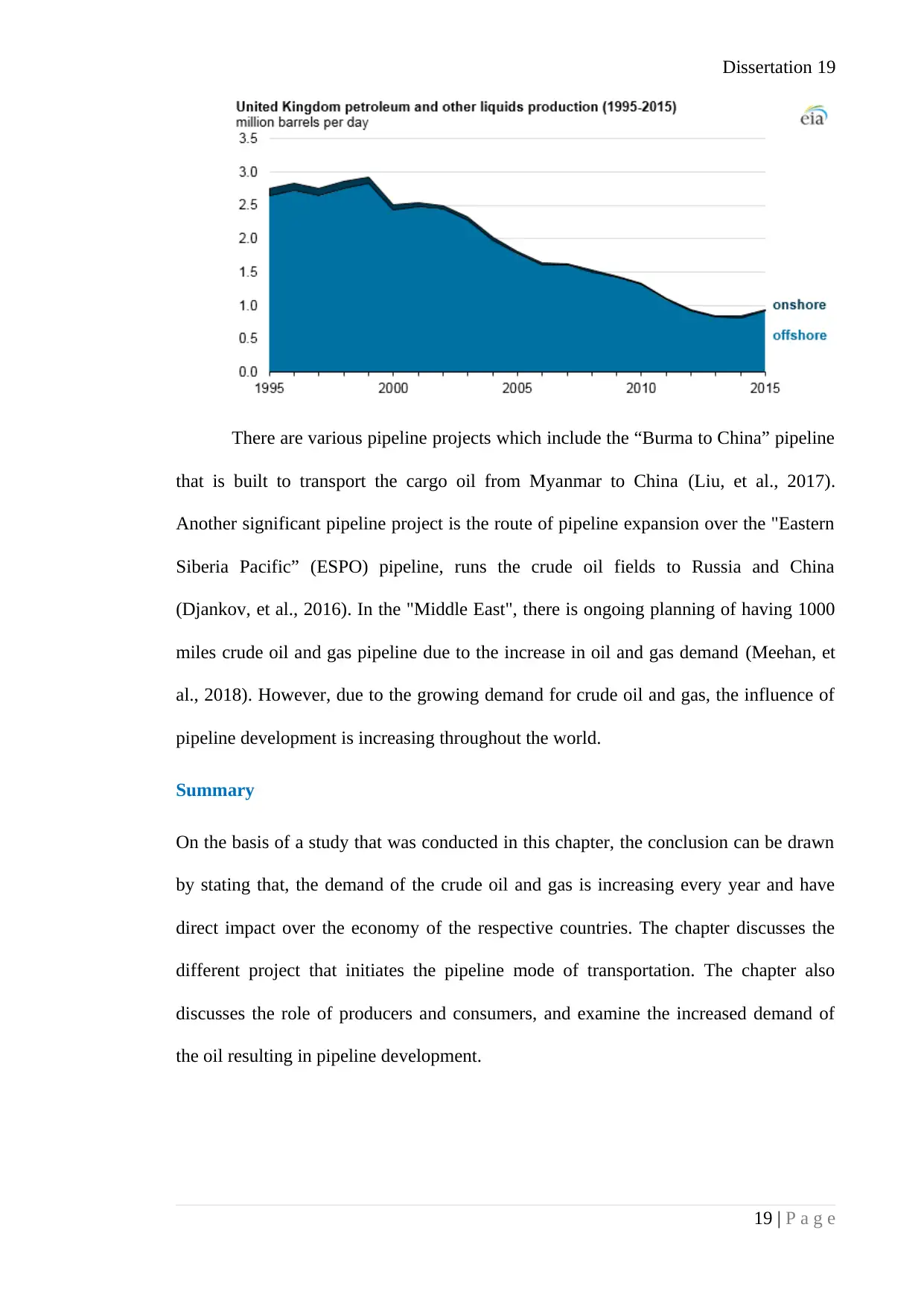
Dissertation 19
There are various pipeline projects which include the “Burma to China” pipeline
that is built to transport the cargo oil from Myanmar to China (Liu, et al., 2017).
Another significant pipeline project is the route of pipeline expansion over the "Eastern
Siberia Pacific” (ESPO) pipeline, runs the crude oil fields to Russia and China
(Djankov, et al., 2016). In the "Middle East", there is ongoing planning of having 1000
miles crude oil and gas pipeline due to the increase in oil and gas demand (Meehan, et
al., 2018). However, due to the growing demand for crude oil and gas, the influence of
pipeline development is increasing throughout the world.
Summary
On the basis of a study that was conducted in this chapter, the conclusion can be drawn
by stating that, the demand of the crude oil and gas is increasing every year and have
direct impact over the economy of the respective countries. The chapter discusses the
different project that initiates the pipeline mode of transportation. The chapter also
discusses the role of producers and consumers, and examine the increased demand of
the oil resulting in pipeline development.
19 | P a g e
There are various pipeline projects which include the “Burma to China” pipeline
that is built to transport the cargo oil from Myanmar to China (Liu, et al., 2017).
Another significant pipeline project is the route of pipeline expansion over the "Eastern
Siberia Pacific” (ESPO) pipeline, runs the crude oil fields to Russia and China
(Djankov, et al., 2016). In the "Middle East", there is ongoing planning of having 1000
miles crude oil and gas pipeline due to the increase in oil and gas demand (Meehan, et
al., 2018). However, due to the growing demand for crude oil and gas, the influence of
pipeline development is increasing throughout the world.
Summary
On the basis of a study that was conducted in this chapter, the conclusion can be drawn
by stating that, the demand of the crude oil and gas is increasing every year and have
direct impact over the economy of the respective countries. The chapter discusses the
different project that initiates the pipeline mode of transportation. The chapter also
discusses the role of producers and consumers, and examine the increased demand of
the oil resulting in pipeline development.
19 | P a g e
Paraphrase This Document
Need a fresh take? Get an instant paraphrase of this document with our AI Paraphraser
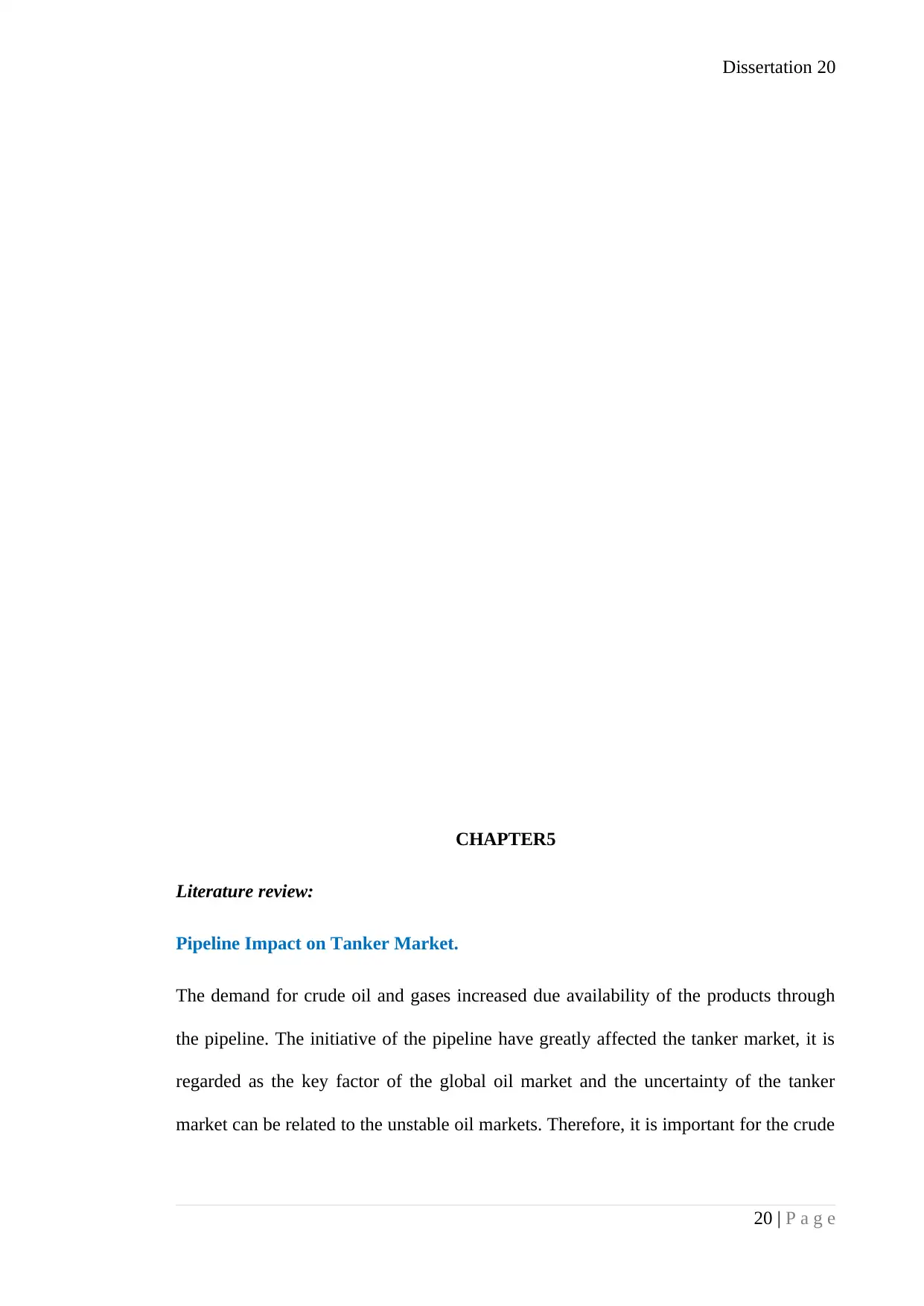
Dissertation 20
CHAPTER5
Literature review:
Pipeline Impact on Tanker Market.
The demand for crude oil and gases increased due availability of the products through
the pipeline. The initiative of the pipeline have greatly affected the tanker market, it is
regarded as the key factor of the global oil market and the uncertainty of the tanker
market can be related to the unstable oil markets. Therefore, it is important for the crude
20 | P a g e
CHAPTER5
Literature review:
Pipeline Impact on Tanker Market.
The demand for crude oil and gases increased due availability of the products through
the pipeline. The initiative of the pipeline have greatly affected the tanker market, it is
regarded as the key factor of the global oil market and the uncertainty of the tanker
market can be related to the unstable oil markets. Therefore, it is important for the crude
20 | P a g e
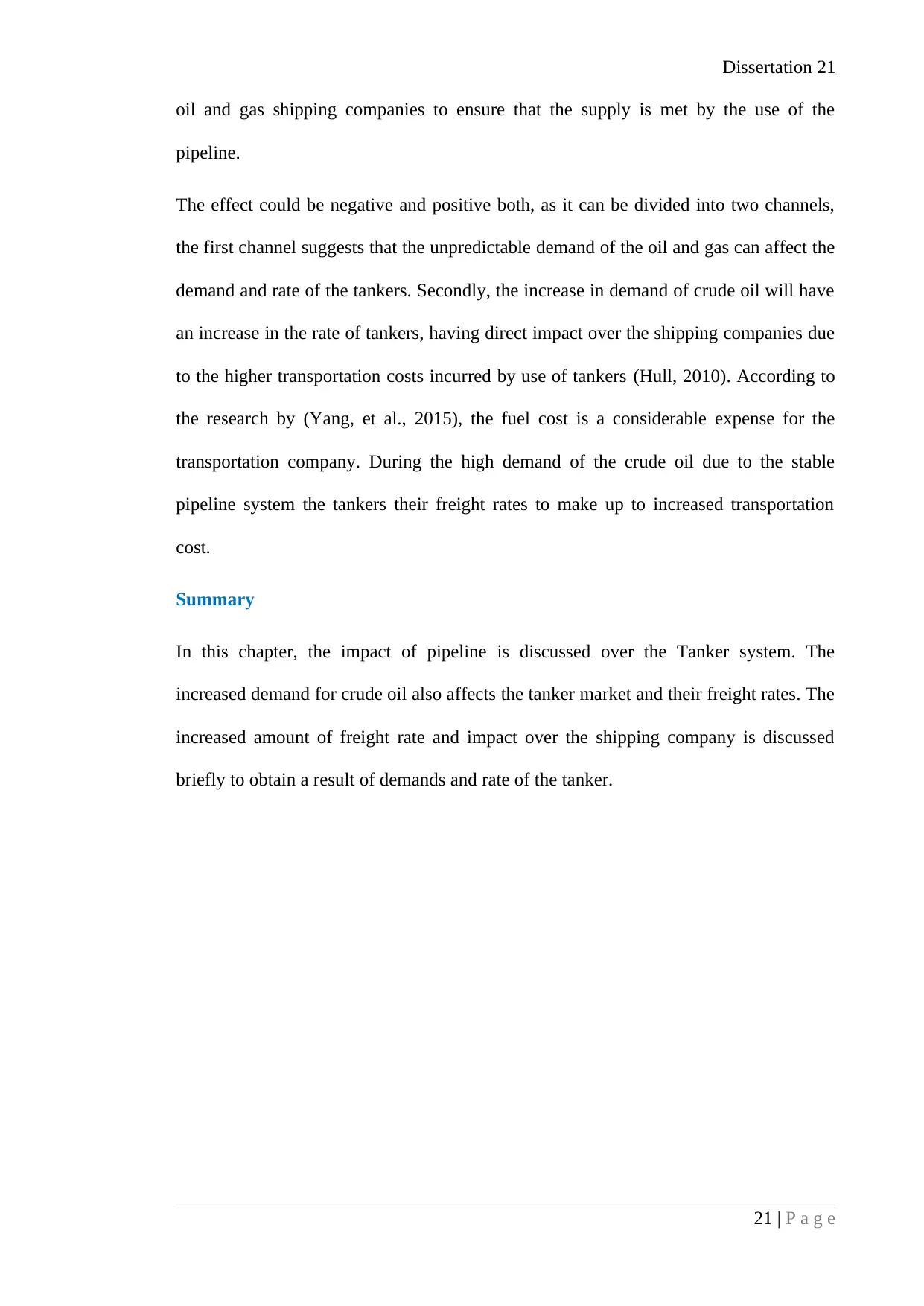
Dissertation 21
oil and gas shipping companies to ensure that the supply is met by the use of the
pipeline.
The effect could be negative and positive both, as it can be divided into two channels,
the first channel suggests that the unpredictable demand of the oil and gas can affect the
demand and rate of the tankers. Secondly, the increase in demand of crude oil will have
an increase in the rate of tankers, having direct impact over the shipping companies due
to the higher transportation costs incurred by use of tankers (Hull, 2010). According to
the research by (Yang, et al., 2015), the fuel cost is a considerable expense for the
transportation company. During the high demand of the crude oil due to the stable
pipeline system the tankers their freight rates to make up to increased transportation
cost.
Summary
In this chapter, the impact of pipeline is discussed over the Tanker system. The
increased demand for crude oil also affects the tanker market and their freight rates. The
increased amount of freight rate and impact over the shipping company is discussed
briefly to obtain a result of demands and rate of the tanker.
21 | P a g e
oil and gas shipping companies to ensure that the supply is met by the use of the
pipeline.
The effect could be negative and positive both, as it can be divided into two channels,
the first channel suggests that the unpredictable demand of the oil and gas can affect the
demand and rate of the tankers. Secondly, the increase in demand of crude oil will have
an increase in the rate of tankers, having direct impact over the shipping companies due
to the higher transportation costs incurred by use of tankers (Hull, 2010). According to
the research by (Yang, et al., 2015), the fuel cost is a considerable expense for the
transportation company. During the high demand of the crude oil due to the stable
pipeline system the tankers their freight rates to make up to increased transportation
cost.
Summary
In this chapter, the impact of pipeline is discussed over the Tanker system. The
increased demand for crude oil also affects the tanker market and their freight rates. The
increased amount of freight rate and impact over the shipping company is discussed
briefly to obtain a result of demands and rate of the tanker.
21 | P a g e
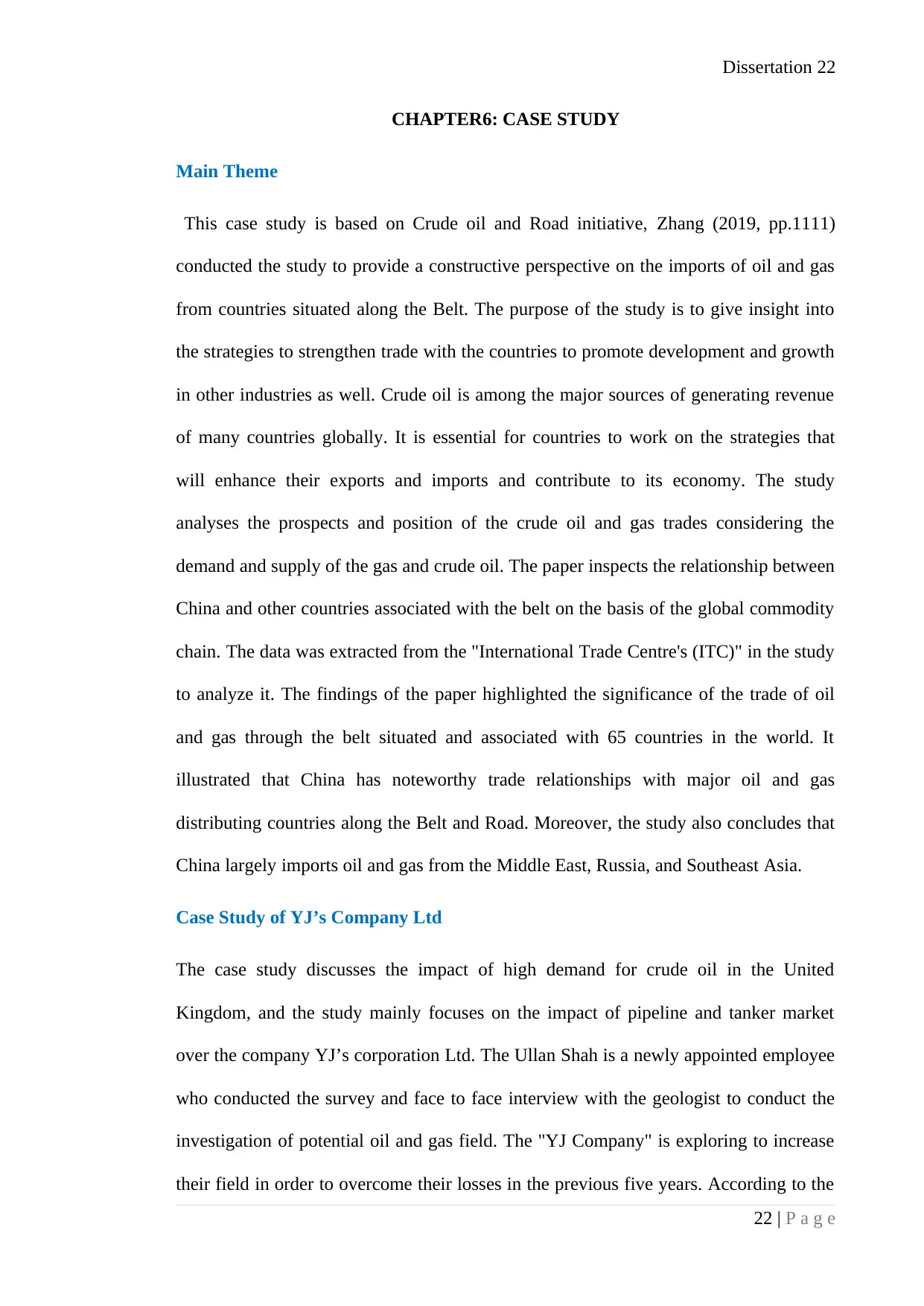
Dissertation 22
CHAPTER6: CASE STUDY
Main Theme
This case study is based on Crude oil and Road initiative, Zhang (2019, pp.1111)
conducted the study to provide a constructive perspective on the imports of oil and gas
from countries situated along the Belt. The purpose of the study is to give insight into
the strategies to strengthen trade with the countries to promote development and growth
in other industries as well. Crude oil is among the major sources of generating revenue
of many countries globally. It is essential for countries to work on the strategies that
will enhance their exports and imports and contribute to its economy. The study
analyses the prospects and position of the crude oil and gas trades considering the
demand and supply of the gas and crude oil. The paper inspects the relationship between
China and other countries associated with the belt on the basis of the global commodity
chain. The data was extracted from the "International Trade Centre's (ITC)" in the study
to analyze it. The findings of the paper highlighted the significance of the trade of oil
and gas through the belt situated and associated with 65 countries in the world. It
illustrated that China has noteworthy trade relationships with major oil and gas
distributing countries along the Belt and Road. Moreover, the study also concludes that
China largely imports oil and gas from the Middle East, Russia, and Southeast Asia.
Case Study of YJ’s Company Ltd
The case study discusses the impact of high demand for crude oil in the United
Kingdom, and the study mainly focuses on the impact of pipeline and tanker market
over the company YJ’s corporation Ltd. The Ullan Shah is a newly appointed employee
who conducted the survey and face to face interview with the geologist to conduct the
investigation of potential oil and gas field. The "YJ Company" is exploring to increase
their field in order to overcome their losses in the previous five years. According to the
22 | P a g e
CHAPTER6: CASE STUDY
Main Theme
This case study is based on Crude oil and Road initiative, Zhang (2019, pp.1111)
conducted the study to provide a constructive perspective on the imports of oil and gas
from countries situated along the Belt. The purpose of the study is to give insight into
the strategies to strengthen trade with the countries to promote development and growth
in other industries as well. Crude oil is among the major sources of generating revenue
of many countries globally. It is essential for countries to work on the strategies that
will enhance their exports and imports and contribute to its economy. The study
analyses the prospects and position of the crude oil and gas trades considering the
demand and supply of the gas and crude oil. The paper inspects the relationship between
China and other countries associated with the belt on the basis of the global commodity
chain. The data was extracted from the "International Trade Centre's (ITC)" in the study
to analyze it. The findings of the paper highlighted the significance of the trade of oil
and gas through the belt situated and associated with 65 countries in the world. It
illustrated that China has noteworthy trade relationships with major oil and gas
distributing countries along the Belt and Road. Moreover, the study also concludes that
China largely imports oil and gas from the Middle East, Russia, and Southeast Asia.
Case Study of YJ’s Company Ltd
The case study discusses the impact of high demand for crude oil in the United
Kingdom, and the study mainly focuses on the impact of pipeline and tanker market
over the company YJ’s corporation Ltd. The Ullan Shah is a newly appointed employee
who conducted the survey and face to face interview with the geologist to conduct the
investigation of potential oil and gas field. The "YJ Company" is exploring to increase
their field in order to overcome their losses in the previous five years. According to the
22 | P a g e
Secure Best Marks with AI Grader
Need help grading? Try our AI Grader for instant feedback on your assignments.
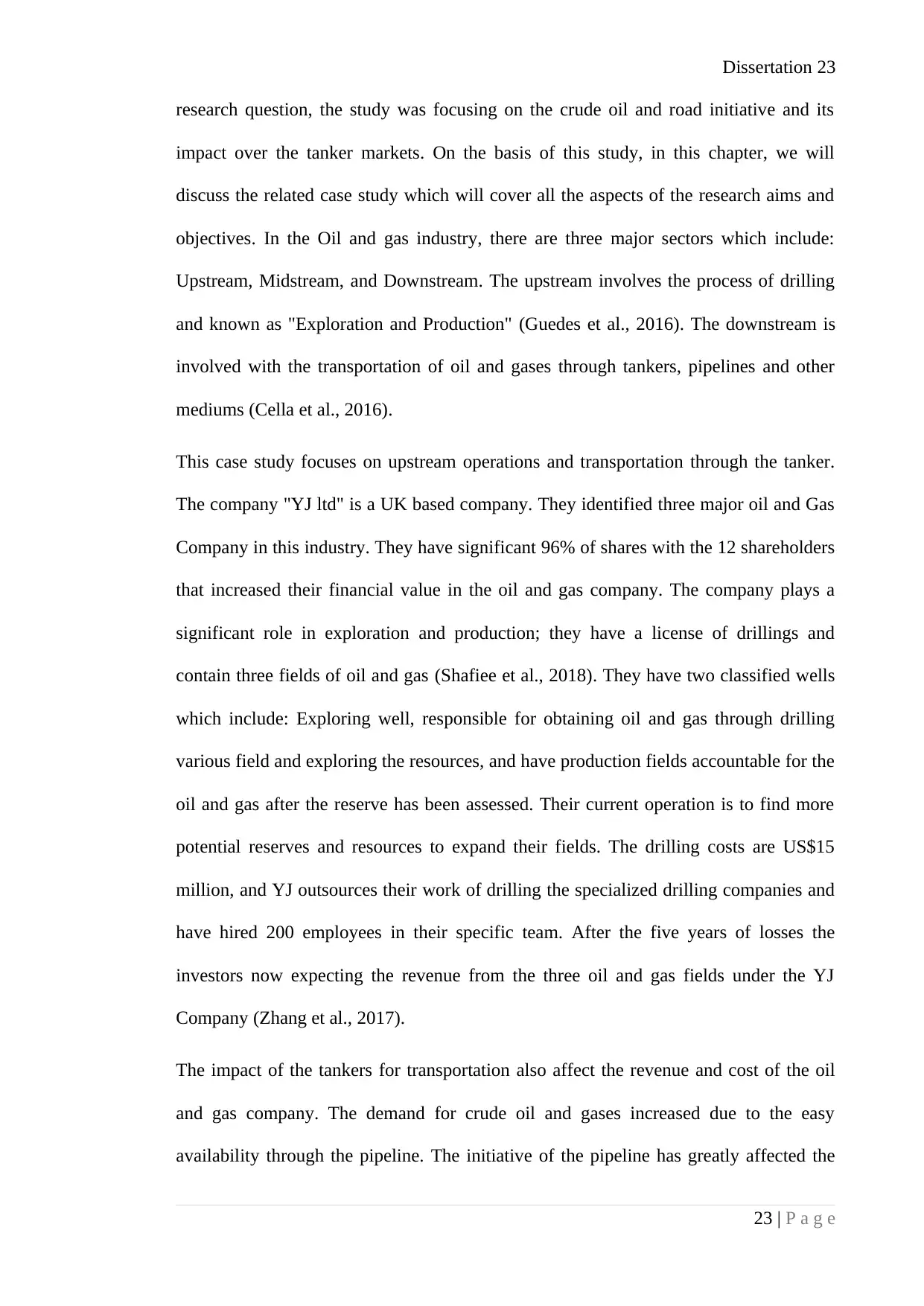
Dissertation 23
research question, the study was focusing on the crude oil and road initiative and its
impact over the tanker markets. On the basis of this study, in this chapter, we will
discuss the related case study which will cover all the aspects of the research aims and
objectives. In the Oil and gas industry, there are three major sectors which include:
Upstream, Midstream, and Downstream. The upstream involves the process of drilling
and known as "Exploration and Production" (Guedes et al., 2016). The downstream is
involved with the transportation of oil and gases through tankers, pipelines and other
mediums (Cella et al., 2016).
This case study focuses on upstream operations and transportation through the tanker.
The company "YJ ltd" is a UK based company. They identified three major oil and Gas
Company in this industry. They have significant 96% of shares with the 12 shareholders
that increased their financial value in the oil and gas company. The company plays a
significant role in exploration and production; they have a license of drillings and
contain three fields of oil and gas (Shafiee et al., 2018). They have two classified wells
which include: Exploring well, responsible for obtaining oil and gas through drilling
various field and exploring the resources, and have production fields accountable for the
oil and gas after the reserve has been assessed. Their current operation is to find more
potential reserves and resources to expand their fields. The drilling costs are US$15
million, and YJ outsources their work of drilling the specialized drilling companies and
have hired 200 employees in their specific team. After the five years of losses the
investors now expecting the revenue from the three oil and gas fields under the YJ
Company (Zhang et al., 2017).
The impact of the tankers for transportation also affect the revenue and cost of the oil
and gas company. The demand for crude oil and gases increased due to the easy
availability through the pipeline. The initiative of the pipeline has greatly affected the
23 | P a g e
research question, the study was focusing on the crude oil and road initiative and its
impact over the tanker markets. On the basis of this study, in this chapter, we will
discuss the related case study which will cover all the aspects of the research aims and
objectives. In the Oil and gas industry, there are three major sectors which include:
Upstream, Midstream, and Downstream. The upstream involves the process of drilling
and known as "Exploration and Production" (Guedes et al., 2016). The downstream is
involved with the transportation of oil and gases through tankers, pipelines and other
mediums (Cella et al., 2016).
This case study focuses on upstream operations and transportation through the tanker.
The company "YJ ltd" is a UK based company. They identified three major oil and Gas
Company in this industry. They have significant 96% of shares with the 12 shareholders
that increased their financial value in the oil and gas company. The company plays a
significant role in exploration and production; they have a license of drillings and
contain three fields of oil and gas (Shafiee et al., 2018). They have two classified wells
which include: Exploring well, responsible for obtaining oil and gas through drilling
various field and exploring the resources, and have production fields accountable for the
oil and gas after the reserve has been assessed. Their current operation is to find more
potential reserves and resources to expand their fields. The drilling costs are US$15
million, and YJ outsources their work of drilling the specialized drilling companies and
have hired 200 employees in their specific team. After the five years of losses the
investors now expecting the revenue from the three oil and gas fields under the YJ
Company (Zhang et al., 2017).
The impact of the tankers for transportation also affect the revenue and cost of the oil
and gas company. The demand for crude oil and gases increased due to the easy
availability through the pipeline. The initiative of the pipeline has greatly affected the
23 | P a g e
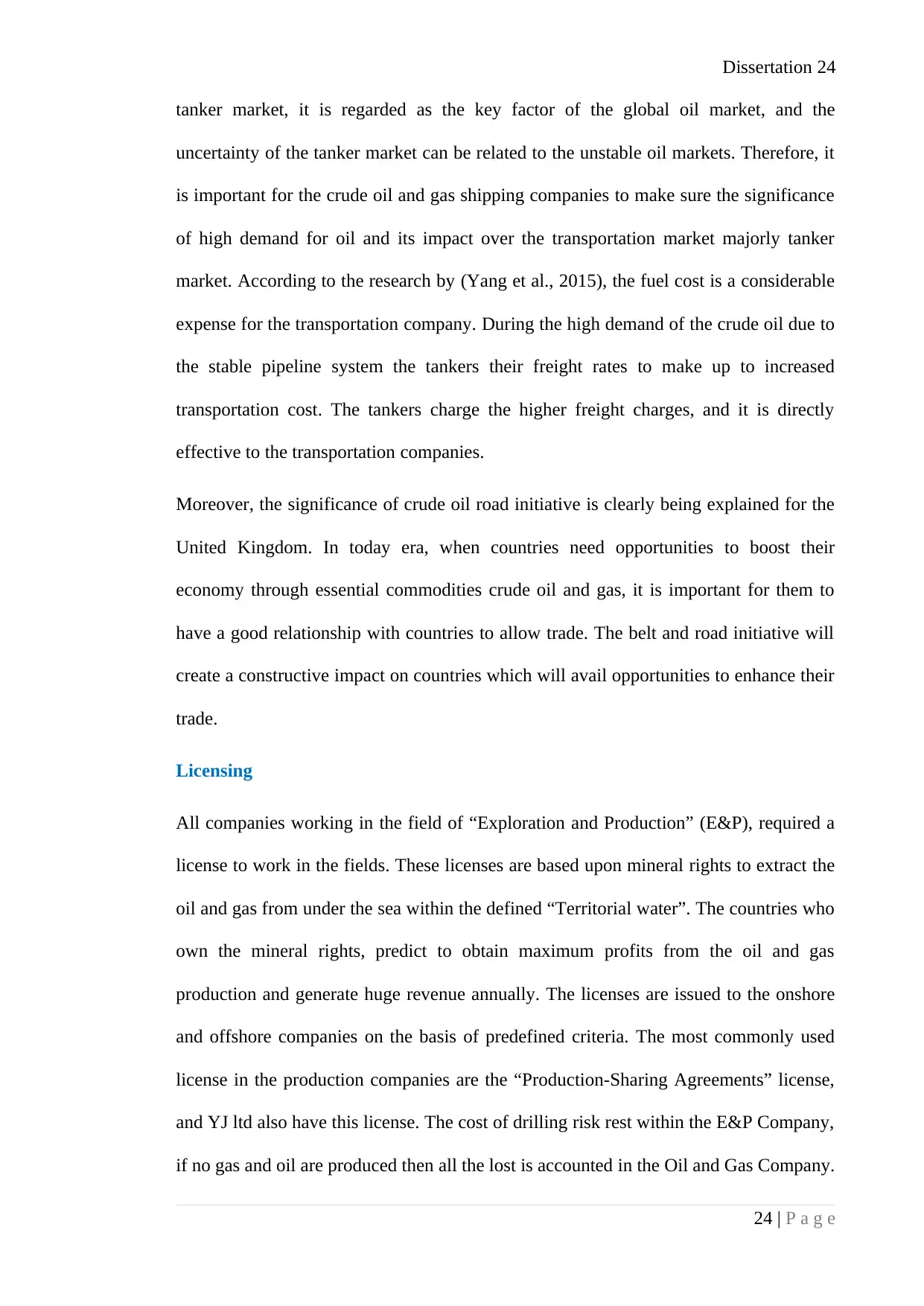
Dissertation 24
tanker market, it is regarded as the key factor of the global oil market, and the
uncertainty of the tanker market can be related to the unstable oil markets. Therefore, it
is important for the crude oil and gas shipping companies to make sure the significance
of high demand for oil and its impact over the transportation market majorly tanker
market. According to the research by (Yang et al., 2015), the fuel cost is a considerable
expense for the transportation company. During the high demand of the crude oil due to
the stable pipeline system the tankers their freight rates to make up to increased
transportation cost. The tankers charge the higher freight charges, and it is directly
effective to the transportation companies.
Moreover, the significance of crude oil road initiative is clearly being explained for the
United Kingdom. In today era, when countries need opportunities to boost their
economy through essential commodities crude oil and gas, it is important for them to
have a good relationship with countries to allow trade. The belt and road initiative will
create a constructive impact on countries which will avail opportunities to enhance their
trade.
Licensing
All companies working in the field of “Exploration and Production” (E&P), required a
license to work in the fields. These licenses are based upon mineral rights to extract the
oil and gas from under the sea within the defined “Territorial water”. The countries who
own the mineral rights, predict to obtain maximum profits from the oil and gas
production and generate huge revenue annually. The licenses are issued to the onshore
and offshore companies on the basis of predefined criteria. The most commonly used
license in the production companies are the “Production-Sharing Agreements” license,
and YJ ltd also have this license. The cost of drilling risk rest within the E&P Company,
if no gas and oil are produced then all the lost is accounted in the Oil and Gas Company.
24 | P a g e
tanker market, it is regarded as the key factor of the global oil market, and the
uncertainty of the tanker market can be related to the unstable oil markets. Therefore, it
is important for the crude oil and gas shipping companies to make sure the significance
of high demand for oil and its impact over the transportation market majorly tanker
market. According to the research by (Yang et al., 2015), the fuel cost is a considerable
expense for the transportation company. During the high demand of the crude oil due to
the stable pipeline system the tankers their freight rates to make up to increased
transportation cost. The tankers charge the higher freight charges, and it is directly
effective to the transportation companies.
Moreover, the significance of crude oil road initiative is clearly being explained for the
United Kingdom. In today era, when countries need opportunities to boost their
economy through essential commodities crude oil and gas, it is important for them to
have a good relationship with countries to allow trade. The belt and road initiative will
create a constructive impact on countries which will avail opportunities to enhance their
trade.
Licensing
All companies working in the field of “Exploration and Production” (E&P), required a
license to work in the fields. These licenses are based upon mineral rights to extract the
oil and gas from under the sea within the defined “Territorial water”. The countries who
own the mineral rights, predict to obtain maximum profits from the oil and gas
production and generate huge revenue annually. The licenses are issued to the onshore
and offshore companies on the basis of predefined criteria. The most commonly used
license in the production companies are the “Production-Sharing Agreements” license,
and YJ ltd also have this license. The cost of drilling risk rest within the E&P Company,
if no gas and oil are produced then all the lost is accounted in the Oil and Gas Company.
24 | P a g e
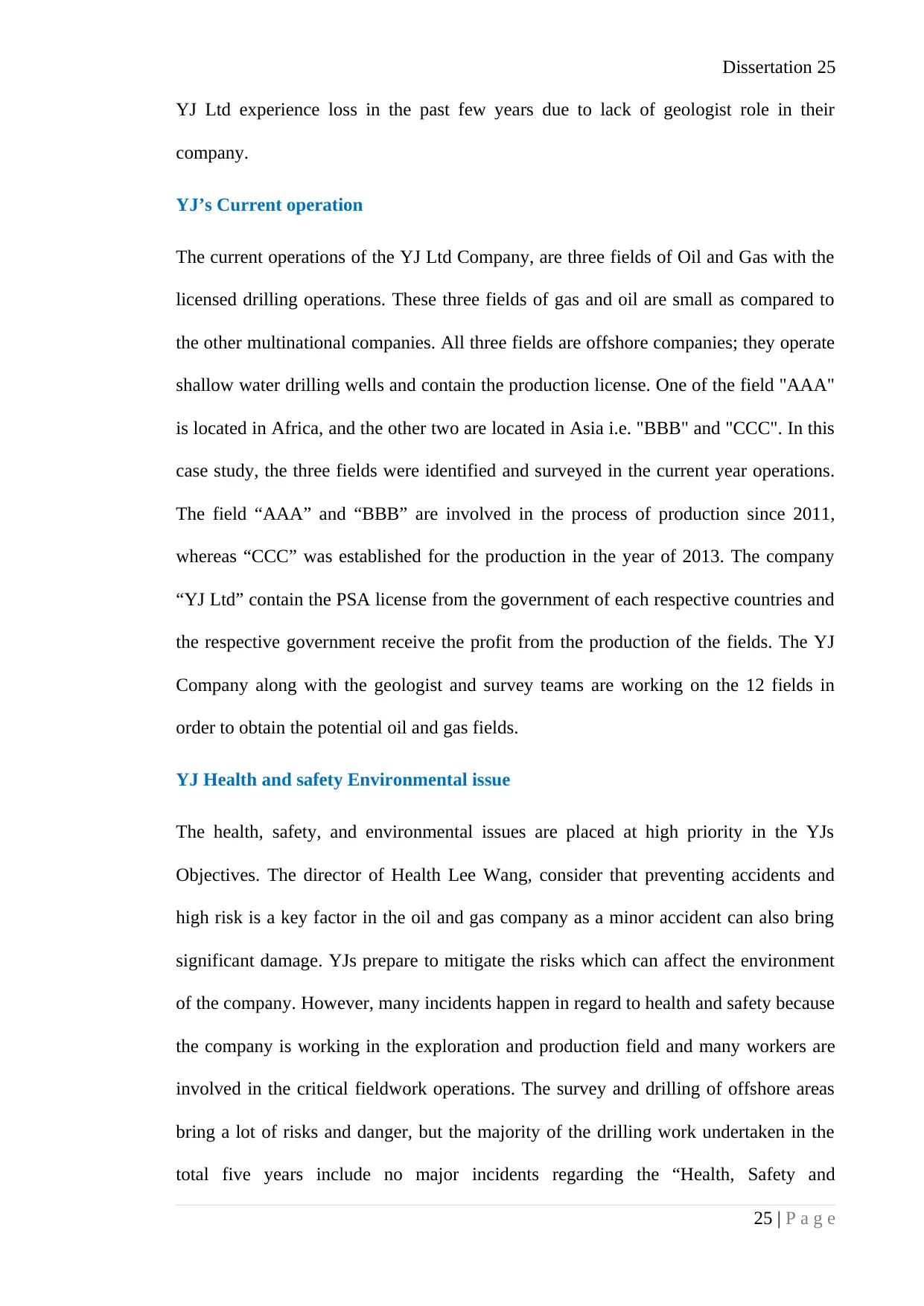
Dissertation 25
YJ Ltd experience loss in the past few years due to lack of geologist role in their
company.
YJ’s Current operation
The current operations of the YJ Ltd Company, are three fields of Oil and Gas with the
licensed drilling operations. These three fields of gas and oil are small as compared to
the other multinational companies. All three fields are offshore companies; they operate
shallow water drilling wells and contain the production license. One of the field "AAA"
is located in Africa, and the other two are located in Asia i.e. "BBB" and "CCC". In this
case study, the three fields were identified and surveyed in the current year operations.
The field “AAA” and “BBB” are involved in the process of production since 2011,
whereas “CCC” was established for the production in the year of 2013. The company
“YJ Ltd” contain the PSA license from the government of each respective countries and
the respective government receive the profit from the production of the fields. The YJ
Company along with the geologist and survey teams are working on the 12 fields in
order to obtain the potential oil and gas fields.
YJ Health and safety Environmental issue
The health, safety, and environmental issues are placed at high priority in the YJs
Objectives. The director of Health Lee Wang, consider that preventing accidents and
high risk is a key factor in the oil and gas company as a minor accident can also bring
significant damage. YJs prepare to mitigate the risks which can affect the environment
of the company. However, many incidents happen in regard to health and safety because
the company is working in the exploration and production field and many workers are
involved in the critical fieldwork operations. The survey and drilling of offshore areas
bring a lot of risks and danger, but the majority of the drilling work undertaken in the
total five years include no major incidents regarding the “Health, Safety and
25 | P a g e
YJ Ltd experience loss in the past few years due to lack of geologist role in their
company.
YJ’s Current operation
The current operations of the YJ Ltd Company, are three fields of Oil and Gas with the
licensed drilling operations. These three fields of gas and oil are small as compared to
the other multinational companies. All three fields are offshore companies; they operate
shallow water drilling wells and contain the production license. One of the field "AAA"
is located in Africa, and the other two are located in Asia i.e. "BBB" and "CCC". In this
case study, the three fields were identified and surveyed in the current year operations.
The field “AAA” and “BBB” are involved in the process of production since 2011,
whereas “CCC” was established for the production in the year of 2013. The company
“YJ Ltd” contain the PSA license from the government of each respective countries and
the respective government receive the profit from the production of the fields. The YJ
Company along with the geologist and survey teams are working on the 12 fields in
order to obtain the potential oil and gas fields.
YJ Health and safety Environmental issue
The health, safety, and environmental issues are placed at high priority in the YJs
Objectives. The director of Health Lee Wang, consider that preventing accidents and
high risk is a key factor in the oil and gas company as a minor accident can also bring
significant damage. YJs prepare to mitigate the risks which can affect the environment
of the company. However, many incidents happen in regard to health and safety because
the company is working in the exploration and production field and many workers are
involved in the critical fieldwork operations. The survey and drilling of offshore areas
bring a lot of risks and danger, but the majority of the drilling work undertaken in the
total five years include no major incidents regarding the “Health, Safety and
25 | P a g e
Paraphrase This Document
Need a fresh take? Get an instant paraphrase of this document with our AI Paraphraser
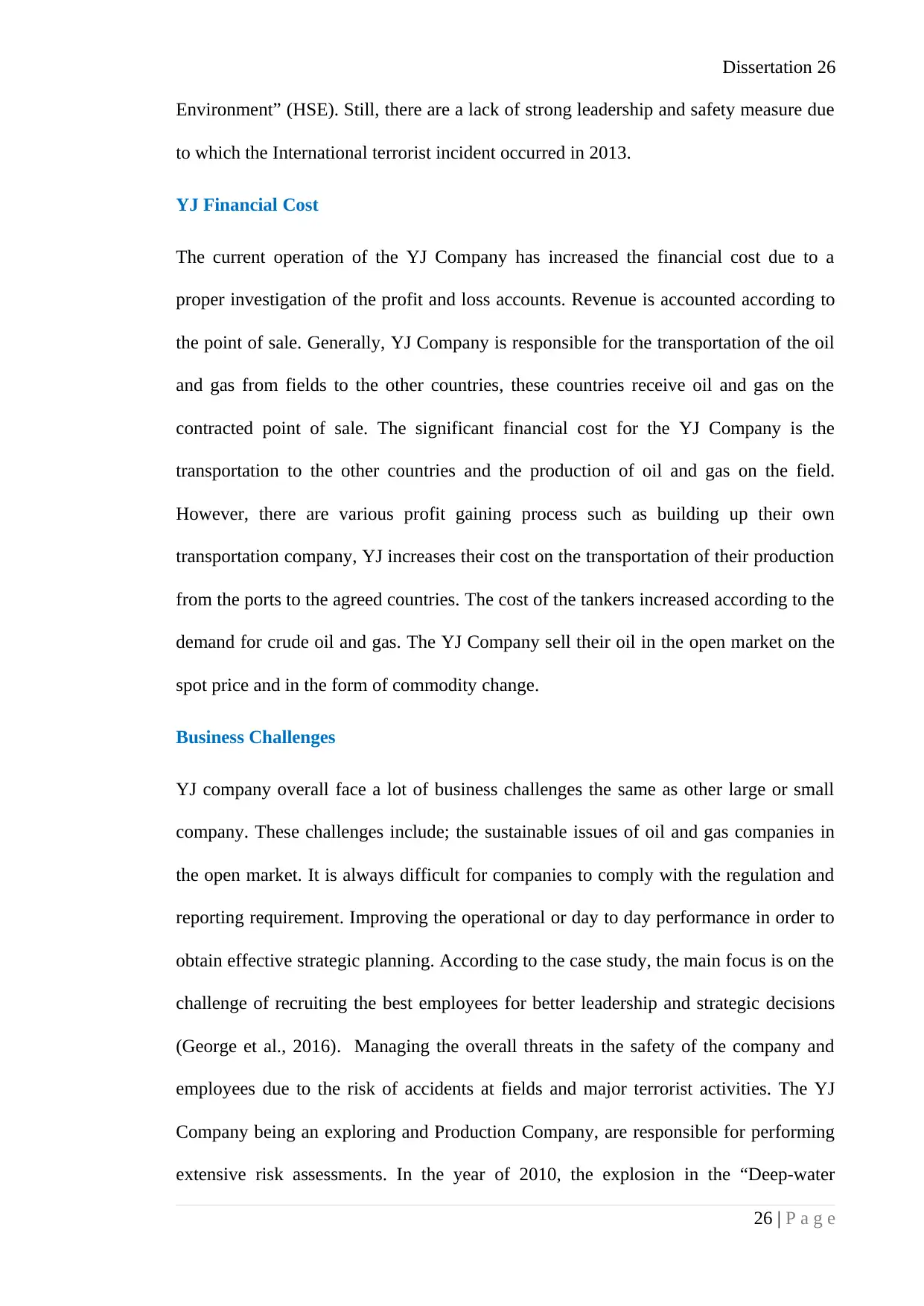
Dissertation 26
Environment” (HSE). Still, there are a lack of strong leadership and safety measure due
to which the International terrorist incident occurred in 2013.
YJ Financial Cost
The current operation of the YJ Company has increased the financial cost due to a
proper investigation of the profit and loss accounts. Revenue is accounted according to
the point of sale. Generally, YJ Company is responsible for the transportation of the oil
and gas from fields to the other countries, these countries receive oil and gas on the
contracted point of sale. The significant financial cost for the YJ Company is the
transportation to the other countries and the production of oil and gas on the field.
However, there are various profit gaining process such as building up their own
transportation company, YJ increases their cost on the transportation of their production
from the ports to the agreed countries. The cost of the tankers increased according to the
demand for crude oil and gas. The YJ Company sell their oil in the open market on the
spot price and in the form of commodity change.
Business Challenges
YJ company overall face a lot of business challenges the same as other large or small
company. These challenges include; the sustainable issues of oil and gas companies in
the open market. It is always difficult for companies to comply with the regulation and
reporting requirement. Improving the operational or day to day performance in order to
obtain effective strategic planning. According to the case study, the main focus is on the
challenge of recruiting the best employees for better leadership and strategic decisions
(George et al., 2016). Managing the overall threats in the safety of the company and
employees due to the risk of accidents at fields and major terrorist activities. The YJ
Company being an exploring and Production Company, are responsible for performing
extensive risk assessments. In the year of 2010, the explosion in the “Deep-water
26 | P a g e
Environment” (HSE). Still, there are a lack of strong leadership and safety measure due
to which the International terrorist incident occurred in 2013.
YJ Financial Cost
The current operation of the YJ Company has increased the financial cost due to a
proper investigation of the profit and loss accounts. Revenue is accounted according to
the point of sale. Generally, YJ Company is responsible for the transportation of the oil
and gas from fields to the other countries, these countries receive oil and gas on the
contracted point of sale. The significant financial cost for the YJ Company is the
transportation to the other countries and the production of oil and gas on the field.
However, there are various profit gaining process such as building up their own
transportation company, YJ increases their cost on the transportation of their production
from the ports to the agreed countries. The cost of the tankers increased according to the
demand for crude oil and gas. The YJ Company sell their oil in the open market on the
spot price and in the form of commodity change.
Business Challenges
YJ company overall face a lot of business challenges the same as other large or small
company. These challenges include; the sustainable issues of oil and gas companies in
the open market. It is always difficult for companies to comply with the regulation and
reporting requirement. Improving the operational or day to day performance in order to
obtain effective strategic planning. According to the case study, the main focus is on the
challenge of recruiting the best employees for better leadership and strategic decisions
(George et al., 2016). Managing the overall threats in the safety of the company and
employees due to the risk of accidents at fields and major terrorist activities. The YJ
Company being an exploring and Production Company, are responsible for performing
extensive risk assessments. In the year of 2010, the explosion in the “Deep-water
26 | P a g e
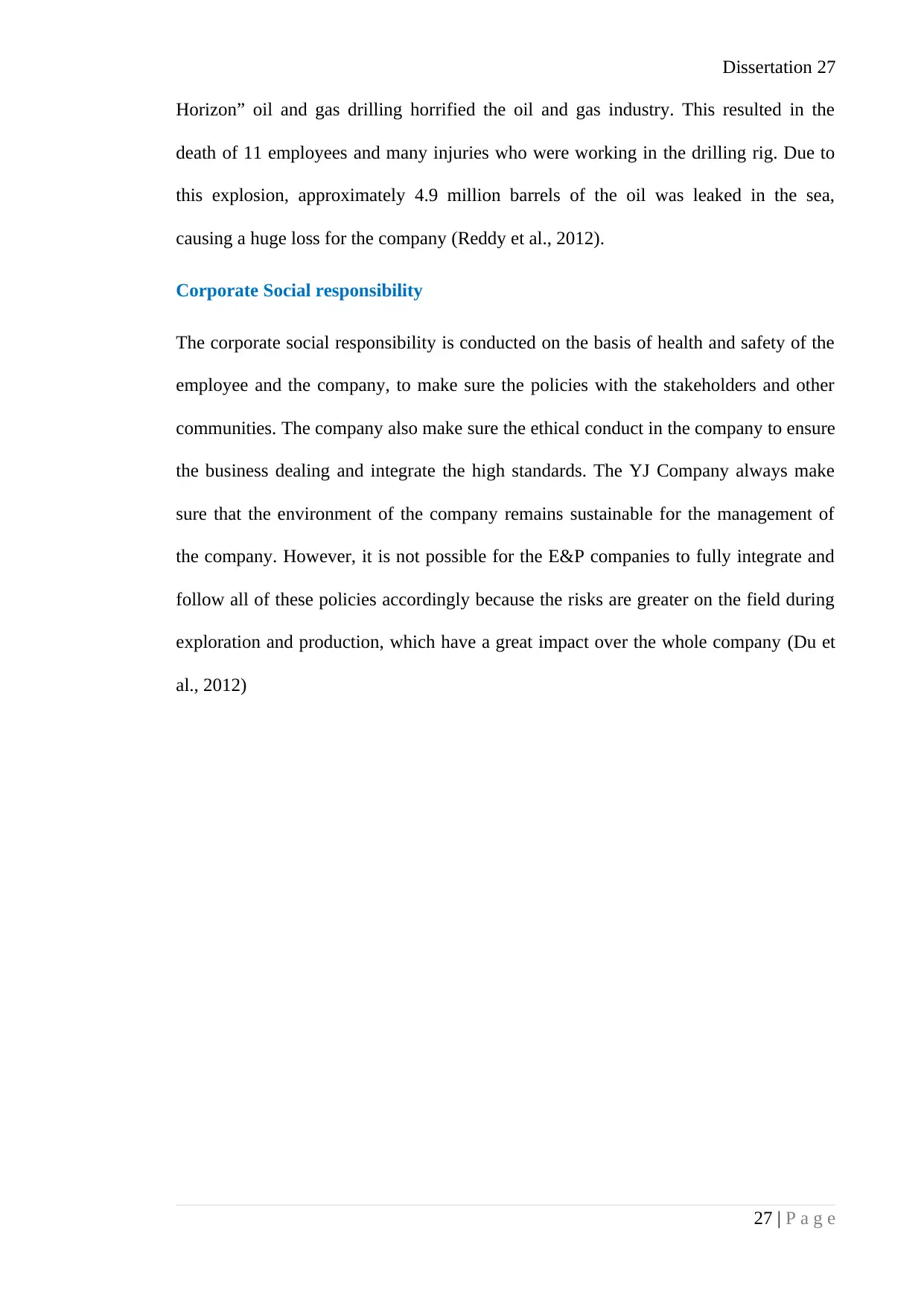
Dissertation 27
Horizon” oil and gas drilling horrified the oil and gas industry. This resulted in the
death of 11 employees and many injuries who were working in the drilling rig. Due to
this explosion, approximately 4.9 million barrels of the oil was leaked in the sea,
causing a huge loss for the company (Reddy et al., 2012).
Corporate Social responsibility
The corporate social responsibility is conducted on the basis of health and safety of the
employee and the company, to make sure the policies with the stakeholders and other
communities. The company also make sure the ethical conduct in the company to ensure
the business dealing and integrate the high standards. The YJ Company always make
sure that the environment of the company remains sustainable for the management of
the company. However, it is not possible for the E&P companies to fully integrate and
follow all of these policies accordingly because the risks are greater on the field during
exploration and production, which have a great impact over the whole company (Du et
al., 2012)
27 | P a g e
Horizon” oil and gas drilling horrified the oil and gas industry. This resulted in the
death of 11 employees and many injuries who were working in the drilling rig. Due to
this explosion, approximately 4.9 million barrels of the oil was leaked in the sea,
causing a huge loss for the company (Reddy et al., 2012).
Corporate Social responsibility
The corporate social responsibility is conducted on the basis of health and safety of the
employee and the company, to make sure the policies with the stakeholders and other
communities. The company also make sure the ethical conduct in the company to ensure
the business dealing and integrate the high standards. The YJ Company always make
sure that the environment of the company remains sustainable for the management of
the company. However, it is not possible for the E&P companies to fully integrate and
follow all of these policies accordingly because the risks are greater on the field during
exploration and production, which have a great impact over the whole company (Du et
al., 2012)
27 | P a g e
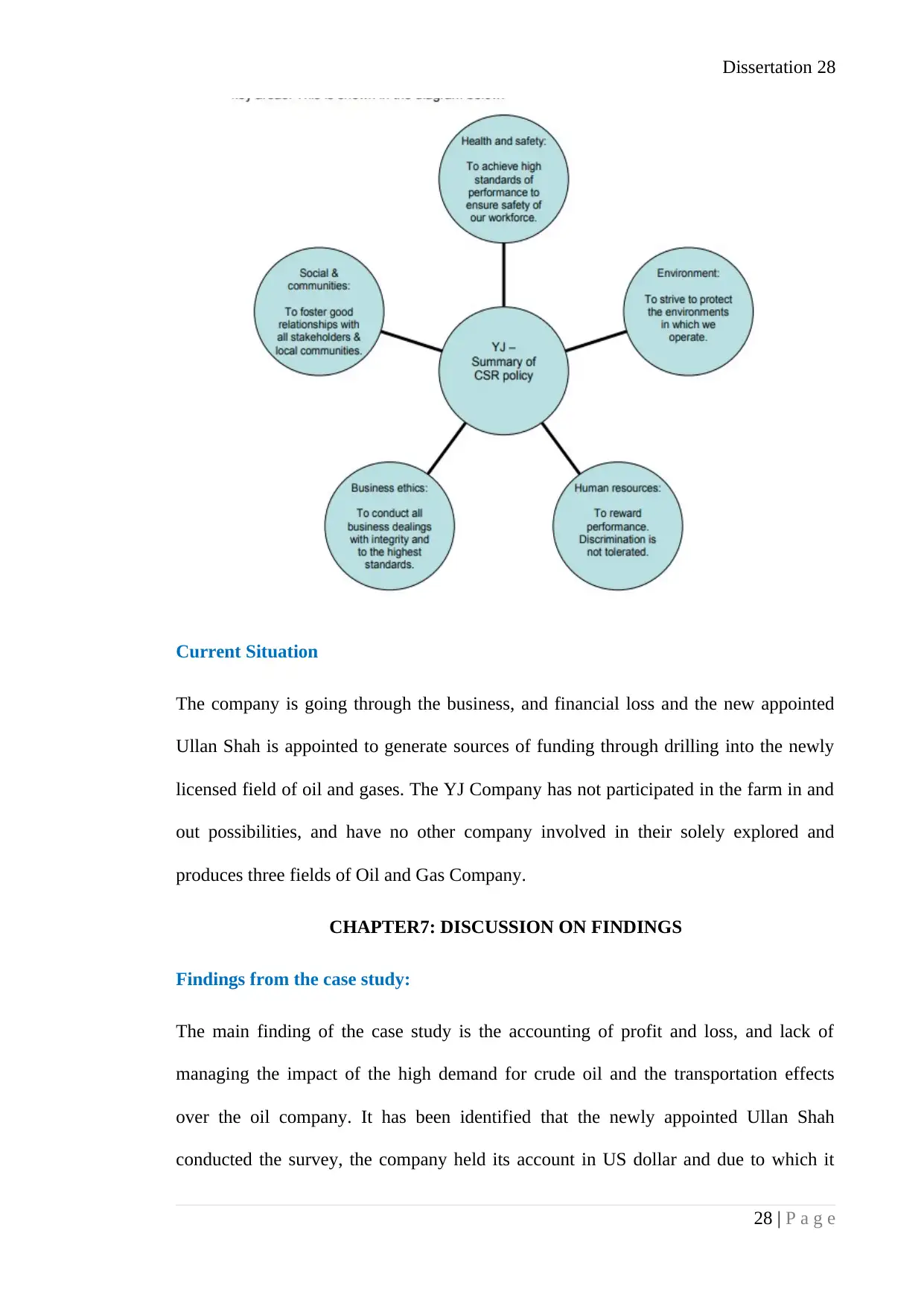
Dissertation 28
Current Situation
The company is going through the business, and financial loss and the new appointed
Ullan Shah is appointed to generate sources of funding through drilling into the newly
licensed field of oil and gases. The YJ Company has not participated in the farm in and
out possibilities, and have no other company involved in their solely explored and
produces three fields of Oil and Gas Company.
CHAPTER7: DISCUSSION ON FINDINGS
Findings from the case study:
The main finding of the case study is the accounting of profit and loss, and lack of
managing the impact of the high demand for crude oil and the transportation effects
over the oil company. It has been identified that the newly appointed Ullan Shah
conducted the survey, the company held its account in US dollar and due to which it
28 | P a g e
Current Situation
The company is going through the business, and financial loss and the new appointed
Ullan Shah is appointed to generate sources of funding through drilling into the newly
licensed field of oil and gases. The YJ Company has not participated in the farm in and
out possibilities, and have no other company involved in their solely explored and
produces three fields of Oil and Gas Company.
CHAPTER7: DISCUSSION ON FINDINGS
Findings from the case study:
The main finding of the case study is the accounting of profit and loss, and lack of
managing the impact of the high demand for crude oil and the transportation effects
over the oil company. It has been identified that the newly appointed Ullan Shah
conducted the survey, the company held its account in US dollar and due to which it
28 | P a g e
Secure Best Marks with AI Grader
Need help grading? Try our AI Grader for instant feedback on your assignments.
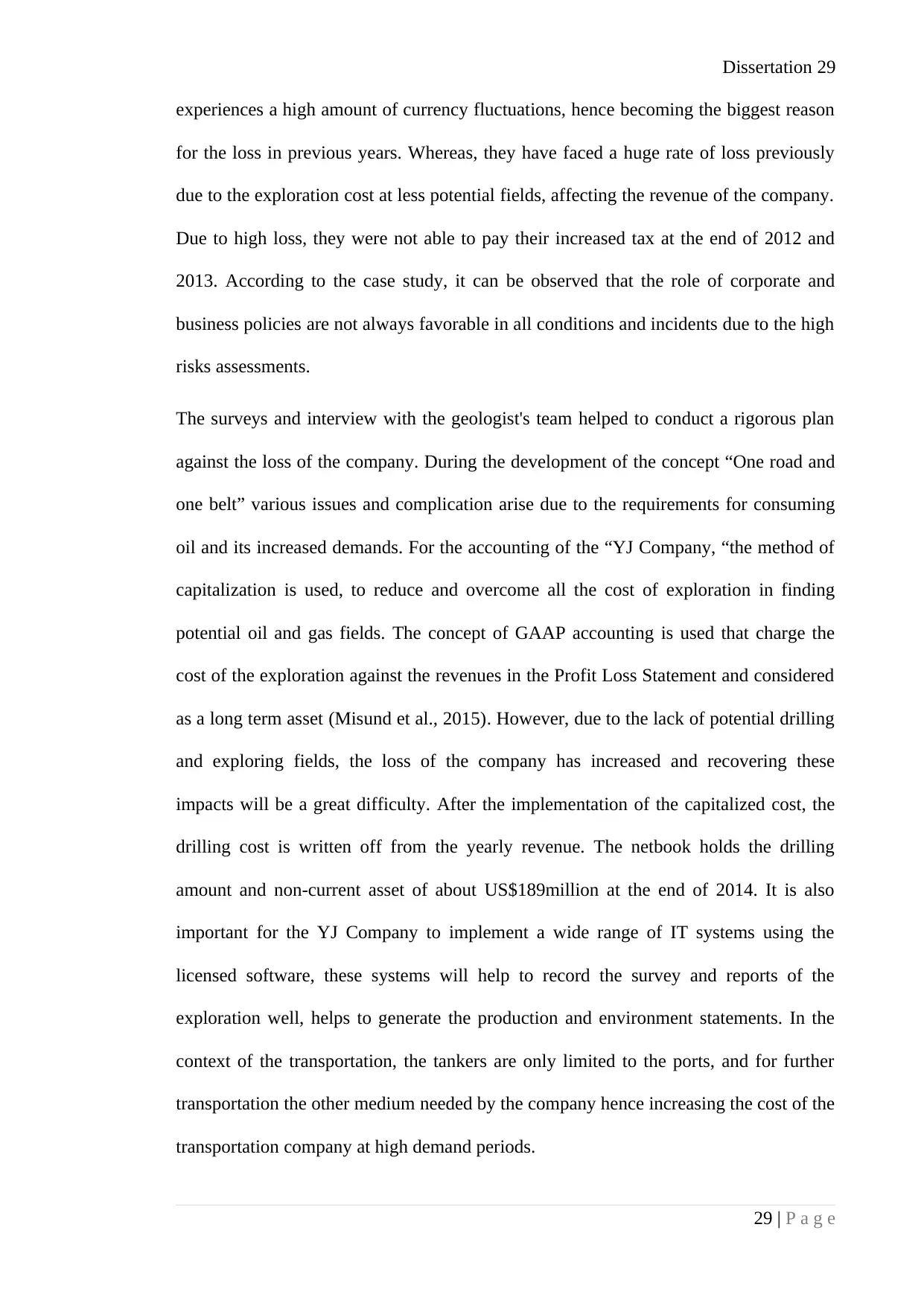
Dissertation 29
experiences a high amount of currency fluctuations, hence becoming the biggest reason
for the loss in previous years. Whereas, they have faced a huge rate of loss previously
due to the exploration cost at less potential fields, affecting the revenue of the company.
Due to high loss, they were not able to pay their increased tax at the end of 2012 and
2013. According to the case study, it can be observed that the role of corporate and
business policies are not always favorable in all conditions and incidents due to the high
risks assessments.
The surveys and interview with the geologist's team helped to conduct a rigorous plan
against the loss of the company. During the development of the concept “One road and
one belt” various issues and complication arise due to the requirements for consuming
oil and its increased demands. For the accounting of the “YJ Company, “the method of
capitalization is used, to reduce and overcome all the cost of exploration in finding
potential oil and gas fields. The concept of GAAP accounting is used that charge the
cost of the exploration against the revenues in the Profit Loss Statement and considered
as a long term asset (Misund et al., 2015). However, due to the lack of potential drilling
and exploring fields, the loss of the company has increased and recovering these
impacts will be a great difficulty. After the implementation of the capitalized cost, the
drilling cost is written off from the yearly revenue. The netbook holds the drilling
amount and non-current asset of about US$189million at the end of 2014. It is also
important for the YJ Company to implement a wide range of IT systems using the
licensed software, these systems will help to record the survey and reports of the
exploration well, helps to generate the production and environment statements. In the
context of the transportation, the tankers are only limited to the ports, and for further
transportation the other medium needed by the company hence increasing the cost of the
transportation company at high demand periods.
29 | P a g e
experiences a high amount of currency fluctuations, hence becoming the biggest reason
for the loss in previous years. Whereas, they have faced a huge rate of loss previously
due to the exploration cost at less potential fields, affecting the revenue of the company.
Due to high loss, they were not able to pay their increased tax at the end of 2012 and
2013. According to the case study, it can be observed that the role of corporate and
business policies are not always favorable in all conditions and incidents due to the high
risks assessments.
The surveys and interview with the geologist's team helped to conduct a rigorous plan
against the loss of the company. During the development of the concept “One road and
one belt” various issues and complication arise due to the requirements for consuming
oil and its increased demands. For the accounting of the “YJ Company, “the method of
capitalization is used, to reduce and overcome all the cost of exploration in finding
potential oil and gas fields. The concept of GAAP accounting is used that charge the
cost of the exploration against the revenues in the Profit Loss Statement and considered
as a long term asset (Misund et al., 2015). However, due to the lack of potential drilling
and exploring fields, the loss of the company has increased and recovering these
impacts will be a great difficulty. After the implementation of the capitalized cost, the
drilling cost is written off from the yearly revenue. The netbook holds the drilling
amount and non-current asset of about US$189million at the end of 2014. It is also
important for the YJ Company to implement a wide range of IT systems using the
licensed software, these systems will help to record the survey and reports of the
exploration well, helps to generate the production and environment statements. In the
context of the transportation, the tankers are only limited to the ports, and for further
transportation the other medium needed by the company hence increasing the cost of the
transportation company at high demand periods.
29 | P a g e
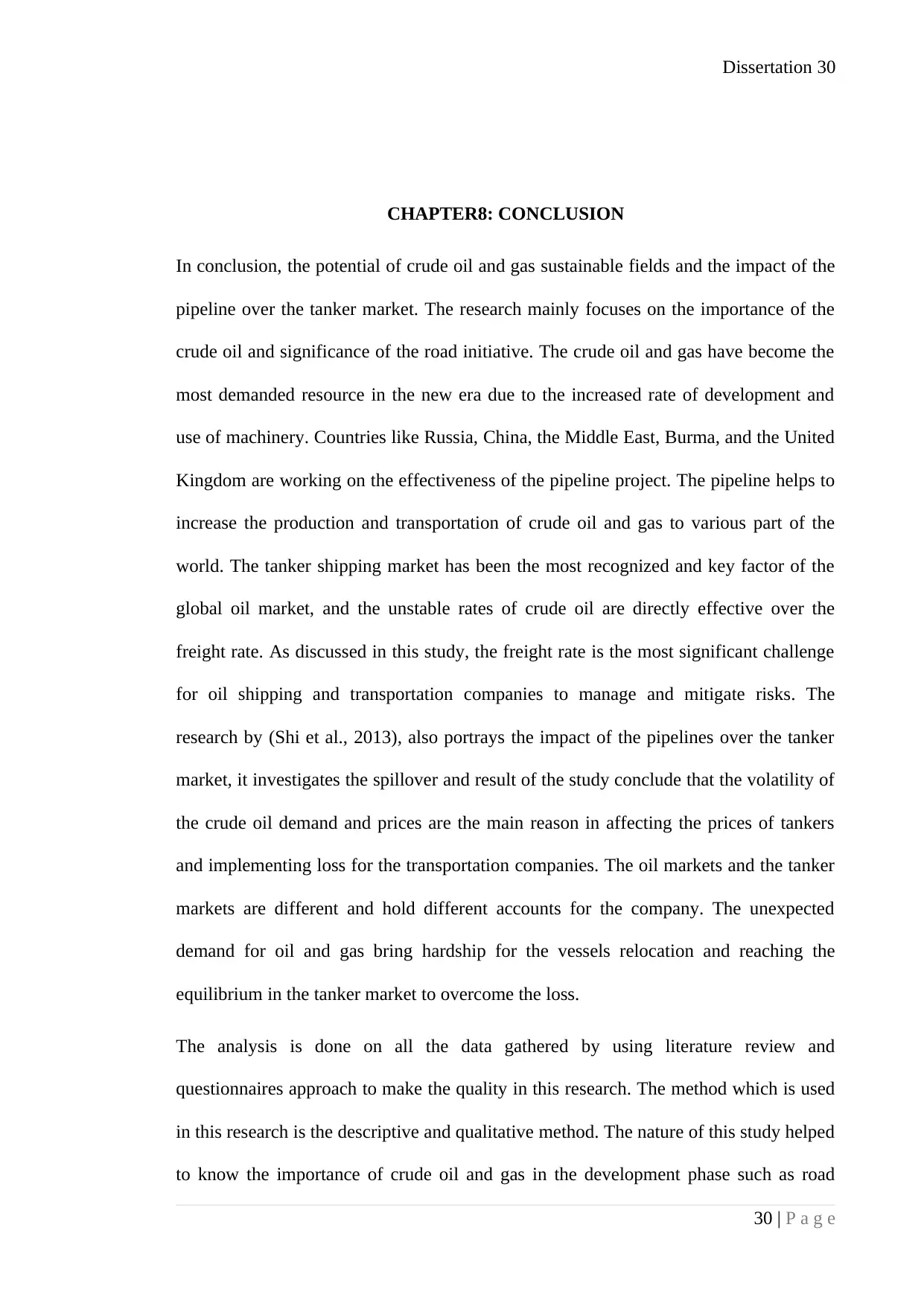
Dissertation 30
CHAPTER8: CONCLUSION
In conclusion, the potential of crude oil and gas sustainable fields and the impact of the
pipeline over the tanker market. The research mainly focuses on the importance of the
crude oil and significance of the road initiative. The crude oil and gas have become the
most demanded resource in the new era due to the increased rate of development and
use of machinery. Countries like Russia, China, the Middle East, Burma, and the United
Kingdom are working on the effectiveness of the pipeline project. The pipeline helps to
increase the production and transportation of crude oil and gas to various part of the
world. The tanker shipping market has been the most recognized and key factor of the
global oil market, and the unstable rates of crude oil are directly effective over the
freight rate. As discussed in this study, the freight rate is the most significant challenge
for oil shipping and transportation companies to manage and mitigate risks. The
research by (Shi et al., 2013), also portrays the impact of the pipelines over the tanker
market, it investigates the spillover and result of the study conclude that the volatility of
the crude oil demand and prices are the main reason in affecting the prices of tankers
and implementing loss for the transportation companies. The oil markets and the tanker
markets are different and hold different accounts for the company. The unexpected
demand for oil and gas bring hardship for the vessels relocation and reaching the
equilibrium in the tanker market to overcome the loss.
The analysis is done on all the data gathered by using literature review and
questionnaires approach to make the quality in this research. The method which is used
in this research is the descriptive and qualitative method. The nature of this study helped
to know the importance of crude oil and gas in the development phase such as road
30 | P a g e
CHAPTER8: CONCLUSION
In conclusion, the potential of crude oil and gas sustainable fields and the impact of the
pipeline over the tanker market. The research mainly focuses on the importance of the
crude oil and significance of the road initiative. The crude oil and gas have become the
most demanded resource in the new era due to the increased rate of development and
use of machinery. Countries like Russia, China, the Middle East, Burma, and the United
Kingdom are working on the effectiveness of the pipeline project. The pipeline helps to
increase the production and transportation of crude oil and gas to various part of the
world. The tanker shipping market has been the most recognized and key factor of the
global oil market, and the unstable rates of crude oil are directly effective over the
freight rate. As discussed in this study, the freight rate is the most significant challenge
for oil shipping and transportation companies to manage and mitigate risks. The
research by (Shi et al., 2013), also portrays the impact of the pipelines over the tanker
market, it investigates the spillover and result of the study conclude that the volatility of
the crude oil demand and prices are the main reason in affecting the prices of tankers
and implementing loss for the transportation companies. The oil markets and the tanker
markets are different and hold different accounts for the company. The unexpected
demand for oil and gas bring hardship for the vessels relocation and reaching the
equilibrium in the tanker market to overcome the loss.
The analysis is done on all the data gathered by using literature review and
questionnaires approach to make the quality in this research. The method which is used
in this research is the descriptive and qualitative method. The nature of this study helped
to know the importance of crude oil and gas in the development phase such as road
30 | P a g e
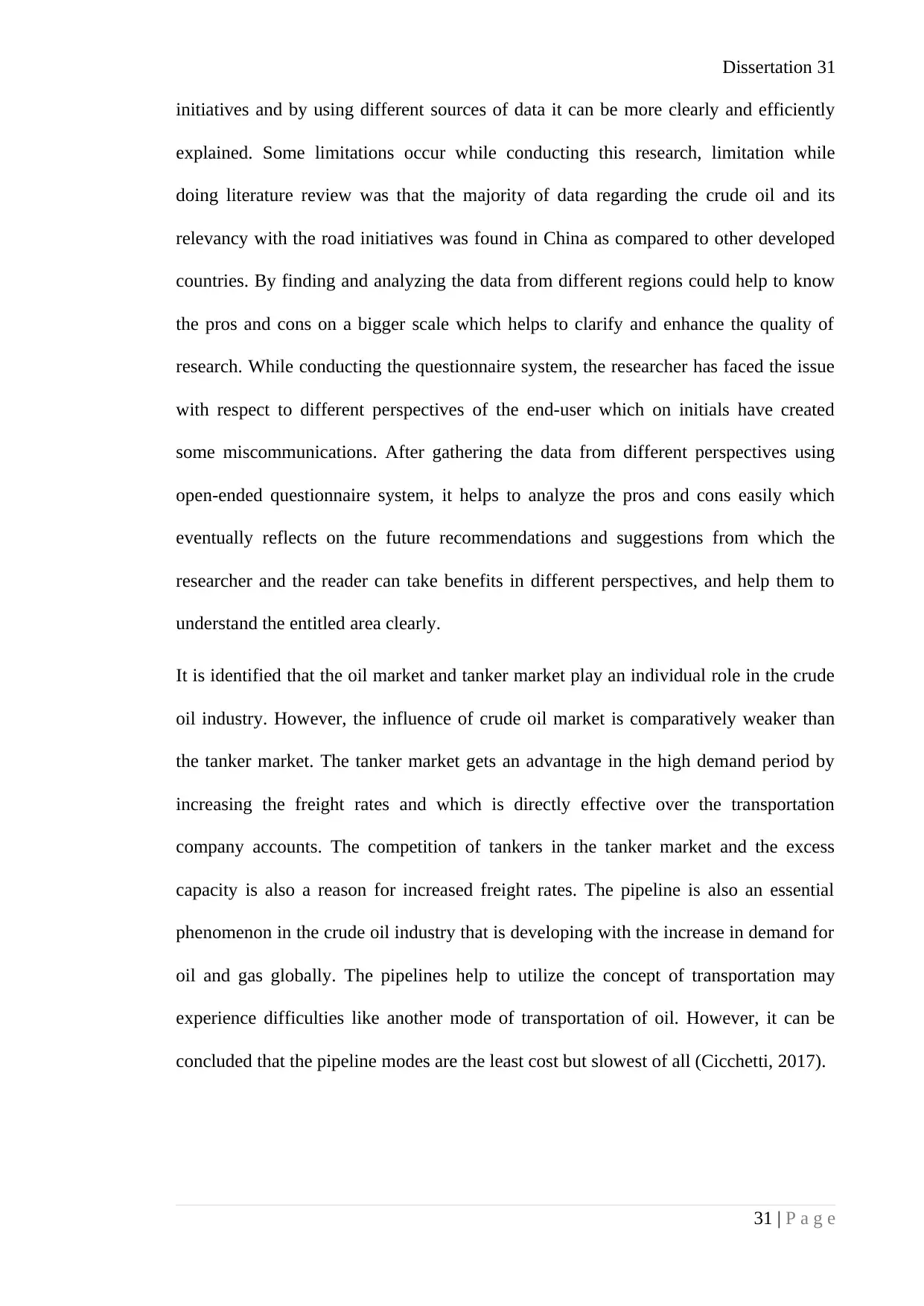
Dissertation 31
initiatives and by using different sources of data it can be more clearly and efficiently
explained. Some limitations occur while conducting this research, limitation while
doing literature review was that the majority of data regarding the crude oil and its
relevancy with the road initiatives was found in China as compared to other developed
countries. By finding and analyzing the data from different regions could help to know
the pros and cons on a bigger scale which helps to clarify and enhance the quality of
research. While conducting the questionnaire system, the researcher has faced the issue
with respect to different perspectives of the end-user which on initials have created
some miscommunications. After gathering the data from different perspectives using
open-ended questionnaire system, it helps to analyze the pros and cons easily which
eventually reflects on the future recommendations and suggestions from which the
researcher and the reader can take benefits in different perspectives, and help them to
understand the entitled area clearly.
It is identified that the oil market and tanker market play an individual role in the crude
oil industry. However, the influence of crude oil market is comparatively weaker than
the tanker market. The tanker market gets an advantage in the high demand period by
increasing the freight rates and which is directly effective over the transportation
company accounts. The competition of tankers in the tanker market and the excess
capacity is also a reason for increased freight rates. The pipeline is also an essential
phenomenon in the crude oil industry that is developing with the increase in demand for
oil and gas globally. The pipelines help to utilize the concept of transportation may
experience difficulties like another mode of transportation of oil. However, it can be
concluded that the pipeline modes are the least cost but slowest of all (Cicchetti, 2017).
31 | P a g e
initiatives and by using different sources of data it can be more clearly and efficiently
explained. Some limitations occur while conducting this research, limitation while
doing literature review was that the majority of data regarding the crude oil and its
relevancy with the road initiatives was found in China as compared to other developed
countries. By finding and analyzing the data from different regions could help to know
the pros and cons on a bigger scale which helps to clarify and enhance the quality of
research. While conducting the questionnaire system, the researcher has faced the issue
with respect to different perspectives of the end-user which on initials have created
some miscommunications. After gathering the data from different perspectives using
open-ended questionnaire system, it helps to analyze the pros and cons easily which
eventually reflects on the future recommendations and suggestions from which the
researcher and the reader can take benefits in different perspectives, and help them to
understand the entitled area clearly.
It is identified that the oil market and tanker market play an individual role in the crude
oil industry. However, the influence of crude oil market is comparatively weaker than
the tanker market. The tanker market gets an advantage in the high demand period by
increasing the freight rates and which is directly effective over the transportation
company accounts. The competition of tankers in the tanker market and the excess
capacity is also a reason for increased freight rates. The pipeline is also an essential
phenomenon in the crude oil industry that is developing with the increase in demand for
oil and gas globally. The pipelines help to utilize the concept of transportation may
experience difficulties like another mode of transportation of oil. However, it can be
concluded that the pipeline modes are the least cost but slowest of all (Cicchetti, 2017).
31 | P a g e
Paraphrase This Document
Need a fresh take? Get an instant paraphrase of this document with our AI Paraphraser

Dissertation 32
CHAPTER9: FUTURE RECOMMENDATION
In the context of the future recommendation of the crude oil and gas industry, two
directions can be used to extend the study for the future advancements. First, it is
important in the future to examine; the asymmetric effects of the oil industry, the
consequences of the spillover between the crude oil markets and the tanker markets
according to the positive and negative shocks (Li et al., 2017).
32 | P a g e
CHAPTER9: FUTURE RECOMMENDATION
In the context of the future recommendation of the crude oil and gas industry, two
directions can be used to extend the study for the future advancements. First, it is
important in the future to examine; the asymmetric effects of the oil industry, the
consequences of the spillover between the crude oil markets and the tanker markets
according to the positive and negative shocks (Li et al., 2017).
32 | P a g e
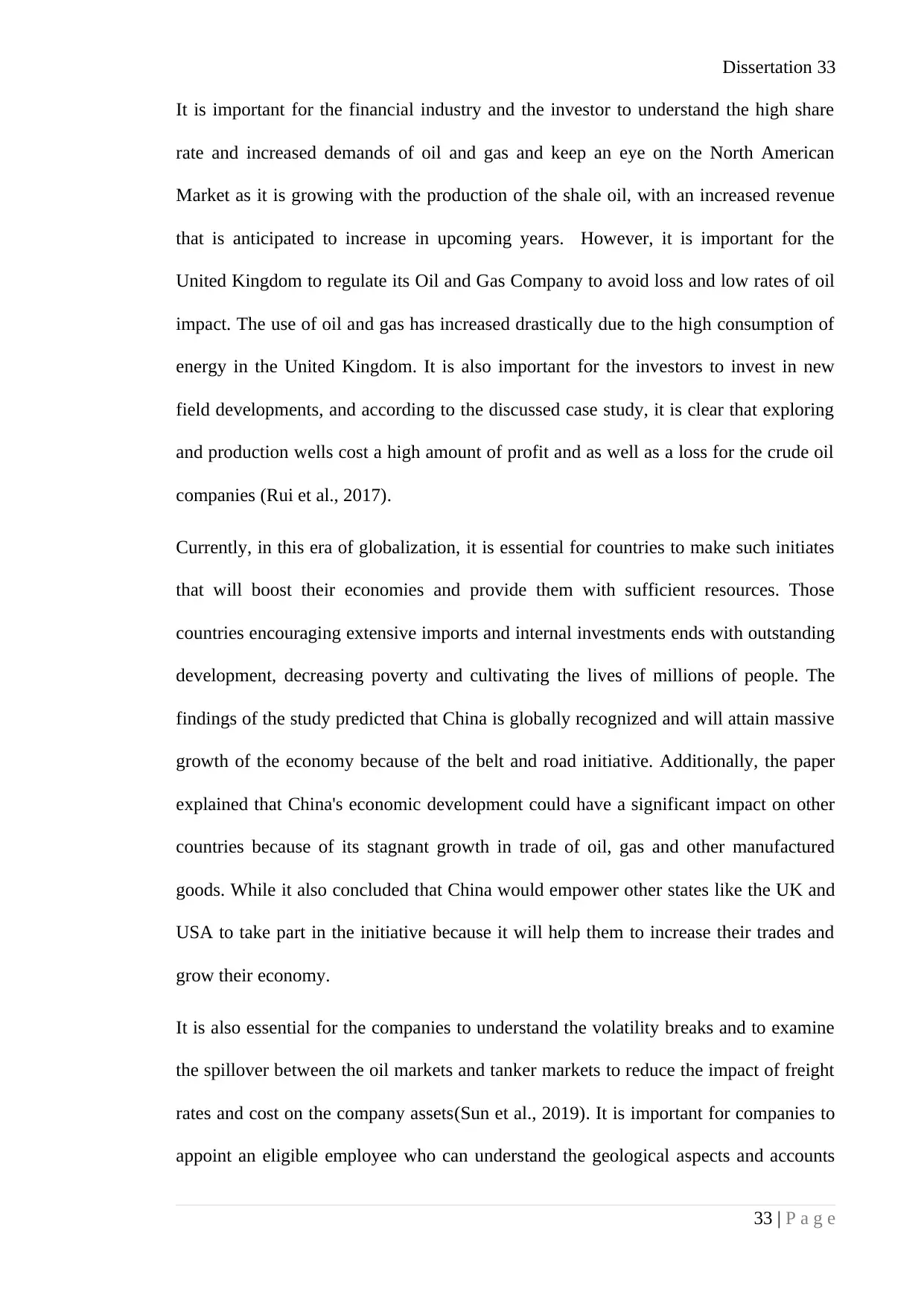
Dissertation 33
It is important for the financial industry and the investor to understand the high share
rate and increased demands of oil and gas and keep an eye on the North American
Market as it is growing with the production of the shale oil, with an increased revenue
that is anticipated to increase in upcoming years. However, it is important for the
United Kingdom to regulate its Oil and Gas Company to avoid loss and low rates of oil
impact. The use of oil and gas has increased drastically due to the high consumption of
energy in the United Kingdom. It is also important for the investors to invest in new
field developments, and according to the discussed case study, it is clear that exploring
and production wells cost a high amount of profit and as well as a loss for the crude oil
companies (Rui et al., 2017).
Currently, in this era of globalization, it is essential for countries to make such initiates
that will boost their economies and provide them with sufficient resources. Those
countries encouraging extensive imports and internal investments ends with outstanding
development, decreasing poverty and cultivating the lives of millions of people. The
findings of the study predicted that China is globally recognized and will attain massive
growth of the economy because of the belt and road initiative. Additionally, the paper
explained that China's economic development could have a significant impact on other
countries because of its stagnant growth in trade of oil, gas and other manufactured
goods. While it also concluded that China would empower other states like the UK and
USA to take part in the initiative because it will help them to increase their trades and
grow their economy.
It is also essential for the companies to understand the volatility breaks and to examine
the spillover between the oil markets and tanker markets to reduce the impact of freight
rates and cost on the company assets(Sun et al., 2019). It is important for companies to
appoint an eligible employee who can understand the geological aspects and accounts
33 | P a g e
It is important for the financial industry and the investor to understand the high share
rate and increased demands of oil and gas and keep an eye on the North American
Market as it is growing with the production of the shale oil, with an increased revenue
that is anticipated to increase in upcoming years. However, it is important for the
United Kingdom to regulate its Oil and Gas Company to avoid loss and low rates of oil
impact. The use of oil and gas has increased drastically due to the high consumption of
energy in the United Kingdom. It is also important for the investors to invest in new
field developments, and according to the discussed case study, it is clear that exploring
and production wells cost a high amount of profit and as well as a loss for the crude oil
companies (Rui et al., 2017).
Currently, in this era of globalization, it is essential for countries to make such initiates
that will boost their economies and provide them with sufficient resources. Those
countries encouraging extensive imports and internal investments ends with outstanding
development, decreasing poverty and cultivating the lives of millions of people. The
findings of the study predicted that China is globally recognized and will attain massive
growth of the economy because of the belt and road initiative. Additionally, the paper
explained that China's economic development could have a significant impact on other
countries because of its stagnant growth in trade of oil, gas and other manufactured
goods. While it also concluded that China would empower other states like the UK and
USA to take part in the initiative because it will help them to increase their trades and
grow their economy.
It is also essential for the companies to understand the volatility breaks and to examine
the spillover between the oil markets and tanker markets to reduce the impact of freight
rates and cost on the company assets(Sun et al., 2019). It is important for companies to
appoint an eligible employee who can understand the geological aspects and accounts
33 | P a g e
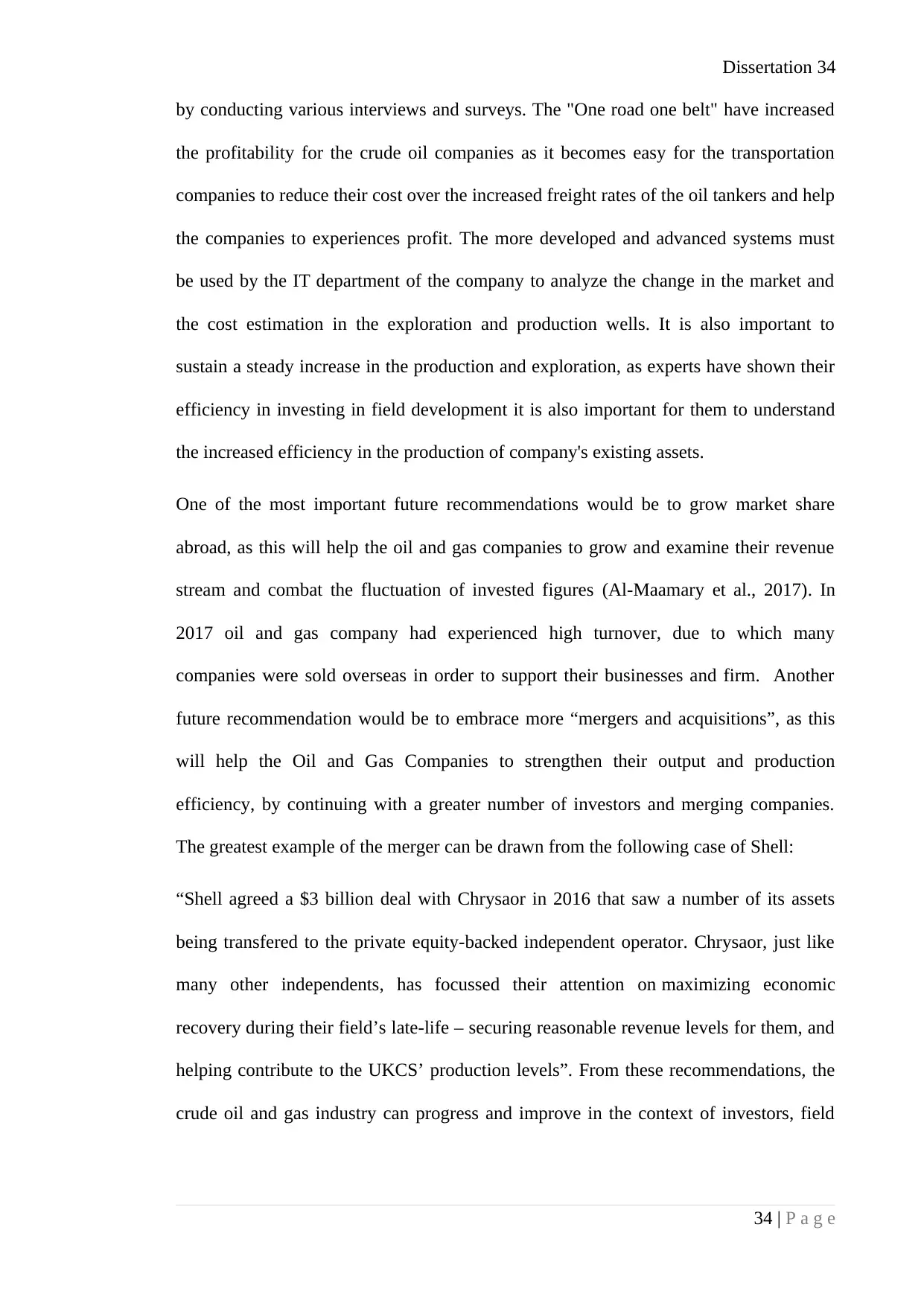
Dissertation 34
by conducting various interviews and surveys. The "One road one belt" have increased
the profitability for the crude oil companies as it becomes easy for the transportation
companies to reduce their cost over the increased freight rates of the oil tankers and help
the companies to experiences profit. The more developed and advanced systems must
be used by the IT department of the company to analyze the change in the market and
the cost estimation in the exploration and production wells. It is also important to
sustain a steady increase in the production and exploration, as experts have shown their
efficiency in investing in field development it is also important for them to understand
the increased efficiency in the production of company's existing assets.
One of the most important future recommendations would be to grow market share
abroad, as this will help the oil and gas companies to grow and examine their revenue
stream and combat the fluctuation of invested figures (Al-Maamary et al., 2017). In
2017 oil and gas company had experienced high turnover, due to which many
companies were sold overseas in order to support their businesses and firm. Another
future recommendation would be to embrace more “mergers and acquisitions”, as this
will help the Oil and Gas Companies to strengthen their output and production
efficiency, by continuing with a greater number of investors and merging companies.
The greatest example of the merger can be drawn from the following case of Shell:
“Shell agreed a $3 billion deal with Chrysaor in 2016 that saw a number of its assets
being transfered to the private equity-backed independent operator. Chrysaor, just like
many other independents, has focussed their attention on maximizing economic
recovery during their field’s late-life – securing reasonable revenue levels for them, and
helping contribute to the UKCS’ production levels”. From these recommendations, the
crude oil and gas industry can progress and improve in the context of investors, field
34 | P a g e
by conducting various interviews and surveys. The "One road one belt" have increased
the profitability for the crude oil companies as it becomes easy for the transportation
companies to reduce their cost over the increased freight rates of the oil tankers and help
the companies to experiences profit. The more developed and advanced systems must
be used by the IT department of the company to analyze the change in the market and
the cost estimation in the exploration and production wells. It is also important to
sustain a steady increase in the production and exploration, as experts have shown their
efficiency in investing in field development it is also important for them to understand
the increased efficiency in the production of company's existing assets.
One of the most important future recommendations would be to grow market share
abroad, as this will help the oil and gas companies to grow and examine their revenue
stream and combat the fluctuation of invested figures (Al-Maamary et al., 2017). In
2017 oil and gas company had experienced high turnover, due to which many
companies were sold overseas in order to support their businesses and firm. Another
future recommendation would be to embrace more “mergers and acquisitions”, as this
will help the Oil and Gas Companies to strengthen their output and production
efficiency, by continuing with a greater number of investors and merging companies.
The greatest example of the merger can be drawn from the following case of Shell:
“Shell agreed a $3 billion deal with Chrysaor in 2016 that saw a number of its assets
being transfered to the private equity-backed independent operator. Chrysaor, just like
many other independents, has focussed their attention on maximizing economic
recovery during their field’s late-life – securing reasonable revenue levels for them, and
helping contribute to the UKCS’ production levels”. From these recommendations, the
crude oil and gas industry can progress and improve in the context of investors, field
34 | P a g e
Secure Best Marks with AI Grader
Need help grading? Try our AI Grader for instant feedback on your assignments.
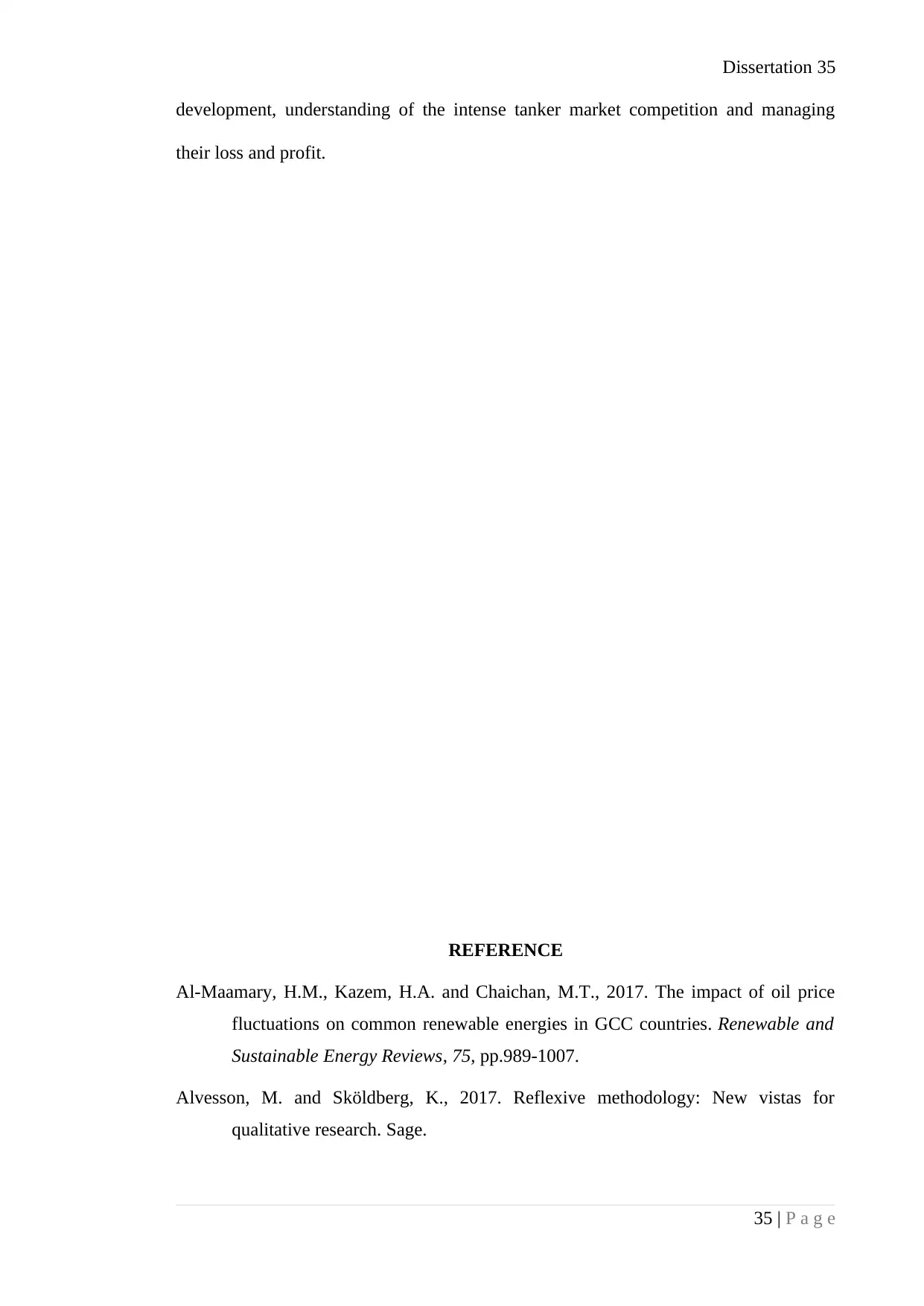
Dissertation 35
development, understanding of the intense tanker market competition and managing
their loss and profit.
REFERENCE
Al-Maamary, H.M., Kazem, H.A. and Chaichan, M.T., 2017. The impact of oil price
fluctuations on common renewable energies in GCC countries. Renewable and
Sustainable Energy Reviews, 75, pp.989-1007.
Alvesson, M. and Sköldberg, K., 2017. Reflexive methodology: New vistas for
qualitative research. Sage.
35 | P a g e
development, understanding of the intense tanker market competition and managing
their loss and profit.
REFERENCE
Al-Maamary, H.M., Kazem, H.A. and Chaichan, M.T., 2017. The impact of oil price
fluctuations on common renewable energies in GCC countries. Renewable and
Sustainable Energy Reviews, 75, pp.989-1007.
Alvesson, M. and Sköldberg, K., 2017. Reflexive methodology: New vistas for
qualitative research. Sage.
35 | P a g e
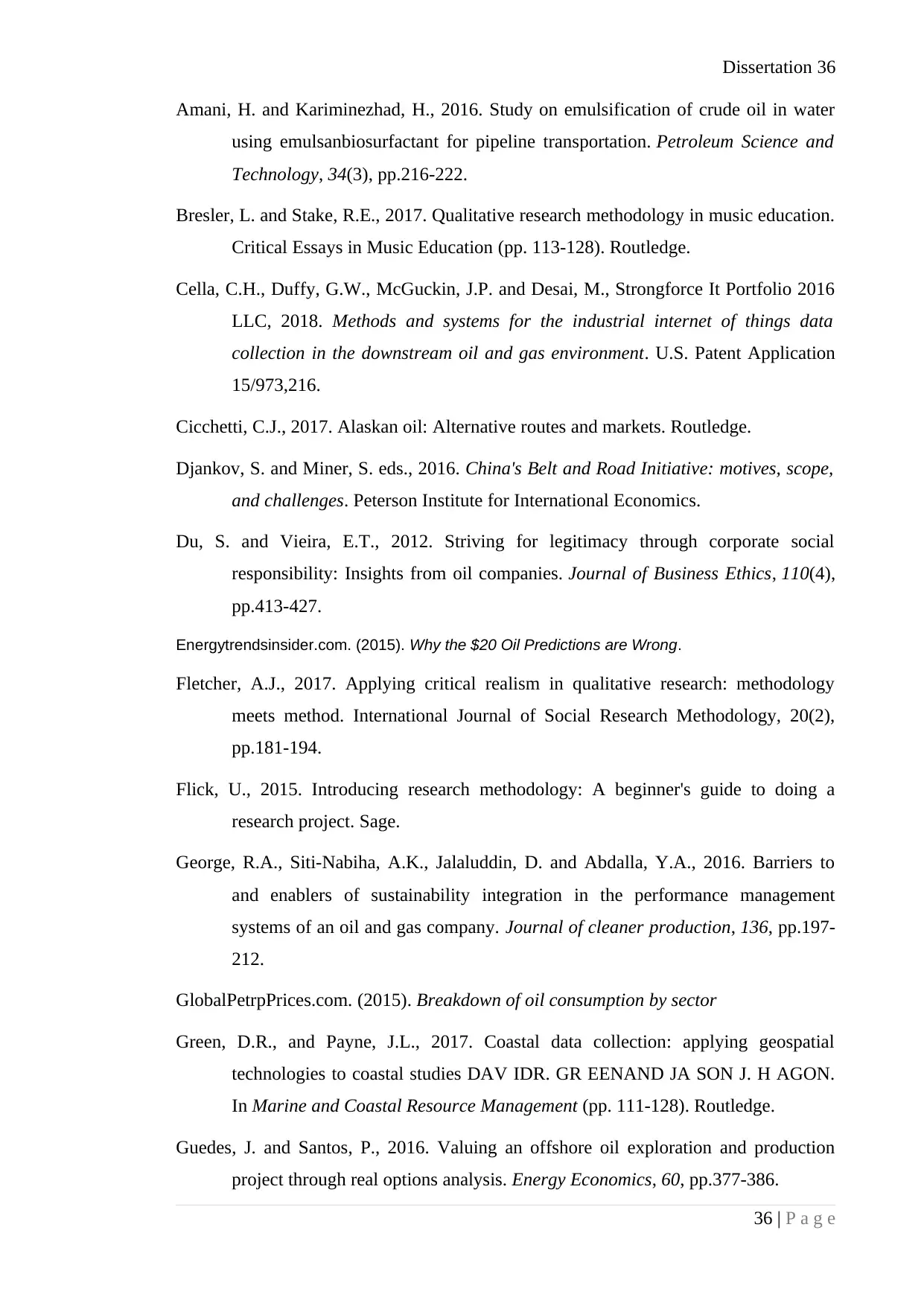
Dissertation 36
Amani, H. and Kariminezhad, H., 2016. Study on emulsification of crude oil in water
using emulsanbiosurfactant for pipeline transportation. Petroleum Science and
Technology, 34(3), pp.216-222.
Bresler, L. and Stake, R.E., 2017. Qualitative research methodology in music education.
Critical Essays in Music Education (pp. 113-128). Routledge.
Cella, C.H., Duffy, G.W., McGuckin, J.P. and Desai, M., Strongforce It Portfolio 2016
LLC, 2018. Methods and systems for the industrial internet of things data
collection in the downstream oil and gas environment. U.S. Patent Application
15/973,216.
Cicchetti, C.J., 2017. Alaskan oil: Alternative routes and markets. Routledge.
Djankov, S. and Miner, S. eds., 2016. China's Belt and Road Initiative: motives, scope,
and challenges. Peterson Institute for International Economics.
Du, S. and Vieira, E.T., 2012. Striving for legitimacy through corporate social
responsibility: Insights from oil companies. Journal of Business Ethics, 110(4),
pp.413-427.
Energytrendsinsider.com. (2015). Why the $20 Oil Predictions are Wrong.
Fletcher, A.J., 2017. Applying critical realism in qualitative research: methodology
meets method. International Journal of Social Research Methodology, 20(2),
pp.181-194.
Flick, U., 2015. Introducing research methodology: A beginner's guide to doing a
research project. Sage.
George, R.A., Siti-Nabiha, A.K., Jalaluddin, D. and Abdalla, Y.A., 2016. Barriers to
and enablers of sustainability integration in the performance management
systems of an oil and gas company. Journal of cleaner production, 136, pp.197-
212.
GlobalPetrpPrices.com. (2015). Breakdown of oil consumption by sector
Green, D.R., and Payne, J.L., 2017. Coastal data collection: applying geospatial
technologies to coastal studies DAV IDR. GR EENAND JA SON J. H AGON.
In Marine and Coastal Resource Management (pp. 111-128). Routledge.
Guedes, J. and Santos, P., 2016. Valuing an offshore oil exploration and production
project through real options analysis. Energy Economics, 60, pp.377-386.
36 | P a g e
Amani, H. and Kariminezhad, H., 2016. Study on emulsification of crude oil in water
using emulsanbiosurfactant for pipeline transportation. Petroleum Science and
Technology, 34(3), pp.216-222.
Bresler, L. and Stake, R.E., 2017. Qualitative research methodology in music education.
Critical Essays in Music Education (pp. 113-128). Routledge.
Cella, C.H., Duffy, G.W., McGuckin, J.P. and Desai, M., Strongforce It Portfolio 2016
LLC, 2018. Methods and systems for the industrial internet of things data
collection in the downstream oil and gas environment. U.S. Patent Application
15/973,216.
Cicchetti, C.J., 2017. Alaskan oil: Alternative routes and markets. Routledge.
Djankov, S. and Miner, S. eds., 2016. China's Belt and Road Initiative: motives, scope,
and challenges. Peterson Institute for International Economics.
Du, S. and Vieira, E.T., 2012. Striving for legitimacy through corporate social
responsibility: Insights from oil companies. Journal of Business Ethics, 110(4),
pp.413-427.
Energytrendsinsider.com. (2015). Why the $20 Oil Predictions are Wrong.
Fletcher, A.J., 2017. Applying critical realism in qualitative research: methodology
meets method. International Journal of Social Research Methodology, 20(2),
pp.181-194.
Flick, U., 2015. Introducing research methodology: A beginner's guide to doing a
research project. Sage.
George, R.A., Siti-Nabiha, A.K., Jalaluddin, D. and Abdalla, Y.A., 2016. Barriers to
and enablers of sustainability integration in the performance management
systems of an oil and gas company. Journal of cleaner production, 136, pp.197-
212.
GlobalPetrpPrices.com. (2015). Breakdown of oil consumption by sector
Green, D.R., and Payne, J.L., 2017. Coastal data collection: applying geospatial
technologies to coastal studies DAV IDR. GR EENAND JA SON J. H AGON.
In Marine and Coastal Resource Management (pp. 111-128). Routledge.
Guedes, J. and Santos, P., 2016. Valuing an offshore oil exploration and production
project through real options analysis. Energy Economics, 60, pp.377-386.
36 | P a g e

Dissertation 37
Hull, B., 2010, October. Oil pipeline markets and operations. In Journal of the
Transportation Research Forum (Vol. 44, No. 2).
Humphries, B., 2017. Re-thinking social research: anti-discriminatory approaches in
research methodology. Routledge.
Kilian, L., 2016. The impact of the shale oil revolution on US oil and gasoline
prices. Review of Environmental Economics and Policy, 10(2), pp.185-205.
Kumar, R., 2019. Research methodology: A step-by-step guide for beginners. Sage
Publications Limited.
Langer, L., Huppmann, D., and Holz, F., 2016. Lifting the US crude oil export ban: A
numerical partial equilibrium analysis. Energy Policy, 97, pp.258-266.
Li, Q., Cheng, K. and Yang, X., 2017. The response pattern of stock returns to
international oil price shocks: From the perspective of China's oil industrial
chain. Applied energy, 185, pp.1821-1831.
Li, T., Xue, L., Chen, Y., Chen, F., Miao, Y., Shao, X. and Zhang, C., 2018. Insights
from multifractality analysis of tanker freight market volatility with a common
external factor of crude oil price. Physica A: Statistical Mechanics and its
Applications, 505, pp.374-384.
Liu, D., Yamaguchi, K. and Yoshikawa, H., 2017. Understanding the motivations
behind the Myanmar-China energy pipeline: Multiple streams and energy
politics in China. Energy Policy, 107, pp.403-412.
Liu, W., and Dunford, M., 2016. Inclusive globalization: Unpacking China's belt and
road initiative. Area Development and Policy, 1(3), pp.323-340.
Mackey, A. and Gass, S.M., 2015. Second language research: Methodology and design.
Routledge.
McRae, S., 2017. Crude Oil Price Differentials and Pipeline Infrastructure (No.
w24170). National Bureau of Economic Research.
Meehan, D.N., El-Houjeiri, H.M. and Rutherford, J.S., 2018, August. Carbon Intensity:
Comparing Carbon Impacts of the Middle East and US Shale Oils. In SPE
Kingdom of Saudi Arabia Annual Technical Symposium and Exhibition. Society
of Petroleum Engineers.
37 | P a g e
Hull, B., 2010, October. Oil pipeline markets and operations. In Journal of the
Transportation Research Forum (Vol. 44, No. 2).
Humphries, B., 2017. Re-thinking social research: anti-discriminatory approaches in
research methodology. Routledge.
Kilian, L., 2016. The impact of the shale oil revolution on US oil and gasoline
prices. Review of Environmental Economics and Policy, 10(2), pp.185-205.
Kumar, R., 2019. Research methodology: A step-by-step guide for beginners. Sage
Publications Limited.
Langer, L., Huppmann, D., and Holz, F., 2016. Lifting the US crude oil export ban: A
numerical partial equilibrium analysis. Energy Policy, 97, pp.258-266.
Li, Q., Cheng, K. and Yang, X., 2017. The response pattern of stock returns to
international oil price shocks: From the perspective of China's oil industrial
chain. Applied energy, 185, pp.1821-1831.
Li, T., Xue, L., Chen, Y., Chen, F., Miao, Y., Shao, X. and Zhang, C., 2018. Insights
from multifractality analysis of tanker freight market volatility with a common
external factor of crude oil price. Physica A: Statistical Mechanics and its
Applications, 505, pp.374-384.
Liu, D., Yamaguchi, K. and Yoshikawa, H., 2017. Understanding the motivations
behind the Myanmar-China energy pipeline: Multiple streams and energy
politics in China. Energy Policy, 107, pp.403-412.
Liu, W., and Dunford, M., 2016. Inclusive globalization: Unpacking China's belt and
road initiative. Area Development and Policy, 1(3), pp.323-340.
Mackey, A. and Gass, S.M., 2015. Second language research: Methodology and design.
Routledge.
McRae, S., 2017. Crude Oil Price Differentials and Pipeline Infrastructure (No.
w24170). National Bureau of Economic Research.
Meehan, D.N., El-Houjeiri, H.M. and Rutherford, J.S., 2018, August. Carbon Intensity:
Comparing Carbon Impacts of the Middle East and US Shale Oils. In SPE
Kingdom of Saudi Arabia Annual Technical Symposium and Exhibition. Society
of Petroleum Engineers.
37 | P a g e
Paraphrase This Document
Need a fresh take? Get an instant paraphrase of this document with our AI Paraphraser
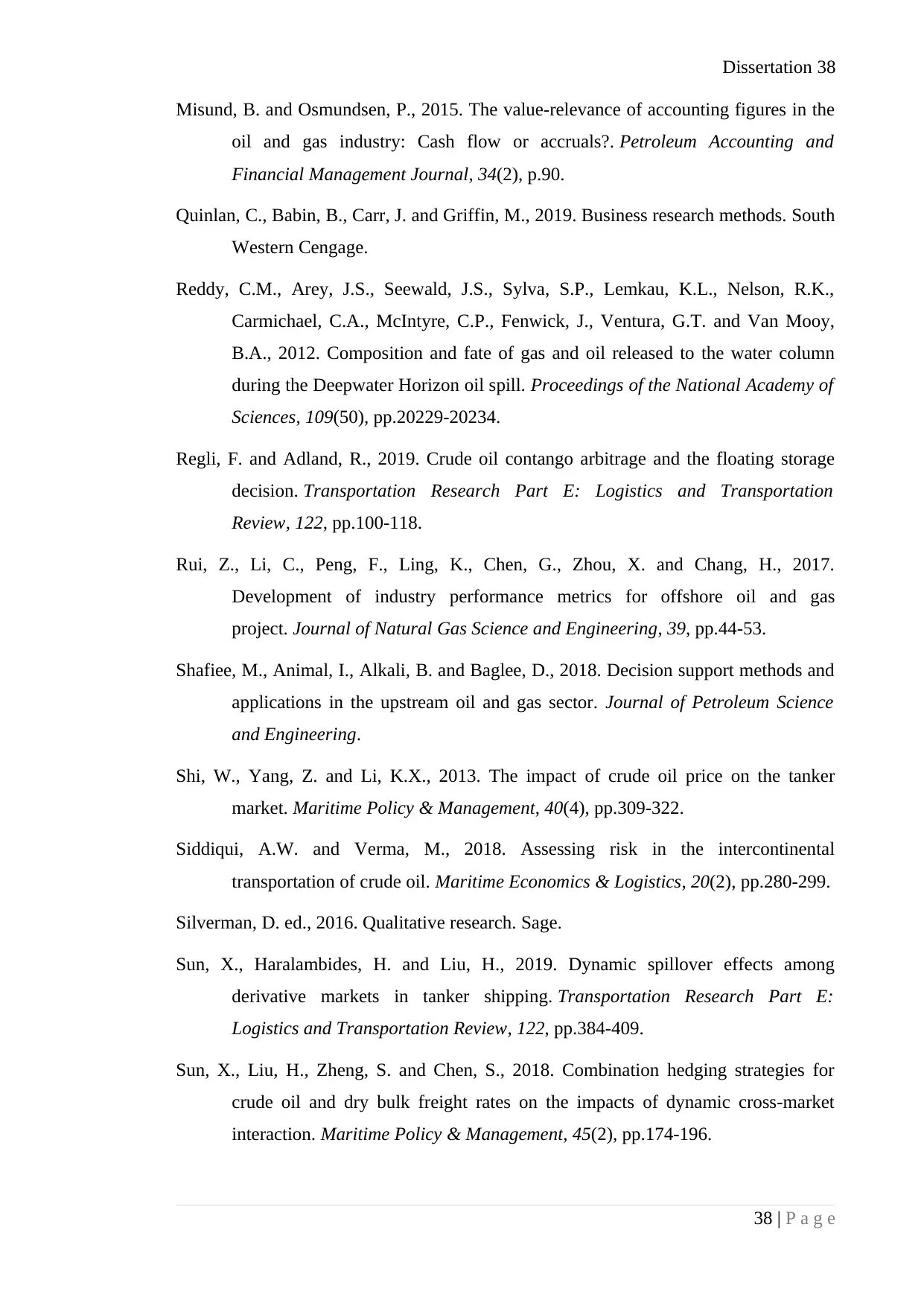
Dissertation 38
Misund, B. and Osmundsen, P., 2015. The value-relevance of accounting figures in the
oil and gas industry: Cash flow or accruals?. Petroleum Accounting and
Financial Management Journal, 34(2), p.90.
Quinlan, C., Babin, B., Carr, J. and Griffin, M., 2019. Business research methods. South
Western Cengage.
Reddy, C.M., Arey, J.S., Seewald, J.S., Sylva, S.P., Lemkau, K.L., Nelson, R.K.,
Carmichael, C.A., McIntyre, C.P., Fenwick, J., Ventura, G.T. and Van Mooy,
B.A., 2012. Composition and fate of gas and oil released to the water column
during the Deepwater Horizon oil spill. Proceedings of the National Academy of
Sciences, 109(50), pp.20229-20234.
Regli, F. and Adland, R., 2019. Crude oil contango arbitrage and the floating storage
decision. Transportation Research Part E: Logistics and Transportation
Review, 122, pp.100-118.
Rui, Z., Li, C., Peng, F., Ling, K., Chen, G., Zhou, X. and Chang, H., 2017.
Development of industry performance metrics for offshore oil and gas
project. Journal of Natural Gas Science and Engineering, 39, pp.44-53.
Shafiee, M., Animal, I., Alkali, B. and Baglee, D., 2018. Decision support methods and
applications in the upstream oil and gas sector. Journal of Petroleum Science
and Engineering.
Shi, W., Yang, Z. and Li, K.X., 2013. The impact of crude oil price on the tanker
market. Maritime Policy & Management, 40(4), pp.309-322.
Siddiqui, A.W. and Verma, M., 2018. Assessing risk in the intercontinental
transportation of crude oil. Maritime Economics & Logistics, 20(2), pp.280-299.
Silverman, D. ed., 2016. Qualitative research. Sage.
Sun, X., Haralambides, H. and Liu, H., 2019. Dynamic spillover effects among
derivative markets in tanker shipping. Transportation Research Part E:
Logistics and Transportation Review, 122, pp.384-409.
Sun, X., Liu, H., Zheng, S. and Chen, S., 2018. Combination hedging strategies for
crude oil and dry bulk freight rates on the impacts of dynamic cross-market
interaction. Maritime Policy & Management, 45(2), pp.174-196.
38 | P a g e
Misund, B. and Osmundsen, P., 2015. The value-relevance of accounting figures in the
oil and gas industry: Cash flow or accruals?. Petroleum Accounting and
Financial Management Journal, 34(2), p.90.
Quinlan, C., Babin, B., Carr, J. and Griffin, M., 2019. Business research methods. South
Western Cengage.
Reddy, C.M., Arey, J.S., Seewald, J.S., Sylva, S.P., Lemkau, K.L., Nelson, R.K.,
Carmichael, C.A., McIntyre, C.P., Fenwick, J., Ventura, G.T. and Van Mooy,
B.A., 2012. Composition and fate of gas and oil released to the water column
during the Deepwater Horizon oil spill. Proceedings of the National Academy of
Sciences, 109(50), pp.20229-20234.
Regli, F. and Adland, R., 2019. Crude oil contango arbitrage and the floating storage
decision. Transportation Research Part E: Logistics and Transportation
Review, 122, pp.100-118.
Rui, Z., Li, C., Peng, F., Ling, K., Chen, G., Zhou, X. and Chang, H., 2017.
Development of industry performance metrics for offshore oil and gas
project. Journal of Natural Gas Science and Engineering, 39, pp.44-53.
Shafiee, M., Animal, I., Alkali, B. and Baglee, D., 2018. Decision support methods and
applications in the upstream oil and gas sector. Journal of Petroleum Science
and Engineering.
Shi, W., Yang, Z. and Li, K.X., 2013. The impact of crude oil price on the tanker
market. Maritime Policy & Management, 40(4), pp.309-322.
Siddiqui, A.W. and Verma, M., 2018. Assessing risk in the intercontinental
transportation of crude oil. Maritime Economics & Logistics, 20(2), pp.280-299.
Silverman, D. ed., 2016. Qualitative research. Sage.
Sun, X., Haralambides, H. and Liu, H., 2019. Dynamic spillover effects among
derivative markets in tanker shipping. Transportation Research Part E:
Logistics and Transportation Review, 122, pp.384-409.
Sun, X., Liu, H., Zheng, S. and Chen, S., 2018. Combination hedging strategies for
crude oil and dry bulk freight rates on the impacts of dynamic cross-market
interaction. Maritime Policy & Management, 45(2), pp.174-196.
38 | P a g e
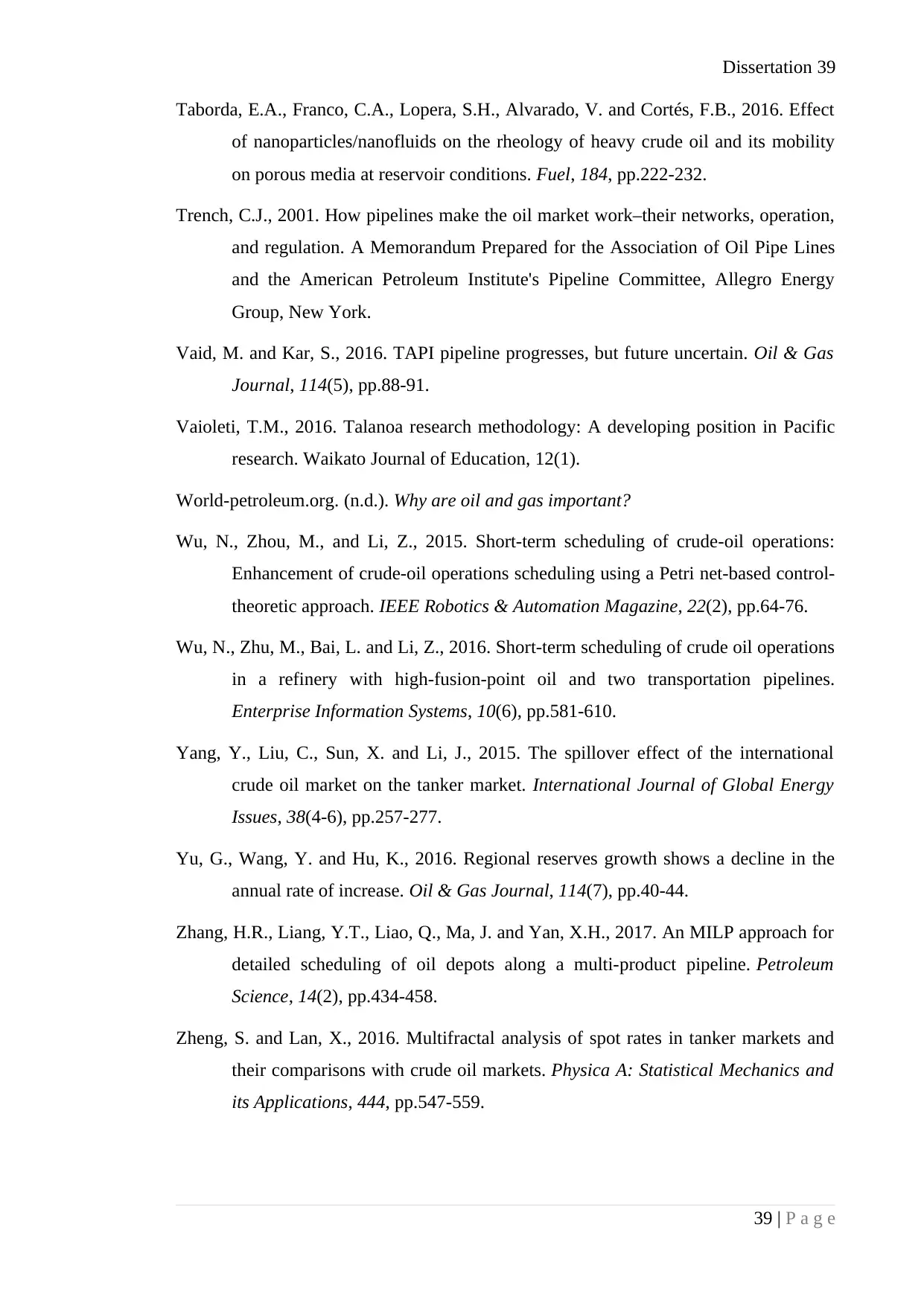
Dissertation 39
Taborda, E.A., Franco, C.A., Lopera, S.H., Alvarado, V. and Cortés, F.B., 2016. Effect
of nanoparticles/nanofluids on the rheology of heavy crude oil and its mobility
on porous media at reservoir conditions. Fuel, 184, pp.222-232.
Trench, C.J., 2001. How pipelines make the oil market work–their networks, operation,
and regulation. A Memorandum Prepared for the Association of Oil Pipe Lines
and the American Petroleum Institute's Pipeline Committee, Allegro Energy
Group, New York.
Vaid, M. and Kar, S., 2016. TAPI pipeline progresses, but future uncertain. Oil & Gas
Journal, 114(5), pp.88-91.
Vaioleti, T.M., 2016. Talanoa research methodology: A developing position in Pacific
research. Waikato Journal of Education, 12(1).
World-petroleum.org. (n.d.). Why are oil and gas important?
Wu, N., Zhou, M., and Li, Z., 2015. Short-term scheduling of crude-oil operations:
Enhancement of crude-oil operations scheduling using a Petri net-based control-
theoretic approach. IEEE Robotics & Automation Magazine, 22(2), pp.64-76.
Wu, N., Zhu, M., Bai, L. and Li, Z., 2016. Short-term scheduling of crude oil operations
in a refinery with high-fusion-point oil and two transportation pipelines.
Enterprise Information Systems, 10(6), pp.581-610.
Yang, Y., Liu, C., Sun, X. and Li, J., 2015. The spillover effect of the international
crude oil market on the tanker market. International Journal of Global Energy
Issues, 38(4-6), pp.257-277.
Yu, G., Wang, Y. and Hu, K., 2016. Regional reserves growth shows a decline in the
annual rate of increase. Oil & Gas Journal, 114(7), pp.40-44.
Zhang, H.R., Liang, Y.T., Liao, Q., Ma, J. and Yan, X.H., 2017. An MILP approach for
detailed scheduling of oil depots along a multi-product pipeline. Petroleum
Science, 14(2), pp.434-458.
Zheng, S. and Lan, X., 2016. Multifractal analysis of spot rates in tanker markets and
their comparisons with crude oil markets. Physica A: Statistical Mechanics and
its Applications, 444, pp.547-559.
39 | P a g e
Taborda, E.A., Franco, C.A., Lopera, S.H., Alvarado, V. and Cortés, F.B., 2016. Effect
of nanoparticles/nanofluids on the rheology of heavy crude oil and its mobility
on porous media at reservoir conditions. Fuel, 184, pp.222-232.
Trench, C.J., 2001. How pipelines make the oil market work–their networks, operation,
and regulation. A Memorandum Prepared for the Association of Oil Pipe Lines
and the American Petroleum Institute's Pipeline Committee, Allegro Energy
Group, New York.
Vaid, M. and Kar, S., 2016. TAPI pipeline progresses, but future uncertain. Oil & Gas
Journal, 114(5), pp.88-91.
Vaioleti, T.M., 2016. Talanoa research methodology: A developing position in Pacific
research. Waikato Journal of Education, 12(1).
World-petroleum.org. (n.d.). Why are oil and gas important?
Wu, N., Zhou, M., and Li, Z., 2015. Short-term scheduling of crude-oil operations:
Enhancement of crude-oil operations scheduling using a Petri net-based control-
theoretic approach. IEEE Robotics & Automation Magazine, 22(2), pp.64-76.
Wu, N., Zhu, M., Bai, L. and Li, Z., 2016. Short-term scheduling of crude oil operations
in a refinery with high-fusion-point oil and two transportation pipelines.
Enterprise Information Systems, 10(6), pp.581-610.
Yang, Y., Liu, C., Sun, X. and Li, J., 2015. The spillover effect of the international
crude oil market on the tanker market. International Journal of Global Energy
Issues, 38(4-6), pp.257-277.
Yu, G., Wang, Y. and Hu, K., 2016. Regional reserves growth shows a decline in the
annual rate of increase. Oil & Gas Journal, 114(7), pp.40-44.
Zhang, H.R., Liang, Y.T., Liao, Q., Ma, J. and Yan, X.H., 2017. An MILP approach for
detailed scheduling of oil depots along a multi-product pipeline. Petroleum
Science, 14(2), pp.434-458.
Zheng, S. and Lan, X., 2016. Multifractal analysis of spot rates in tanker markets and
their comparisons with crude oil markets. Physica A: Statistical Mechanics and
its Applications, 444, pp.547-559.
39 | P a g e

Dissertation 40
40 | P a g e
40 | P a g e
1 out of 40
Related Documents
Your All-in-One AI-Powered Toolkit for Academic Success.
+13062052269
info@desklib.com
Available 24*7 on WhatsApp / Email
![[object Object]](/_next/static/media/star-bottom.7253800d.svg)
Unlock your academic potential
© 2024 | Zucol Services PVT LTD | All rights reserved.





